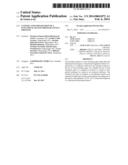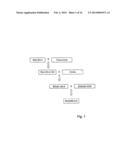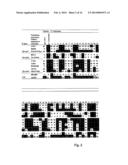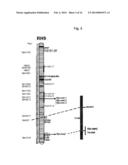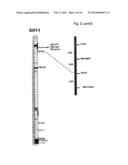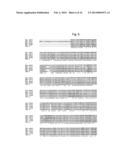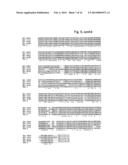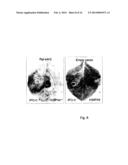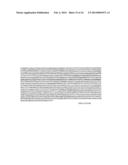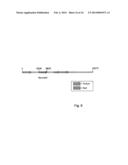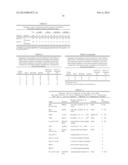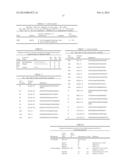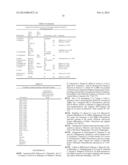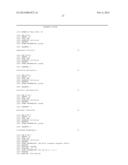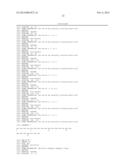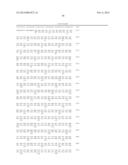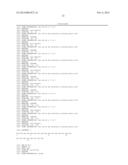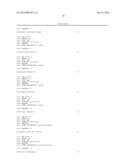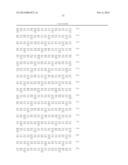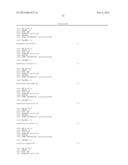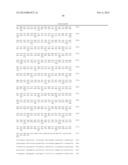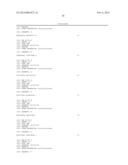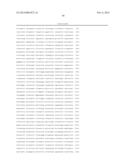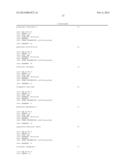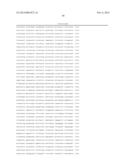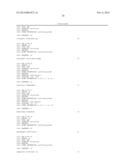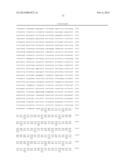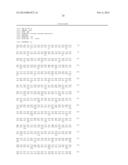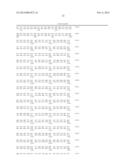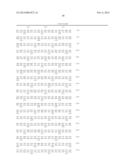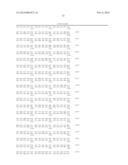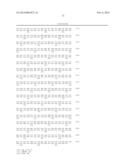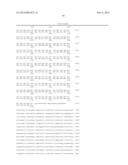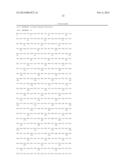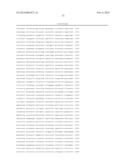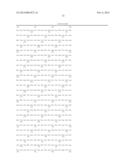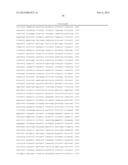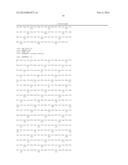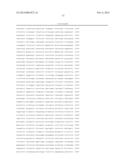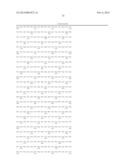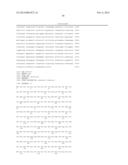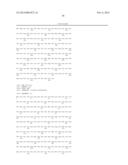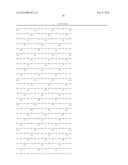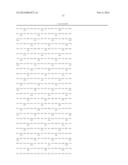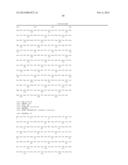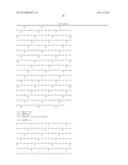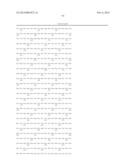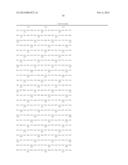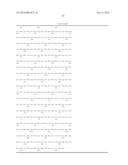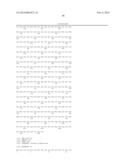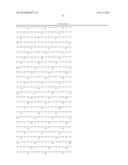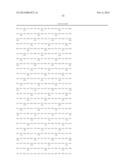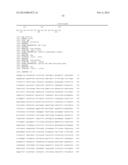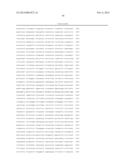Patent application title: CLONING AND EXPLOITATION OF A FUNCTIONAL R-GENE FROM SOLANUM X EDINENSE
Inventors:
Nicolaas Clemens Maria Henricus De Vetten (Groningen, NL)
Estelle Celine Verzaux (Wageningen, NL)
Jacobus Hubertus Vossen (Wageningen, NL)
Hendrik Rietman (Wageningen, NL)
Vivianne Gertruda Antonia Anna Vleeshouwers (Wageningen, NL)
Evert Jacobsen (Wageningen, NL)
Richard Gerardus Franciscus Visser (Bennekom, NL)
Richard Gerardus Franciscus Visser (Bennekom, NL)
Assignees:
COOPERATIE AVEBE U.A.
IPC8 Class: AC07K14415FI
USPC Class:
800260
Class name: Multicellular living organisms and unmodified parts thereof and related processes method of using a plant or plant part in a breeding process which includes a step of sexual hybridization
Publication date: 2014-02-06
Patent application number: 20140041072
Abstract:
The invention relates to a new resistance gene, Rpi-edn2 and functional
homologues or functional fragments thereof isolated from S. x edinense.
Moreover, the invention relates to the use of said resistance gene, for
example the use of said resistance gene in a method to increase or confer
at least partial resistance in a plant to an oomycete infection. The
invention provides an isolated or recombinant nucleic acid sequence
comprising a nucleic acid sequence encoding one of the amino acid
sequences of FIG. 4 or a functional fragment or a functional homologue
thereof.Claims:
1. An isolated or recombinant nucleic acid sequence comprising a nucleic
acid sequence encoding the amino acid sequence Rpi-edn2 of FIG. 4, which
amino acid sequence provides at least partial resistance to an oomycete
infection, or a functional fragment or a functional homologue thereof,
which functional homologue codes for an amino acid sequence more than 80%
identity with the amino acid sequence Rpi-edn2 of FIG. 4.
2. An isolated or recombinant nucleic acid sequence according to claim 1 comprising a nucleic acid sequence as depicted in FIG. 4.
3. A vector comprising a nucleic acid sequence according to claim 1.
4. A host cell comprising a nucleic acid sequence according to claim 1.
5. A plant cell comprising a nucleic acid sequence according to claim 1.
6. A transgenic plant comprising a cell according to claim 5.
7. A part derived from a plant according to claim 6, more preferably wherein said part is a tuber.
8. A protein encoded by an isolated or recombinant nucleic acid according to claim 1 or a functional fragment or a functional homologue thereof, preferably wherein said protein has the amino acid sequence of Rpi-edn2 as depicted in FIG. 4.
9. An antibody that (specifically) binds to the protein of claim 8.
10. A method for providing at least partial resistance or increasing resistance in a plant against an oomycete infection comprising providing a plant or a part thereof through transformation with a nucleic acid according to claim 1.
11. A method according to claim 10, wherein said oomycete comprises Phytophthora, preferably Phytophthora infestans.
12. A method according to claim 10, wherein said plant is also provided with a nucleic acid encoding a resistance protein selected from the group of Rpi-blb1, Rpi-blb2, Rpi-blb3, Rpi-chq1-1, Rpi-chq1-2, Rpi-vnt1, Rpi-chc1, Rpi-edn1, Rpi-edn3, Rpi-mcq1 and combinations thereof.
13. A binding molecule capable of specifically binding to a nucleic acid according to claim 1 or its complementary nucleic acid, preferably wherein said binding molecule is a primer or a probe, said primer selected from the group of Tm2-profiling primers depicted in Table 7, or the group of chromosome 9 primers depicted in Table 5 or specifically binding to the nucleotide sequence as depicted in FIG. 4 or a part thereof.
14. A method for selecting a plant or plant material or progeny thereof for its susceptibility or resistance to an oomycete infection, said method comprising the steps of testing at least part of said plant or plant material or progeny thereof for the presence of absence of a nucleic acid as described in claim 1.
15. A method for breeding a resistant tetraploid plant, comprising a. using gametes of a pentaploid plant that already contains a nucleic acid sequence according to claim 1; in a cross with gametes of a tetraploid plant; and c. selecting the offspring of said cross for the presence of said nucleic acid sequence.
16. A marker for marker assisted selection in plant breeding to obtain resistance against oomycetes, wherein said marker is chosen from the markers selected from the group of Tm2-profiling primers depicted in Table 7, or the group of chromosome 9 primers depicted in Table 5 wherein said marker comprises a part of the nucleotide sequence as depicted in FIG. 4.
17. A host cell comprising a vector according to claim 3, preferably an Agrobacterium cell or a plant cell.
18. A host cell as in claim 4 which is an Agrobacterium cell.
19. A host cell as in claim 4 which is a plant cell.
20. A host cell as in claim 17 which is an Agrobacterium cell.
21. A host cell as in claim 17 which is a plant cell.
22. A plant cell comprising a vector according to claim 3, preferably wherein said plant cell is a cell from a Solanaceae.
23. A plant cell as in claim 22, wherein said plant cell is from Solanum tuberosum.
24. A plant cell as in claim 22, wherein said plant cell is a tetraploid Solanum tuberosum.
25. A method for providing at least partial resistance or increasing resistance in a plant against an oomycete infection comprising providing a plant or a part thereof through transformation with a vector according to claim 3, wherein said plant is of a plant from the Solanaceae family.
26. A method as in claim 25, wherein said plant is Solanum tuberosum.
27. A method for providing at least partial resistance or increasing resistance in a plant against an oomycete infection comprising providing a plant or a part thereof through transformation with a host cell according to claim 4, preferably wherein said plant is a plant from the Solanaceae family.
28. A method as in claim 27, wherein said plant is Solanum tuberosum.
29. A method for providing at least partial resistance or increasing resistance in a plant against an oomycete infection comprising providing said plant with a protein according to claim 8, preferably wherein said plant is a plant from the Solanaceae family.
30. A method as in claim 29, wherein said plant is Solanum tuberosum.
31. A method for selecting a plant or plant material or progeny thereof for its susceptibility or resistance to an oomycete infection, said method comprising the steps of testing at least part of said plant or plant material or progeny thereof for the presence of absence of a nucleic acid, wherein said testing is performed with a primer or a probe according to claim 13.
32. A method as in claim 31, wherein the testing involves detecting the presence of one or more of the markers selected from the group of Tm2-profiling primers depicted in Table 7, or the group of chromosome 9 primers depicted in Table 5 or wherein said marker comprises a part of the nucleotide sequence as depicted in FIG. 4.
Description:
FIELD OF THE INVENTION
[0001] The invention relates to a resistance gene isolated from S. x edinense. Moreover, the invention relates to the use of said resistance gene, for example to clone functional homologues, and the use of said resistance gene(s) in a method to increase or confer at least partial resistance to an oomycete infection in a plant. More in specific the invention provides a resistance gene that is capable of increasing or conferring at least partial resistance to Phytophthora sp. (for example Phytophthora infestans) through genetic engineering techniques or through marker assisted breeding techniques.
BACKGROUND
[0002] Late blight, caused by the oomycete Phytophthora infestans, is one of the most serious diseases in worldwide potato production. It was responsible for the Irish potato famine of the mid-19th century, resulting in the death of one million people. Although a lot of effort has been invested in controlling the pathogen, chemical control of P. infestans is still the main crop management strategy, but environmental safety is becoming more important and the pathogen is sometimes able to evolve resistance to the fungicide treatment. Therefore, introduction of resistance into modern potato varieties is the most durable strategy to control the disease.
[0003] In the last century, Solanum demissum, which is a hexaploid Mexican species, was extensively used in breeding for late-blight resistance in potato. Initially, a series of 11 R genes derived from S. demissum was described. Of these, R1, R2, R3a/b, R6, and R7 have been localized on the genetic maps of potato (Solanum tuberosum). However, these R genes confer pathovar-specific resistance and those that were introgressed into potato varieties, mainly R1, R2, R3, R4, and R10, were quickly overcome by the pathogen. Hence, new sources for resistance are required, and currently, several other wild Solanum species have been reported as being potential sources of resistance, many of which have been genetically characterized (Table 8).
[0004] Recent efforts to identify late blight resistance have focused on major R genes conferring broad-spectrum resistance derived from diverse wild Solanum species. Beside S. demissum, other wild Solanum species such as S. acaule, S. chacoense, S. berthaultii, S. brevidens, S. bulbocastanum, S. microdontum, S. sparsipilum, S. spegazzinii, S., stoloniferum, S. sucrense, S. toralapanum, S. vernei and S. verrucosum have been reported as new sources for resistance to late blight (reviewed by (Jansky, 2000)).
[0005] S. x edinense P. Berthault, a pentaploid (2n=5x=60) potato species from Mexico, is a natural hybrid between the Mexican Solanum demissum and the South American S. tuberosum spp. andigena. The pentaploid S. x edinense had been identified as an interesting source of resistance to P. infestans already in 1908 by Salaman and was included in breeding programs by Brioli in 1914 (Pavek et al. 2001; Toxopeus 1964). It was named after the Edinburgh Botanic Garden (Glendinning 1983), where its hybrid characteristic was first described. It has been used in breeding programs and has revealed good field resistance to P. infestans (Van Soest et al. 1984). Two functional R genes have been cloned from one S. x edinense genotype (edn151-3): Rpi-edn1.1 and Rpi-edn1.2 also known as R2-like (Champouret 2010). They were identified by allele mining of the R2 family. Both are located in the R2 cluster on chromosome 4. Both R genes recognize AVR2 (Champouret 2010; Lokossou et al. 2009) and their resistance is not effective against all P. infestans isolates, including IPO-C (Lokossou et al. 2009).
[0006] To date, not only from this species, but also from other Solanum species late blight R-genes have been cloned, like the allelic genes RB and Rpi-blb1 on chromosome 8 and Rpi-blb2 on chromosome 6 (Table 6) of S. bulbocastanum. Recently, also an Rpi-blb3 resistance gene has been isolated (WO 2008/091153). Also a resistance gene of S. chacoense has been characterized (EP 09170769.5). Although the initial results obtained with RB and Rpi-blb1, -2 and -3 are promising, there is a further need for additional R-genes, especially because allele mining of these genes in S. bulbocastanum genotypes revealed that natural stacking of Rpi-blb1, and -3 in a single genotype occurs at relatively high frequency (Lokossou 2010). S. venturii is another example of the presence of several R genes with different specificities in a single genotype (Pel 2010). Stacking several R genes in a single genotype appears to be a feasible strategy to achieve high level and durable protection against potential pathogens. Pyramiding of R genes is still controversial and it is not known whether it is a durable approach (McDowell et al. 2003; Pink et al. 1999; Pink 2002). The pyramiding of Rpi-ber1 (Rauscher et al. 2006), an R gene with a strong effect, and Rpi-mcd1 (Tan et al. 2008), an R gene with a weak effect, revealed an additive effect on the resistance level (Tan et al. 2010). Observing natural pyramiding of R genes strengthens the idea that plants can benefit from combining individual R genes, even including some with weaker effect (Pink 2002).
SUMMARY OF THE INVENTION
[0007] The invention now relates to an isolated or recombinant nucleic acid sequence comprising a nucleic acid sequence encoding the amino acid sequence Rpi-edn2 of FIG. 4 or a functional fragment or a functional homologue thereof.
[0008] In another embodiment, the invention relates to a vector comprising a nucleic acid sequence according to the invention. Further comprised in the invention is a host cell comprising a nucleic acid according to the invention or a vector according to the invention, wherein said host cell preferably is an Agrobacterium cell or a plant cell.
[0009] In another embodiment, the invention comprises a plant cell comprising a nucleic acid or a vector according to the invention. Said plant cell preferably is a cell from a Solanaceae plant, more preferably Solanum tuberosum, more preferably a tetraploid Solanum tuberosum. Also the invention relates to a transgenic plant comprising such a cell and a part derived from such a plant, more preferably wherein said part is a tuber.
[0010] Also part of the invention is a protein encoded by an isolated or recombinant nucleic acid according to the invention or a functional fragment or a functional homologue thereof, preferably wherein said protein has the amino acid sequence of Rpi-edn2 as depicted in FIG. 4.
[0011] Further disclosed in the invention is an antibody that (specifically) binds to such a protein.
[0012] In yet another embodiment, the invention relates to a method for providing at least partial resistance or increasing resistance in a plant against an oomycete infection comprising providing a plant or a part thereof with a nucleic acid or a vector or a host cell or a protein according to the invention. In such a method said plant preferably is a plant from the Solanaceae family, more preferably Solanum tuberosum. Also preferred is such a method wherein said oomycete comprises Phytophthora, preferably Phytophthora infestans.
[0013] In still a further embodiment, the invention relates to a binding molecule capable of specifically binding to a nucleic acid according to the invention or its complementary nucleic acid, preferably wherein said binding molecule is a primer or a probe.
[0014] In yet a further embodiment the invention comprises a method for selecting a plant or plant material or progeny thereof for its susceptibility or resistance to an oomycete infection, said method comprising the steps of testing at least part of said plant or plant material or progeny thereof for the presence of absence of a nucleic acid according to the invention, preferably wherein said testing is performed with a primer or a probe that specifically binds to said nucleic acid, or where the testing involves detecting the presence of one or more of the markers of Table 5 and 7, or wherein the marker comprises part of the sequence of the Rpi-edn2 gene as depicted in FIG. 4
[0015] Further, the invention relates to a method for breeding a resistant tetraploid plant, comprising
a. using gametes of a polyploid plant that already contains a nucleic acid sequence according to the invention in a cross with gametes of a tetraploid plant; and b. selecting the offspring of said cross for the presence of said nucleic acid sequence.
[0016] In another embodiment, the invention comprises a marker for marker assisted selection in plant breeding to obtain resistance against oomycetes, wherein said marker is chosen from the markers presented in Table 5 and 7, or wherein the marker comprises part of the sequence of the Rpi-edn2 gene as depicted in FIG. 4
LEGENDS TO THE FIGURES
[0017] FIG. 1. Pedigrees of the genotypes used for mapping and cloning of Rpi-edn2.
[0018] FIG. 2. Graphical genotyping of the edn150-4 x cv. Concurrent population. A subset of the F1 individuals is represented. Indicated are the response to the four Phytophthora infestans isolates (90128, IPO-C, PIC99189 and UK7824), the response to effectors AVR2 and AVR4 linked to the resistance to 90128 and PIC99189, respectively, and the genotype score for one or two markers linked to the individual R gene loci. R: resistant (green), S: susceptible (red), Q: unclear phenotype, ab: presence of fragment, aa: absence of fragment, nd: not determined. The grey horizontal lines separate the R gene loci. The F1 individual number 16 contains the three Rpi-edn genes and potentially R10 from cv. Concurrent.
[0019] FIG. 3. Genetic positions of the Rpi-edn2 and Rpi-edn3 genes segregating in edn150-4 x cv. Concurrent population; mapping on chromosome 9 and 11, respectively. The genetic maps are compared to the SH x RH UHD reference genetic map (van Os et al. 2006, Genetics 173:1075-1089) The vertical black bars are representing the known R gene clusters.
[0020] FIG. 4. Nucleotide sequence and corresponding amino acid sequence of Rpi-edn2.
[0021] FIG. 5. Amino acid sequences alignment of Rpi-edn2 and highly homologous proteins.
[0022] FIG. 6. Transient complementation of Phytophthora susceptibility in Nicotiana benthamiana leaves.
[0023] Two days after agro-infiltration with either pDEST32:edn2 or empty binary vector, the leaves were challenged by the inoculation with a zoospore suspension of P. infestans isolate IPO_C (left leaf half) and H30PO4 (right leaf half). Resistance to both isolates co-segregated with the chromosome 9 gene in the F1 population. Typical disease phenotypes developed 6 days after inoculation of control plants that had been agro-infiltrated with binary vector without. Resistance was visible as a HR or XR (eXtreme Resistance) in plants agro-infiltrated with Rpi-edn2.
[0024] FIG. 7. Recognition of PITG--15039 by Rpi-edn2.
[0025] Effector candidates were agroinfiltrated into the right leaf half of N. benthamiana at OD600=0.5 (spot2=Avr3a, 4=PITG--09616, 6=PITG--10540, and 8=PITG--15039). In the left leaf half the same effectors are co-infiltrated with R3a (spot1=Avr3a) or with Rpi-edn2 (spots 3=PITG--09616, 5=PITG--10540, and 7=PITG--15039). Pictures were taken six days after agro-infiltration.
[0026] FIG. 8. Nucleotide sequence of the BAC clone containing the Rpi-edn2 gene. In italics is the mutator transposable element (pos. 195-3310). In highlights is the Rpi-edn2 gene (pos. 5618-8829). The coding sequence locates between position 6140-8731. In bold is a partial Rpi-edn2 homologous gene (pos. 11924-13956). Underlined is a complete Rpi-edn2 homologous gene (pos. 14406-17847). A potential open reading frame is located between positions 15157-17745.
[0027] FIG. 9. Annotation of the Rpi-edn2 genomic region.
[0028] Genes were predicted using FGENESH algorithm. A yellow arrow shows the presence of a mutator transposable element (gene a). Red arrows show the presence of Rpi-edn2 and Rpi-edn2-like sequences (genes b and c). The box in the first red arrow shows the location of the single exon encoding Rpi-edn2 protein. Positions in the BAC insert as depicted in FIG. 8, relative to the beginning of the insert, are indicated by the numbers.
DETAILED DESCRIPTION
[0029] As used herein, the term "plant or part thereof" means any complete or partial plant, single cells and cell tissues such as plant cells that are intact in plants, cell clumps and tissue cultures from which potato plants can be regenerated. Examples of plant parts include, but are not limited to, single cells and tissues from pollen, ovules, leaves, embryos, roots, root tips, anthers, flowers, fruits, stems shoots, tubers, including potato tubers for consumption or `seed tubers` for cultivation or clonal propagation, and seeds; as well as pollen, ovules, leaves, embryos, roots, root tips, anthers, flowers, fruits, stems, shoots, scions, rootstocks, seeds, protoplasts, calli, and the like.
[0030] As used herein, the term "population" means a genetically heterogeneous collection of plants sharing a common genetic derivation.
[0031] As used herein, the term "variety" is as defined in the UPOV treaty and refers to any plant grouping within a single botanical taxon of the lowest known rank, which grouping can be: (a) defined by the expression of the characteristics that results from a given genotype or combination of genotypes, (b) distinguished from any other plant grouping by the expression of at least one of the said characteristics, and (c) considered as a unit with regard to its suitability for being propagated unchanged.
[0032] The term "cultivar" (for cultivated variety) as used herein is defined as a variety that is not normally found in nature but that has been cultivated by humans, i.e. having a biological status other than a "wild" status, which "wild" status indicates the original non-cultivated, or natural state of a plant or accession. The term "cultivar" specifically relates to a potato plant having a ploidy level that is tetraploid. The term "cultivar" further includes, but is not limited to, semi-natural, semi-wild, weedy, traditional cultivar, landrace, breeding material, research material, breeder's line, synthetic population, hybrid, founder stock/base population, inbred line (parent of hybrid cultivar), segregating population, mutant/genetic stock, and advanced/improved cultivar.
[0033] As used herein, "crossing" means the fertilization of female plants (or gametes) by male plants (or gametes). The term "gamete" refers to the haploid or diploid reproductive cell (egg or sperm) produced in plants by meiosis, or by first or second restitution, or double reduction from a gametophyte and involved in sexual reproduction, during which two gametes of opposite sex fuse to form a diploid or polyploid zygote. The term generally includes reference to a pollen (including the sperm cell) and an ovule (including the ovum). "Crossing" therefore generally refers to the fertilization of ovules of one individual with pollen from another individual, whereas "selfing" refers to the fertilization of ovules of an individual with pollen from genetically the same individual.
[0034] The term "backcrossing" as used herein means the process wherein the plant resulting from a cross between two parental lines is crossed with one of its parental lines, wherein the parental line used in the backcross is referred to as the recurrent parent. Repeated backcrossing results in the genome becoming more and more similar to the recurrent parent, as far as this can be achieved given the level of homo- or heterozygosity of said parent.
[0035] As used herein, "selfing" is defined as refers to the process of self-fertilization wherein an individual is pollinated or fertilized with its own pollen.
[0036] The term "marker" as used herein means any indicator that is used in methods for inferring differences in characteristics of genomic sequences. Examples of such indicators are restriction fragment length polymorphism (RFLP) markers, amplified fragment length polymorphism (AFLP) markers, single nucleotide polymorphisms (SNPs), insertion mutations, microsatellite markers (SSRs), sequence-characterized amplified regions (SCARs), cleaved amplified polymorphic sequence (CAPS) markers or isozyme markers or combinations of the markers described herein which defines a specific genetic and chromosomal location.
[0037] As used herein, "locus" is defined as the genetic or physical position that a given gene occupies on a chromosome of a plant.
[0038] The term "allele(s)" as used herein means any of one or more alternative forms of a gene, all of which alleles relate to the presence or absence of a particular phenotypic trait or characteristic in a plant. In a diploid cell or organism, the two alleles of a given gene occupy corresponding loci on a pair of homologous chromosomes. It is in some instance more accurate to refer to "haplotypes" (i.e. an allele of a chromosomal segment) in stead of "allele", however, in these instances, the term "allele" should be understood to comprise the term "haplotype".
[0039] The term "heterozygous" as used herein, and confined to diploids, means a genetic condition existing when different alleles reside at corresponding loci on homologous chromosomes.
[0040] As used herein, and confined to diploids, "homozygous" is defined as a genetic condition existing when identical alleles reside at corresponding loci on homologous chromosomes.
[0041] As used herein, and confined to tetraploids, the term "nulliplex", "simplex", "duplex", "triplex" and "quadruplex", is defined as a genetic condition existing when a specific allele at a corresponding locus on corresponding homologous chromosomes is present 0, 1, 2, 3 or 4 times, respectively. At the tetraploid level the phenotypic effect associated with a recessive allele is only observed when the allele is present in quadruplex condition, whereas the phenotypic effect associated with a dominant allele is already observed when the allele is present in a simplex or higher condition.
[0042] The terms "haploid", "diploid", "tetraploid" and "pentaploid" as used herein are defined as having respectively one, two, four and five pairs of each chromosome in each cell (excluding reproductive cells).
[0043] The term "haplotype" as used herein means a combination of alleles at multiple loci that are transmitted together on the same chromosome. This includes haplotypes referring to as few as two loci, and haplotypes referring to an entire chromosome depending on the number of recombination events that have occurred between a given set of loci.
[0044] As used herein, the term "infer" or "inferring", when used in reference to assessing the presence of the fungal resistance as related to the expression of the Rpi-edn2 gene, means drawing a conclusion about the presence of said gene in a plant or part thereof using a process of analyzing individually or in combination nucleotide occurrence(s) of said gene in a nucleic acid sample of the plant or part thereof. As disclosed herein, the nucleotide occurrence(s) can be identified directly by examining the qualitative differences or quantitative differences in expression levels of nucleic acid molecules, or indirectly by examining (the expression level of the Rpi-edn2 protein.
[0045] The term "primer" as used herein refers to an oligonucleotide which is capable of annealing to the amplification target allowing a DNA polymerase to attach thereby serving as a point of initiation of DNA synthesis when placed under conditions in which synthesis of primer extension product which is complementary to a nucleic acid strand is induced, i.e., in the presence of nucleotides and an agent for polymerization such as DNA polymerase and at a suitable temperature and pH. The (amplification) primer is preferably single stranded for maximum efficiency in amplification. Preferably, the primer is an oligodeoxyribonucleotide. The primer must be sufficiently long to prime the synthesis of extension products in the presence of the agent for polymerization. The exact lengths of the primers will depend on many factors, including temperature and source of primer. A "pair of bi-directional primers" or "primer pair" as used herein refers to one forward and one reverse primer as commonly used in the art of DNA amplification such as in PCR amplification.
[0046] As used herein, the term "probe" means a single-stranded oligonucleotide sequence that will recognize and form a hydrogen-bonded duplex with a complementary sequence in a target nucleic acid sequence analyte or its cDNA derivative.
[0047] The terms "stringency" or "stringent hybridization conditions" refer to hybridization conditions that affect the stability of hybrids, e.g., temperature, salt concentration, pH, formamide concentration and the like. These conditions are empirically optimised to maximize specific binding and minimize non-specific binding of primer or probe to its target nucleic acid sequence. The terms as used include reference to conditions under which a probe or primer will hybridise to its target sequence, to a detectably greater degree than other sequences (e.g. at least 2-fold over background). Stringent conditions are sequence dependent and will be different in different circumstances. Longer sequences hybridise specifically at higher temperatures. Generally, stringent conditions are selected to be about 5° C. lower than the thermal melting point (Tm) for the specific sequence at a defined ionic strength and pH. The Tm is the temperature (under defined ionic strength and pH) at which 50% of a complementary target sequence hybridises to a perfectly matched probe or primer.
[0048] Typically, stringent conditions will be those in which the salt concentration is less than about 1.0 M Na+ ion, typically about 0.01 to 1.0 M Na+ ion concentration (or other salts) at pH 7.0 to 8.3 and the temperature is at least about 30° C. for short probes or primers (e.g. 10 to 50 nucleotides) and at least about 60° C. for long probes or primers (e.g. greater than 50 nucleotides). Stringent conditions may also be achieved with the addition of destabilizing agents such as formamide. Exemplary low stringent conditions or "conditions of reduced stringency" include hybridization with a buffer solution of 30% formamide, 1 M NaCl, 1% SDS at 37° C. and a wash in 2×SSC at 40° C. Exemplary high stringency conditions include hybridization in 50% formamide, 1 M NaCl, 1% SDS at 37° C., and a wash in 0.1×SSC at 60° C. Hybridization procedures are well known in the art and are described in e.g. Ausubel, F. M., Brent, R., Kingston, R. E., Moore, D. D., Seidman, J. G., Smith, J. A., Struhl, K. eds. (1998) Current protocols in molecular biology. V. B. Chanda, series ed. New York: John Wiley & Sons.
[0049] The present invention describes the cloning of the Rpi-edn2 gene. Rpi-edn2 was mapped to an R gene cluster on chromosome 9 of S. x edinense. The gene contains three domains that are common to other resistance genes, the CC, NBS and LRR domain.
[0050] To date, five principal classes of R-genes have been identified, based upon conserved protein domains (for review see Martin G B, Bogdanove A J, Sessa G, Annu Rev Plant Biol 2003, 54:23-61). The most abundant class are the cytoplasmic nucleotide-binding site-leucine-rich repeat (NBS-LRR) proteins (Rommens C M, Kishore G M, Curr Opin Biotechnol 2000, 11:120-125). The other classes comprise proteins with extracytoplasmic LRRs (eLRRs) anchored to a transmembrane (TM) domain (receptor-like proteins [RLPs]), cytoplasmic serine-threonine (Ser/Thr) receptor-like kinases (RLKs) with extracellular LRRs (such as disclosed in WO 2004/007712), cytoplasmic Ser/Thr kinases without LRRs, and proteins with a membrane anchor fused to a coiled coil (CC) domain. The common NBS-LRR-encoding proteins currently include over 20 functionally proven R-genes from diverse plant species (Van Der Biezen E A, Freddie C T, Kahn K, Parker J E, Jones J D, Plant J 2002, 29:439-451). Studies have focused on this family because its only known function to date is in disease resistance (Meyers B C, Kaushik S, Nandety R S, Curr Opin Plant Biol 2005, 8:129-134). Gene products are composed of a conserved central NBS and variable length C-terminal LRR domain of 10 to 40 short LRR motifs (Cannon S B, Zhu H, Baumgarten A M, Spangler R, May G, Cook D R, Young N D, J Mol Evol 2002, 54:548-562). The NBS domain is important for ATP binding and hydrolysis and is believed to be involved in signal transduction, triggered by the presence of the pathogen (van Der Biezen E A, Jones, Curr Biol 1998, 8:R226-R227; Tameling W I, Elzing a S D, Darmin P S, Vossen J H, Takken F L, Haring M A, Cornelissen B J, Plant Cell 2002, 14:2929-2939). The LRR domain is likely to be involved in protein-protein interactions, recognizing pathogen elicitor molecules (Young N D, Curr Opin Plant Biol 2000, 3:285-290. A high mutation rate in the LRR contributes to genetic variability, necessary for specific recognition of diverse pathogens (Michelmore R W, Meyers B C, Genome Res 1998, 8:1113-1. Two subfamilies exist in NBS-LRR R proteins based upon N-terminal motifs. The TIR NBS subfamily R proteins display homology between the N-terminal amino acid motif and the receptor domain in Drosophila Toll and basal mammalian Interleukin (IL) 1 immunity factors in animals (Parker J E, Coleman M J, Szabo V, Frost L N, Schmidt R, van Der Biezen E A, Moores T, Dean C, Daniels M J, Jones J D, Plant Cell 1997, 9:879-894. Non-TIR NBS subfamily R proteins can contain an N-terminal coiled-coil (CC) motif, a subset of which code for a leucine zipper sequence (LZ). TIR subfamily NBS-LRR proteins appear to be restricted to dicotyledons.
[0051] A coiled-coil (CC) domain is located in the N-terminal parts of the Rpi-edn2 protein between amino acids 1 and 153 (amino acid sequence depicted in FIG. 4). In the first 153 residues 3 pairs of putative heptad motifs composed of hydrophobic residues could be recognized in Rpi-edn2. A NB-ARC (nucleotide-binding site, apoptosis, R gene products, CED-4) domain could be recognized in the amino acid stretch between residues 153 and 444 (Ploop, Kinase-2, GLPL) (Van der Biezen and Jones 1998). The C terminal half of Rpi-edn2 comprises a series of 15 LRR motifs of irregular size that can be aligned according to the consensus sequence LxxLxxLxxLxLxxC/N/Sx(x)LxxLPxx (where x is any amino acid, and L is selected from the group of Leucine, Isoleucine or Valine (L, I or V) (McHale et al. 2006).
[0052] At the protein level, Rpi-edn2 shares 80% amino acid identity with Rpi-mcq1.1, 77% with Rpi-mcq1.2. Lower percentage homology was found with Rpi-vnt1 (73%) and Tm-22, a tomato resistance gene against Tomato Mosaic virus, sharing 73% and 72% identity, respectively.
[0053] In a first embodiment, the invention provides an isolated or recombinant nucleic acid sequence comprising a nucleic acid sequence encoding the amino acid sequence Rpi-edn2 as presented in FIG. 4 or a functional fragment or a functional homologue thereof, i.e. a functional fragment or a functional homologue of the amino sequence as shown in FIG. 4.
[0054] The term "nucleic acid" means a single or double stranded DNA or RNA molecule.
[0055] Also included are the complementary sequences of the herein described nucleotide sequences.
[0056] The term "functional fragment thereof" is typically used to refer to a fragment of the Rpi-edn2 protein or the nucleic acid sequence encoding therefore, that is capable of providing at least partial resistance or increasing resistance in a plant of the Solanaceae family against an oomycete infection, more specifically against P. infestans, more specifically against isolate IPO-C. Such a fragment is, for example, a truncated version of the Rpi-edn2 protein. A truncated version/fragment of the Rpi-edn2 protein is a fragment that is smaller than 863 amino acids and preferably comprises (part of) the NB-ARC and the LRR domains and/or the N-terminal CC domain of the Rpi-edn2 protein.
[0057] The term "functional homologue" is typically used to refer to a protein sequence or the nucleic acid sequence encoding for such a protein that is highly homologous to or has a high identity with the herein described Rpi-edn2 protein or nucleic acids, which (encoded) protein is capable of providing at least partial resistance or increasing resistance in a plant of the Solanaceae family against an oomycete infection, more specifically against P. infestans, more specifically against isolate IPO-C. Included are artificial changes or amino acid residue substitutions that at least partly maintain the effect of the Rpi-edn2 protein. For example, certain amino acid residues can conventionally be replaced by others of comparable nature, e.g. a basic residue by another basic residue, an acidic residue by another acidic residue, a hydrophobic residue by another hydrophobic residue, and so on. Examples of hydrophobic amino acids are valine, leucine and isoleucine. Phenylalanine, tyrosine and tryptophan are examples of amino acids with an aromatic side chain and cysteine as well as methionine are examples of amino acids with sulphur-containing side chains. Serine and threonine contain aliphatic hydroxyl groups and are considered to be hydrophilic. Aspartic acid and glutamic acid are examples of amino acids with an acidic side chain. In short, the term "functional homologue thereof" includes variants of the Rpi-edn2 protein in which amino acids have been inserted, replaced or deleted and which at least partly maintain the effect of the Rpi-edn2 protein (i.e. at least partly providing or increasing resistance in a plant of the Solanaceae family against an oomycete infection, more specifically against P. infestans, more specifically against isolate IPO-C). Preferred variants are variants which only contain conventional amino acid replacements as described above. Also included in the term "functional homologue thereof" are homologous sequences. Preferably, such a homologue has more than 80% identity on the amino acid level. More preferably, the amino acid has an identity of at least 85 or 90%. Even more preferred are amino acids that have an identity of 91, 92, 93, 94 or 95%. Most preferred are amino acids that have an identity of 96, 97, 98 or 99% with the amino acid sequence of Rpi-edn2. Homologous proteins according to the invention have a higher degree of identity with the Rpi-edn2 sequence as the sequences aligned with those proteins in FIG. 5.
[0058] A functional homologous nucleic acid sequence is a nucleic acid sequence that encodes a functional homologous protein as described above.
[0059] Homology and/or identity percentages can for example be determined by using computer programs such as BLAST, ClustalW or ClustalX.
[0060] Many nucleic acid sequences code for a protein that is 100% identical to the Rpi-edn2 protein as presented in FIG. 4. This is because nucleotides in a nucleotide triplet may vary without changing the corresponding amino acid (wobble in the nucleotide triplets). Thus, without having an effect on the amino acid sequence of a protein the nucleotide sequence coding for this protein can be varied. However, in a preferred embodiment, the invention provides an isolated or recombinant nucleic acid sequence as depicted in FIG. 4. In a preferred embodiment, the invention provides an isolated, synthetic, or recombinant nucleic acid that represents the coding sequence (CDS) of the Rpi-edn2 protein, i.e. nucleotides 1-2589 of FIG. 4 or a functional fragment or a functional homologue thereof.
[0061] Fragments as well as homologues of the herein described Rpi-edn2 gene and protein can for example be tested for their functionality by using an Agrobacterium tumefaciens transient transformation assays (agro-infiltration) and/or by using a detached leaf assay.
[0062] Agro-infiltration forms a functional screen for testing candidate genes, whereby 4 week old wild type Nicotiana benthamiana plants are infiltrated with Agrobacterium strains containing the candidate Rpi-edn2 homologues or nucleotide sequences coding therefore. The infiltrated leaves are subsequently challenged one or several (maximum 3) days after infiltration with a P. infestans strain that is virulent on N. benthamiana, for example IPO-C or 90128, in detached leaf assays. This system is equally suitable for testing candidate homologous fragments of Rpi-edn2.
[0063] Transient gene expression, as is achieved through agro-infiltration, is a fast, flexible and reproducible approach to high-level expression of useful proteins. In plants, recombinant strains of Agrobacterium tumefaciens can be used for transient expression of genes that have been inserted into the T-DNA region of the bacterial Ti plasmid. A bacterial culture is infiltrated into leaves, and upon T-DNA transfer, there is ectopic expression of the gene of interest in the plant cells. However, the utility of the system is limited because the ectopic RNA expression ceases after 2-3 days. It is shown that post-transcriptional gene silencing (PTGS) is a major cause for this lack of efficiency. A system based on co-expression of a viral-encoded suppressor of gene silencing, the p19 protein of tomato bushy stunt virus (TBSV), prevents the onset of PTGS in the infiltrated tissues and allows high level of transient expression. Expression of a range of proteins was enhanced 50-fold or more in the presence of p19 so that protein purification could be achieved from as little as 100 mg of infiltrated leaf material. Although it is clear that the use of p19 has advantages, an agro-infiltration without p19 can also be used to test the functionality of candidate fragments and functional homologues.
[0064] Alternatively, each candidate gene (for example being a fragment or homologue) construct is targeted for transformation to a susceptible potato cultivar, for example Desiree. Primary transformants are challenged in detached leaf assays using for example isolates H30PO4, IPO-C, CA65, USA618 or 90128. Transformants that are resistant to these isolates, especially against IPO-C, harbour for example functional fragments or homologues of Rpi-edn2.
[0065] In yet another embodiment, the invention provides a vector comprising a nucleic acid as provided herein, i.e. a nucleic acid capable of providing at least partial resistance or increasing resistance in a plant of the Solanaceae family against an oomycete infection. More particularly, the invention provides a vector comprising an isolated, synthetic or recombinant nucleic acid sequence comprising a nucleic acid sequence encoding the amino acid sequence Rpi-edn2 of FIG. 4 or a functional fragment or a functional homologue thereof. The invention also provides a vector comprising such a nucleic acid sequence. Alternatively, such a vector comprises both nucleotide sequences encoding the Rpi-edn2 protein.
[0066] Examples of a suitable vector are pBeloBACII, pBINplus, pKGW-MG or any commercially available cloning vector.
[0067] As will be outlined below there are multiple ways in which a nucleic acid of the invention can be transferred to a plant. One suitable means of transfer is mediated by Agrobacterium in which the nucleic acid to be transferred is part of a binary vector and hence it is preferred that the above described vector is a binary vector. Another suitable means is by crossing a plant which contains the gene encoding Rpi-edn2 to a plant that does not contain the gene and to identify those progeny of the cross that have inherited the Rpi-edn2 gene.
[0068] The invention further provides a host cell comprising a nucleic acid as described herein or a vector as described herein. Examples of a preferred host cell are an E. coli cell suitable for BAC clones (e.g. DH10B) or an Agrobacterium (host) cell. In another embodiment, said host cell comprises a plant cell. A preferred plant cell is a cell derived from a member of the Solanaceae family and even more preferred said plant cell comprises a cell from Solanum tuberosum, Solanum lycopersicum, formerly known as Lycopersicon esculentum, pepper and eggplant. From such a cell, a transgenic or genetically modified plant (for example a potato or tomato plant) can be obtained by methods known by the skilled person (for example regeneration protocols).
[0069] The invention further provides a leaf, tuber, fruit or seed or part or progeny of a genetically modified plant as described herein.
[0070] In yet another embodiment, the invention provides a protein encoded by the herein described isolated or recombinant nucleic acid or a functional fragment or a functional homologue thereof. In a preferred embodiment, the invention provides a protein encoded by a nucleic acid sequence as depicted in FIG. 4. In yet another preferred embodiment, the invention provides a protein comprising the amino acid sequence of FIG. 4 or a functional fragment or a functional homologue thereof.
[0071] The herein described Rpi-edn2 protein comprises 863 amino acids. Rpi-edn2 shares the highest homology with Rpi-mcq1.1 (80%) and Rpi-mcq1.2 (77%), R genes from S. mochiquense. However, as is shown in Table 6, the Rpi-edn2 protein of the present invention differs from these highly homologous proteins by the fact that it provides resistance towards a different spectrum of Phytophthora isolates. Rpi-edn2, like Rpi-vnt1, Tm-22 and Rpi-mcq1.1, is a member of the large family of CC-NBS-LRR resistance genes. The reference genes Tm-22, Rpi-vnt1 and Rpi-mcq1.1 can be said to be grouped in a so-called Tm-22 family subgroup, of which Rpi-edn2 forms a member. However, on basis of the sequence homology, Rpi-edn2 can be considered to form a new subclass within this Tm-22 family.
[0072] As already described, a functional fragment or a functional homologue thereof of Rpi-edn2 is a fragment or homologue that is capable of providing at least partial resistance or increasing resistance in a plant of the Solanaceae family against an oomycete infection.
[0073] Means to test the functionality of a functional fragment or a functional homologue of Rpi-edn2 have been provided above.
[0074] Based on the herein described nucleic acid sequences, the invention also provides probes and primers (i.e. oligonucleotide sequences complementary to the (complementary) DNA strand as described in FIG. 4). Probes are for example useful in Southern or northern analysis and primers are for example useful in PCR analysis. Primers based on the herein described nucleic acid sequence are very useful to assist plant breeders active in the field of classical breeding and/or breeding by genetic modification of the nucleic acid content of a plant (preferably said plant is a Solanum tuberosum, Solanum lycopersicum, formerly known as Lycopersicon esculentum), pepper or eggplant in selecting a plant that is capable of expressing for example Rpi-edn2.
[0075] Hence, in a further embodiment, the invention provides a binding molecule capable of binding to a nucleic acid as described herein or its complementary nucleic acid. In a preferred embodiment, said binding molecule is a primer or a probe. As mentioned, such a binding molecule is very useful for plant breeders and hence the invention further provides a method for selecting a plant or plant material or progeny thereof for its susceptibility or resistance to an oomycete infection. Preferably, the nucleic acid of a plant to be tested is isolated from said plant and the obtained isolated nucleic acid is brought in contact with one or multiple (preferably different) binding molecule(s). One can for example use a PCR analysis to test plants for the presence of absence of Rpi-edn2 in the plant genome. Such a method would be especially preferable in marker-free transformation protocols, such as described in WO 03/010319.
[0076] The herein described Rpi-edn2 protein can also be used to elicit antibodies by means known to the skilled person. The invention thus also provides an antibody that (specifically) binds to the protein(s) encoded by the herein described isolated or recombinant nucleic acid (for example the nucleic acid sequence of FIG. 4 or an antibody that (specifically) binds to a protein as depicted in FIG. 4 or a functional fragment or a functional homologue thereof. Such an antibody is for example useful in protein analysis methods such as Western blotting or ELISA, and hence can be used in selecting plants that successfully express the Rpi-edn2 gene.
[0077] Based on the herein provided nucleic acid sequence, the invention also provides the means to introduce or increase resistance against an oomycete infection in a plant. The invention therefore also provides a method for providing at least partial resistance or increasing resistance in a plant against an oomycete infection comprising providing a plant or a part thereof with:
[0078] an isolated or recombinant nucleic acid sequence comprising a nucleic acid sequence encoding the Rpi-edn2 amino acid sequence of FIG. 4 or a functional fragment or a functional homologue thereof, or
[0079] a vector comprising the herein described nucleic acid sequences, or
[0080] a host cell as described herein.
[0081] Such a method for providing at least partial resistance or increasing resistance in a plant against an oomycete infection may be based on classical breeding, departing from a parent plant that already contains the Rpi-edn2 gene, or it involves the transfer of DNA into a plant, i.e., involves a method for transforming a plant cell comprising providing said plant cell with one or more nucleic acid sequences as described herein or a vector as described herein or a host cell as described herein.
[0082] There are multiple ways in which a recombinant nucleic acid can be transferred to a plant cell, for example Agrobacterium mediated transformation. However, besides by Agrobacterium infection, there are other means to effectively deliver DNA to recipient plant cells when one wishes to practice the invention. Suitable methods for delivering DNA to plant cells are believed to include virtually any method by which DNA can be introduced into a cell, such as by direct delivery of DNA such as by PEG-mediated transformation of protoplasts, by desiccation/inhibition-mediated DNA uptake (Potrykus et al., Mol. Gen. Genet., 199:183-188, 1985), by electroporation (U.S. Pat. No. 5,384,253), by agitation with silicon carbide fibers (Kaeppler et al., 1990; U.S. Pat. No. 5,302,523; and U.S. Pat. No. 5,464,765), and by acceleration of DNA coated particles (U.S. Pat. No. 5,550,318; U.S. Pat. No. 5,538,877; and U.S. Pat. No. 5,538,880). Through the application of techniques such as these, cells from virtually any plant species may be stably transformed, and these cells may be developed into transgenic plants.
[0083] In case Agrobacterium mediated transfer is used, it is preferred to use a substantially virulent Agrobacterium such as A. tumefaciens, as exemplified by strain A281 or a strain derived thereof or another virulent strain available in the art. These Agrobacterium strains carry a DNA region originating from the virulence region of the Ti plasmid pTiBo542, which coordinates the processing of the T-DNA and its transfer into plant cells. Agrobacterium-based plant transformation is well known in the art (as e.g. described in, for example by Komari, T. et al.: Plant Transformation Technology: Agrobacterium-Mediated Transformation, in: Handbook of Plant Biotechnology, Eds. Christou, P. and Klee, H., John Wiley & Sons, Ltd, Chichester, UK 2004, pp. 233-262). Preferably a marker-free transformation protocol is used, such as described in WO 03/010319.
[0084] In a preferred embodiment, the target plant is transformed with additional resistance genes, a phenomenon known under the name of "gene stacking". As is explained and shown in the experimental part, the presence of multiple resistance genes can enhance the resistance of a plant against infection because firstly the genes can complement each other with respect to resistance to various isolates or pathotypes of the infectious agent, and secondly, triggering more than one resistance mechanism (that by itself would not lead to a full resistance) can lead to a substantial increase of the resistance reactions in the host plant, which could well be sufficient to reach full resistance.
[0085] Alternatively, the nucleic acid of the Rpi-edn2 gene, and optionally other resistance genes, like Rpi-mcq1.1, Rpi-mcq1.2, Rpi-vnt1, Rpi-chc1, Rpi-av11.1, Rpi-av11.2, Rpi-blb1, Rpi-blb2, Rpi-blb3, and many others, may be introduced into a plant by crossing. Such a crossing scheme starts off with the selection of a suitable parent plant. This may for instance be an original Solanum x edinense genotype (such as accession GLKS 25492, GLKS 25493 and GLKS 25494), or a plant that has obtained the desired nucleic acid by genetic engineering as described above.
[0086] Any suitable method known in the art for crossing selected plants may be applied in the method according to the invention. This includes both in vivo and in vitro methods. A person skilled in the art will appreciate that in vitro techniques such as protoplast fusion or embryo rescue may be applied when deemed suitable.
[0087] Selected plants that are used for crossing purposes in the methods according to the invention may have any type of ploidy. For example, selected plants may be haploid, diploid, triploid, tetraploid or pentaploid.
[0088] Methods for crossing a polyploid plant with a tetraploid plant are well known in the art and can be readily applied by a person skilled in the art. For example, S. x edinense has been used for a long time in breeding programs especially for its good field resistance to P. infestans (van Soest, 1984). Crosses of the pentaploid S. x edinense with a tetraploid variety (e.g. Concurrent) yield tetraploid progeny. For potatoes a resistant tetraploid plant is preferred, since tetraploid plants are known to have higher yields of tubers.
[0089] Since the resistance characteristic has appeared to be a dominant trait, it is sufficient if only one allele with the functional gene is present.
[0090] Preferably, selected plants are crossed with each other using classical in vivo crossing methods that comprise one or more crossing steps including selfing. By applying such classical crossing steps characteristics of both the parents can be combined in the progeny. For example, a plant that provides a high yield can be crossed with a plant that contains large amounts of a certain nutrient. Such a crossing would provide progeny comprising both characteristics, i.e. plants that not only comprise large amounts of the nutrient but also provide high yields.
[0091] When applying backcrossing, F1 progeny is crossed with one of its high-yielding parents P to ensure that the characteristics of the F2 progeny resemble those of the high-yielding parent. For example, a selected diploid potato with oomycete resistance is made tetraploid by using colchicine and then crossed with a selected high-yielding tetraploid potato cultivar, with the purpose of ultimately providing a high-yielding tetraploid progeny having oomycete resistance. Also selfing may be applied. Selected plants, either parent or progeny, are then crossed with themselves to produce inbred varieties for breeding. For example, selected specimens from the above mentioned F1 progeny are crossed with themselves to provide an F2 progeny from which specimens can be selected that have an increased level of resistance.
[0092] After transfer of a nucleic acid into a plant or plant cell, it must be determined which plants or plant cells have been provided with said nucleic acid. When selecting and crossing a parental genotype in a method according to the invention, a marker is used to assist selection in at least one selection step. It is known in the art that markers, indicative for a certain trait or condition, can be found in vivo and in vitro at different biological levels. For example, markers can be found at peptide level or at gene level. At gene level, a marker can be detected at RNA level or DNA level. Preferably, in the present invention the presence of such a marker is detected at DNA level. Alternatively, proper expression of the Rpi-edn2 protein can be assessed in plant parts by transforming an immunoassay with an antibody that specifically binds the protein. Next to the primers and probes according to the invention, use can also be made of specific markers that are to be found in the vicinity of the coding sequence. Such markers are indicated in the experimental part below and comprise the Tm2-like profiling markers as indicated in Table. 7. Highly preferred markers are Tm1900, Tm19F-Mse, Stm021, mcq-ATG1, mcq-c2-stop, EDN-F and EDN-R and primers that were used for the Tm2-like profiling as described in the experimental part and Table 5.
[0093] Even more highly preferred markers are derived from the nucleotide sequence presented in FIG. 4. It is submitted that parts of this sequence are unique for the gene and thus can serve as a very specific marker.
[0094] In case of transgenic approaches selecting a transformed plant may be accomplished by using a selectable marker or a reporter gene. Among the selective markers or selection genes that are most widely used in plant transformation are the bacterial neomycin phosphotransferase genes (nptI, nptII and nptIII genes) conferring resistance to the selective agent kanamycin, suggested in EP131623 and the bacterial aphIV gene suggested in EP186425 conferring resistance to hygromycin. EP 275957 discloses the use of an acetyl transferase gene from Streptomyces viridochromogenes that confers resistance to the herbicide phosphinotricin. Plant genes conferring relative resistance to the herbicide glyphosate are suggested in EP218571. Suitable examples of reporter genes are beta-glucuronidase (GUS), beta-galactosidase, luciferase and green fluorescent protein (GFP). However, preferably a marker-free approach, such as disclosed in WO 03/010319, is used, where the presence of the resistance gene(s) can be assayed with nucleotide sequence based assays.
[0095] In a preferred embodiment, the invention provides a method for providing at least partial resistance or increasing resistance in a plant against an oomycete infection comprising providing a plant or a part thereof with:
[0096] an isolated or recombinant nucleic acid sequence comprising a nucleic acid sequence encoding the Rpi-edn2 amino acid sequence (see FIG. 4) or a functional fragment or a functional homologue thereof, or
[0097] a vector comprising the herein described nucleic acid sequence, or
[0098] a host cell as described herein,
wherein said oomycete comprises Phytophthora, preferably Phytophthora infestans and/or wherein said plant comprises a plant from the Solanaceae family, preferably a potato or tomato plant, more preferably a tetraploid potato plant.
[0099] The invention also provides a plant that is obtainable by using a method for providing at least partial resistance or increasing resistance in a plant against an oomycete infection as described above. A preferred plant is a plant from the Solanaceae family and even more preferred said plant is a Solanum tuberosum or a Solanum lycopersicum, formerly known as Lycopersicon esculentum, Solanum melononga, Capsicum spp., such as C. annuum, C. baccatum, C. chinense, C. frutescens and C. pubescens. The invention thus also provides a plant that has been provided with a nucleic acid encoding a Rpi-edn2 protein or a functional fragment or a functional homologue thereof.
[0100] The invention further provides a transgenic plant part or progeny of a plant according to the invention comprising a nucleic acid encoding the Rpi-edn2 amino acid sequence(s) of FIG. 4 or a functional fragment or a functional homologue thereof.
[0101] In a preferred embodiment, the herein described nucleic acid is transferred to a Solanum variety other than Solanum edinense, i.e. the herein described nucleic acid is preferably provided to a non-edinense background, preferably S. lycopersicon or S. tuberosum. Of the latter most preferred is a tetraploid variety and more preferably to a commercial interesting variety such as Bintje, Desiree or Premiere, Spunta, Nicola, Favorit, Russet Burbank, Aveka or Lady Rosetta.
[0102] It is also possible to provide the resistance according to the invention to a plant that is already partially resistant to an oomycete infection, wherein said plant is provided with a nucleic acid encoding a further resistance gene, such as Rpi-blb1, -2, -3, Rpi-vnt1, Rpi-chc1, Rpi-avl1-1, Rpi-avl1-2, Rpi-R1, Rpi-R2, Rpi-R3a, Rpi-R3b, Rpi-mcd1 or Rpi-mcq1.
[0103] The invention further provides use of an isolated or recombinant nucleic acid sequence comprising a nucleic acid sequence encoding the Rpi-edn2 amino acid sequences of FIG. 4 or a functional fragment or a functional homologue thereof or use of a vector comprising any of said nucleic acid sequences or use of a host cell comprising any of said nucleic acid sequences or said vector for providing a plant with at least partial resistance against an oomycete infection. In a preferred embodiment, said oomycete comprises Phytophthora and even more preferably Phytophthora infestans. In yet another preferred embodiment said plant comprises Solanum tuberosum or Solanum lycopersicum, formerly known as Lycopersicon esculentum.
[0104] In yet another embodiment, the invention provides a method for producing an Rpi-edn2 protein or a functional fragment or a functional homologue thereof comprising functionally linking a nucleic acid as described herein to a regulatory sequence and allowing said nucleic acid to be expressed in a host cell. Examples of a regulatory sequence are a promoter and/or terminator sequence.
[0105] Further, the plants that harbour the resistance molecules of the present invention also show a specific pathogen profile, in the sense that said plants will show a hypersensitive reaction (ending in necrosis of the infected tissue) with a number of elicitor or effector molecules derived from different isolates of Phytophthora infestans. As can be seen in Table 9, several elicitors evoke this response in the av1478-2 plant (for more details see the experimental part), such as PITG--20336, PITG--14039, PITG--20301, PITG--20303, PITG--20300, PITG--22880, PITG--09616, PITG--10540, PITG--15039, PITG--04097, PITG--04169, PITG--16726, PITG--23131 and PITG--07550--9, while other elicitors, such as Avr3a, Avr-vnt1, Avr-blb1, PITG--00774 and PITG--10465, only show no or a minimal response. Thus, also parts of the invention are those nucleic acids that, when transformed and expressed in plants, show a responsiveness to pathogen effectors that resemble the profile as depicted in Table 7, more specifically that show a reaction to PITG--20336, PITG--14039, PITG--20301, PITG--20303, PITG--20300, PITG--22880, PITG--09616, PITG--10540, PITG--15039, PITG--04097, PITG--04169, PITG--16726, PITG--23131 and PITG--07550--9, which shows in the occurrence of a HR in more than 50% of the cases.
[0106] The invention will be explained in more detail in the following, non-limiting example.
EXPERIMENTAL PART
[0107] In the present study, we intended to identify the mapping position of the R gene responsible for the high level of resistance to P. infestans in S. x edinense, for further map based cloning. Two segregating populations were produced from different S. x edinense genotypes (edn151-1 and edn150-4) crossed with cv. Concurrent. They were tested with different isolates and effectors that could discriminate between the different R genes (Champouret 2010; Oh et al. 2009; Vleeshouwers et al. 2008). SSR markers, NBS profiling (van der Linden et al. 2004) and CAPS markers were used to link the segregation of the resistance to a chromosomal position. Gene family directed profiling (GDFP) was developed for different R genes and successfully applied to obtain markers that are closely linked to those R genes.
Materials and Methods
Plant Material and Mapping Population
[0108] S. x edinense P. Berthault accessions were provided by the Potato Collection Gross Lusewitz, Germany (GLKS). The accessions were collected from an area near Toluca de Lerdo in Mexico (SolRgene database, http://www.plantbreeding.wur.nl/phytophthora/). Fifteen genotypes from three S. x edinense accessions (GLKS 25492, GLKS 25493 and GLSK 25494) were screened for resistance to P. infestans. Two resistant genotypes were selected and crossed with the susceptible cv. Concurrent to generate F1 mapping populations. The recombinant F1 genotypes of interest were transferred to in vitro culture to be maintained and multiplied. Resistant individual Edn150-4-104 was crossed with cv Aveka (FIG. 1). Resistant clone RH4x-149-006 was crossed with KA2002-5030 to generate segregating population KA2006-515. One hundred individuals were tested in the field for resistance to P. infestans IPO-C. Resistance segregated 1:1 in the resulting progeny indicating the presence of one major Rpi gene in the resistant parent.
Phytophthora Isolates and Disease Tests
[0109] Phytophthora isolates and their race specificities and origin are shown in Table 1. These isolates are obtainable from by Geert Kessel, Francine Govers (Wageningen University, The Netherlands) and Paul Birch (University of Dundee, Scotland, UK). Plants were tested for resistance by three different disease assays: an in vitro assay (Huang 2005), a detached leaf assay, (Vleeshouwers et al. 1999), and a field experiment. The in vitro assay was performed once on five plantlets with the P. infestans isolate 90128. In the detached leaf assay, one leaf between the third and the fifth fully developed leaves was collected from five weeks old plants, and inoculated with the two isolates 90128 and IPO-C. The leaves were scored after six days as resistant (R) due to a hypersensitive response (HR), susceptible (S) if a sporulating lesion appeared or as quantitative (Q) for a response not clearly resistant or susceptible. Two field trials, including S. x edinense genotypes, were performed in the summer of 2005 and 2007, in Wageningen, the Netherlands. Each field trial consisted of two randomized blocks, and within the blocks, genotypes were represented as four-plant subplots which were treated as single experimental unit as described by Colon and Budding (1988). For comparisons between years, standard cultivars Ostara, Bildtstar, Eersteling, Pimpernel, Robijn and Biogold were included. Spreader rows consisted of potato cultivar Bintje, the border rows consisted of potato cultivar Nicola. For the inoculum production, a large number of potato cultivar Bintje leaves were inoculated in detached leaf assay with isolate IPO-C. After 6 days, spores were washed off to prepare a spore suspension in large containers. Zoospore release was induced by incubating the containers at 10° C. At nightfall, the zoospore suspension was sprayed on the potato field using a tractor with two spraying arms. Disease assessments were made at weekly intervals. The percentage of leaf area covered with late blight lesions was estimated for each plot (Colon et al. 1988). From these readings the area under the disease progress curve (AUDPC) was calculated (Fry 1978) and subsequently, the AUDPC values were transformed to a 1 (susceptible)-9 (resistant) scale (SolRgene database).
Marker Development
[0110] Young leaf tissue was collected from plants grown in the greenhouse. Genomic DNA was isolated by following the CTAB protocol (Park et al. 2005) with the Retsch machine in a 96 well format. Several marker technologies were used in this study: CAPS markers, SSR markers, NBS profiling markers (van der Linden et al. 2004) and R gene family directed (GFDP) profiling markers that represent particular R gene families.
[0111] A set of approximately 80 SSR markers, covering the potato genome (Collins et al. 1999; Feingold et al. 2005; Ghislain et al. 2004), was applied to determine the chromosomal position of the segregating R gene. Parental genomic DNA and 11 resistant and 11 susceptible F1 individuals from the mapping populations were used for the SSR marker screen. PCR reactions for the SSR markers were performed using a single PCR program: an initial cycle at 95° C. for 2 min; then 30 cycles of 95° C. for 30 s sec, 56° C. for 30 sec, using a ramp of 1° C./min, and 72° C. for 45 sec, using a ramp of 1° C./min; and a final step at 72° C. for 3 min Subsequently the PCR products were run on acrylamide gels and visualized using the LI-COR technology (Lincoln, Nebr., USA).
[0112] To confirm the mapping position and obtain PCR markers linked to the R genes, known CAPS markers from the SGN database (http://solgenomics.net/), and the SH x RH genetic map (van Os et al. 2006), located close to the R gene clusters, on the identified chromosome arm were tested.
[0113] Gene family directed profiling was used to develop markers closely linked to the R gene. It was performed as NBS profiling previously described (van der Linden et al. 2004) by replacing the NBS primers by gene family specific primers. For three R gene families R2, Tm2 and N, sequences available from NCBI (http://www.ncbi.nlm.nih.gov/) and sequences from allele mining studies performed in our laboratory were collected and aligned. Primers were designed on conserved sequences for each family on the different domains of the gene: CC or TIR, NBS and LRR (Table 1). Some degenerate primers were designed especially for the N-like profiling. This analysis was combined with a bulk segregant analysis (BSA, Michelmore et al. 1991) on the F1 populations. Eight F1 individuals giving a resistant or susceptible phenotype were pooled and screened with the primer/enzyme combinations. The PCR products were visualized by electrophoresis on acrylamide gels. The fragments identified to be associated with the resistance were cut out of the gel and sequenced.
Effector Screening
[0114] A collection of approximately 250 RXLR encoding genes (also referred to as effectors) derived from the P. infestans genome (Haas et al. 2009) were cloned without their signal peptide into the binary vector pMDC32 under the control of a double 35S promoter. All the plasmids were introduced into A. tumefaciens strain AGL1 (Lazo et al. 1991) in combination with the helper plasmid pBBR1MCS-5.virGN54D (Van Der Fits et al. 2000). The agroinfiltrations were carried out on young edn150-4 plants three weeks after transplanting from in vitro multiplication. In total 24 replications per effector clone were made. R3a and Avr3a (Bos et al. 2006) were used as positive control, and empty pMDC32 as negative control. The agroinfiltration experiments of the recombinant A. tumefaciens were performed as described by van der Hoorn et al. (2000) with some adaptations.
[0115] Agrobacterium tumefaciens cultures were grown in 3 ml of LB medium supplemented with antibiotics to select for the A. tumefaciens strains (carbenicilin), the binary vector (kanamycin or spectinomycin) and the helper plasmid (chloramphenicol). The next day, the cultures were transferred to 15 ml of YEB medium supplemented with antibiotics to select for the vector and the helper plasmid. On the third day, the cells were harvested and re-suspended in MMA solution supplemented with acetosyringone to a final OD600 of 0.3. Responses were scored from 3 to 8 days post-infiltration, the number of replicates responding to infiltration by (hypersensitive) cell death was counted and the percentage of responsive infiltrations was calculated.
[0116] For Rpi-edn2 co-infiltration with effector clones, Agrobacterium suspensions in MMA are prepared at OD600=0.5. Successively, a 1:1 mixture of the respective Agrobacterium suspensions is made and infiltrated into the leaves of Nicotiana benthamiana. One week after infiltration the occurrence of hypersensitive cell death is assessed.
Example 1
Screen for Resistance to P. Infestans in S. x Edinense Accessions
[0117] To identify a resistant genotype for R gene mapping and cloning, in total 15 genotypes from three S. x edinense accessions were tested for resistance to P. infestans. The 15 individuals were first tested by an in vitro assay with isolate 90128. Fourteen genotypes gave a high level of resistance and one genotype had a lower level of resistance (Table 2). From each accession two highly resistant genotypes per accession were selected. Their resistance to isolate 90128 was confirmed in a detached leaf assay, and inoculation with an additional isolate, IPO-C resulted also in resistant phenotypes. Two field experiments in 2005 and 2007 confirmed the strong resistance to IPO-C in all tested genotypes. Two resistant genotypes edn150-4 and edn151-1 were chosen to generate F1 populations.
Segregation of Resistance in the Mapping Populations
[0118] The genotypes edn150-4 and edn151-1 were crossed with cv. Concurrent to generate F1 mapping populations. The F1 individuals were phenotyped for their resistance to four different P. infestans isolates in a detached leaf assay. 159 individuals from the edn150-4 x cv. Concurrent population and 125 from the edn151-1 x cv. Concurrent population were tested. The resistance to each of the four isolates segregated in the two populations (Table 3).
[0119] The resistance to 90128 segregated in the two populations. The segregation pattern of the resistance to 90128 was different from the segregation pattern of the resistance to the other isolates. Champouret (2010) cloned two functional R2 homologues (Rpi-edn1.1 and R2-like) in S. x edinense genotype edn151-3. R2 confers resistance to 90128 and susceptibility to the other isolates tested on the population. Therefore, it was hypothesized that the R gene, Rpi-edn1, conferring resistance to 90128 is located in the R2 cluster.
[0120] The segregation of the resistance to IPO-C in both populations also followed a different pattern than the segregation of the resistance to isolates PIC99189 and UK7824 (Table 4). This suggested that at least three R-genes are responsible for the observed segregation patterns and that these three genes could be distinguished based on their isolate recognition spectrum.
[0121] In summary, the two F1 populations showed similar segregation ratios for resistance and susceptibility (Table 3) to three isolates (90128, 99189 and UK7824) that were independent between isolates (Table 4). The segregation of the resistance to IPO-C is slightly skewed in both populations. But the number of resistant F1 plants is higher for the population edn151-1 x cv. Concurrent whereas the number of susceptible F1 plants is higher for the population edn150-4 x cv. Concurrent. It can be speculated that the same set of three R genes is present in both S. x edinense parental genotypes. Therefore, the rest of the study focused only on one F1 population: edn150-4 x cv. Concurrent.
Marker Development
[0122] The population edn150-4 x cv. Concurrent was used to map the R genes segregating in the population. The mapping position of the two genes Rpi-edn1.1, which derived from edn150-4 and R10, which derived from parent Concurrent, are known. So we tested markers known to be present in the locus of interest. For Rpi-edn1.1, located in the R2 cluster on chromosome 4, R2 gene family profiling was performed. R10 maps on chromosome 11 in the R3 cluster (Bradshaw et al. 2006), so CAPS markers from the R3 cluster were tested. The mapping position of the other two genes was unknown, and a genome wide screen was performed. SSR screening and NBS profiling were carried out to determine the map position of the R gene giving resistance to IPO-C and the R gene giving resistance to PIC99189. A subset of F1 individuals resistant or susceptible to all isolates was selected for that purpose. The DNA of the F1 individuals was kept separate for the SSR screening and bulked for the NBS profiling.
Rpi-edn1 from the R2 Cluster is Present in edn150-4
[0123] The homologues R2-like and Rpi-edn1.1 have been cloned from the genotype edn151-3, which was derived from the same accession as edn151-1 (Champouret 2010). We investigated whether this gene would also occur in edn150-4. Seven R2 profiling primers (Table 1) were designed on several conserved regions of the R2 gene family. The primers were tested in combination with RsaI, which cuts frequently in the R2 sequence on the parental and F1 bulked DNA. Each primer revealed at least one fragment showing association with the resistance in the bulks. The primer (R2ch4F4) giving the largest number of polymorphic bands was tested on the individuals of the whole population. The resulting NBS marker R2ch4F4-Rsa (fragment of 400 bp) was linked to the resistance to 90128 with 10 recombinants out of 45 individuals (˜20 cM). Agro-infiltration assay with PiAvr2 was performed on a subset of the population and it was confirmed that the PiAvr2 response co-segregated with the resistance to 90128 in 40 F1 individuals (FIG. 2). The presence of Rpi-edn (R2-like or Rpi-edn1.1 or both) on chromosome 4 in the R2 cluster in edn150-4 is thus confirmed.
Rpi-edn2 Maps on Chromosome 9
[0124] The screen of the set of approximately 80 SSRs applied on the parents and 24 F1 individuals resulted in one linked marker associated with the resistance to IPO-C. This marker, Stm021, (Table 5) is located on chromosome 9 (Bakker et al., manuscript in preparation). The linkage with resistance to IPO-C was confirmed with 17 recombinants out of 116 individuals (˜15 cM).
[0125] We propose to call this gene Rpi-edn2, the R gene conferring resistance to IPO-C, located on the long arm of chromosome 9 (FIG. 3). Marker Stm021 is located between two known R gene clusters on chromosome 9: the cluster containing the R genes from S. venturii, Tm-22 homologues (Foster et al. 2009; Pel et al. 2009) and the cluster containing Rpi-mcq1, also homologous to Tm-22 (Smilde et al. 2005; patent WO2009013468). Tm-22 is an R gene from tomato located on the long arm of chromosome 9, conferring resistance to Tobacco Mosaic Virus (Lanfermeijer et al. 2003). More markers were needed to determine whether Rpi-edn2 may be located in one of these clusters. The development of CAPS markers from that region of the genome was not successful as none of the 13 primer combinations tested revealed linkage. So, in order to develop a closely linked marker and determine the exact position of the R gene, a Tm-22 gene family profiling was performed. Twelve Tm-22 specific primers (Table 1) were designed and tested in combination with two enzymes RsaI and MseI on the parental and F1 bulked DNA. Two primer/enzyme combinations revealed association with the resistance to IPO-C in the bulks, but only one marker was confirmed. The marker Tm19F-Mse was linked to Rpi-edn2 with 6 recombinants out of 107 individuals (˜6 cM). The fragment, of 70 bp, showing association with the phenotype, was cut out from the gel and sequenced. The comparison of this sequence with the Rpi-vnt1 and Rpi-mcq1 genes could not reveal the cluster from which the marker derived. PCR reaction with the start and stop codon primers used for the cloning of Rpi-vnt1 did not give any amplification product on either of the S. x edinense genotypes, suggesting that this cluster was not present in both edn genotypes.
Cloning of Rpi-edn2 Using a Candidate Gene/Allele Mining Approach.
[0126] To date, cloning of R genes is typically done through a positional cloning strategy. Once a functional gene is cloned from a specific R locus, one can try to clone functional homologs from the same or different species in order to determine sequence diversification at a given locus. Here we demonstrate that based on a map position combined with a candidate gene mining approach allele specific markers can be generated which can form a starting point for the cloning of the functional R gene.
[0127] The inventors adopted a homology based candidate gene mining strategy to clone Rpi-edn2. The first step was to design primers incorporating the putative--start and stop codons of candidate mcq1 gene homologs i.e. mcq-ATG-1 5'-atggctgaaattcttcttac-3', mcq-c1-stop 5'-tcatattctgagctttgcaag-3', mcq-c2-stop 5'-tcatactctcagttttgcaagtc-3' (table 5).
[0128] The primer mcq-ATG-1 combined with the primer reverse 2 amplifies the functional gene in mcq.
[0129] No amplicons of the expected size were generated with primer set mcq-ATG and mcq-c1-stop when tested on the parental genotypes of both mapping populations. However, when primers mcq-ATG-1 and mcq-c2-stop were combined, a single amplicon of approximately 2.4 kb was amplified in both the resistant as susceptible progeny. Subsequently, PCR products of both susceptible and resistant plant were subjected to restriction digestion using the restriction enzymes Msel, Haelll, NlaIII, HpaII, DpnII, AIuI, HhaI, HinfI, DdeI, HpychIV, Rsal or TaqI. After MseI-digestion a specific restriction fragment of approx. 600 bp was visible that was 100% linked in 60 genotypes segregating for Phytophthora resistance.
[0130] The undigested PCR products of a resistant plant were cloned into the pGEMR-T Easy vector and 24 individual clones were subjected to enzyme digestion with MseI. A total of 9 different classes could be distinguished based on the MseI digestion pattern. Clones of all 9 classes were sequenced.
[0131] The obtained sequences shared 80-90% similarity to each other. Based on MseI digestion pattern clone EDN61 was predicted to cause the polymorphism that co-segregated with Rpi-edn2
[0132] A specific SCAR marker was designed for EDN61: EDN F 5'-gcatcatgtctgcacctatg-3' and EDN R 5'ctttgatgtggatggatggtg-3' (table 5) in the initial mapping populations. When tested, the marker co-segregated with resistance, confirming that EDN61 was genetically very close to Rpi-edn2 and could potentially be a candidate for Rpi-edn2.
Gene Structure of Rpi-edn2.
[0133] The open reading frames of Rpi-edn2 encode predicted peptide of 863 amino acids. The gene is intron-free.
[0134] The protein sequences of Rpi-edn2 harbours several conserved motifs of the CC-NBS-LRR class of R proteins (FIG. 8). A coiled-coil (CC) domain is located in the N-terminal part of the proteins between amino acids 1 and 153. In the first 153 residues 3 pairs of putative heptad motifs composed of hydrophobic residues could be recognized in Rpi-edn2. A NB-ARC (nucleotide-binding site, apoptosis, R gene products, CED-4) domain could be recognized in the amino acid stretch between residues 153 and 444 (Ploop, Kinase-2, GLPL) (Van der Biezen and Jones 1998). The C terminal half of Rpi-edn2 comprises a series of 15 LRR motifs of irregular size that can be aligned according to the consensus sequence LxxLxxLxxLxLxxC/N/Sx(x)LxxLPxx where x is any amino acid, and wherein L stands for I, L or V) (McHale et al. 2006).
[0135] At the protein level, Rpi-edn2 shares 80% amino acid identity with Rpi-mcq1.1, 77% with Rpi-mcq1.2. Lower percentage homology was found with Rpi-vnt1 (73%) and Tm-2-2 sharing 73% and 72% identity, respectively, showing that Rpi-edn2 defines a new subclass of the Tm2-2 gene family.
[0136] Calculated nucleotide identities were as follows:
TABLE-US-00001 Rpi-edn2 Rpi-vnt1 Rpi-mcq1.1 Tm2-2 Rpi-edn2 100% Rpi-vnt1 82% 100% Rpi-mcq1.1 87% 84% 100% Tm2-2 80% 80% 85% 100%
[0137] Calculated amino acid identities were as follows:
TABLE-US-00002 Rpi-edn2 Rpi-vnt1 Rpi-mcq1.1 Tm2-2 Rpi-edn2 100% Rpi-vnt1 73% 100% Rpi-mcq1.1 80% 76% 100% Tm2-2 72% 72% 77% 100%
[0138] The above multiple comparisons were performed, using AlignX (Vector NTI Suite Invitrogen) with an engine based on the CLUSTAL matix.
Example 2
Introduction of Rpi-Vnt1, Rpi-Mcq1.1 and Rpi-edn2 into Potato Genotypes Susceptible to Phytophthora Infestans and into N. Benthamiana
[0139] The 2.6 kb fragment of EDN61 was cloned in between the Rpi-blb3 promoter and blb3 terminator, in the binary vector pDEST32 using the protocol described (Lokossou et al 2010). The resulting plasmid was named pDEST:edn2. It was introduced into Agrobacterium tumefaciens strain AGL1.
[0140] Binary vectors carrying the full-length Rpi-mcq1.1 and Rpi-vnt1 genes (WO2009/013468) are introduced into Agrobacterium tumefaciens strains AGL1. To ensure no rearrangements of the plasmids have occurred, plasmid is isolated from resulting transformants, and transformed back into E. coli strain DH5-α, digested and compared with digests of the original plasmid stocks.
Potato Transformation
[0141] Internodal cuttings from in vitro grown plants cv Desiree were used for transformation by Agrobacterium tumefaciens co-cultivation, according to the protocol described by Visser RGF (1991) In: K Lindsey (Ed) Plant Tissue Culture Manual, Kluwer Academic Publishers, Dordrecht/Boston/London, pp. B5: 1-9. Transformants were selected on MS20 medium (Murashige and Skoog, 1962 Physiol Plant 15: 473-497) with 20 g/L sucrose, containing 100 mg/L kanamycin.
[0142] Agrobacterium tumefaciens culture(s) with the appropriate antibiotic selection regime are set up and grown for 24 hours with shaking at 28° C. Stem internode sections (without nodes) are harvested from 4-6 week old potato cv. Desiree plants grown in aseptic culture on MS medium (2% sucrose). Stem internodes are cut into 2 to 5 mm lengths and placed on two layers of filterpaper on solid R3B media for 1 day before co-cultivation. The R3B medium used contained the salts and vitamins of MS medium (4.71 g/l) plus 3% saccharose, 2 mg/l NAA, 1 mg/l BAP and 0.8% agar, pH 5.8. The layers of filter paper was covered with 2 ml of PACM liquid media consisting of MS (4.71 g/l), 2.0 g/l casein hydrolysate, 3% saccharose, 1 mg/L 2,4 D and 0.5 mg/L kinetine, pH 6.5. 100 ul of overnight. Agrobacterium tumefaciens culture is added to stem sections and incubated for 20 minutes at 40 rpm in the dark at 24° C. The stem sections are removed from the Agrobacterium tumefaciens suspension, blotted dry and incubated for two days at 21° C. in a 16 hours photoperiod.
[0143] After two days the explants were transferred to Zcvh media consisting of 4.71 g/l MS, 2.0% saccharose, 0.8% agar, 200 mg/l cefotaxime, 200 mg/l vancomycine and 1 mg/l zeatine. Stem explants are subcultured onto fresh Zcvh media every 2 weeks for around 3-6 weeks or until the appearance of the first small calli. Once the calli have sufficiently developed the stem sections are transferred onto Zcvh media with selection antibiotics. Stem sections are subcultured every 7-10 days until shoots start to develop. Shoots appear within 2 months from the start of transformation. Shoots are removed with a sharp scalpel and planted into MS20 solid media with selection antibiotics. Transgenic plants harbouring appropriate antibiotic or herbicide resistance genes start to root normally within 2 weeks and are subsequently being transplanted to the glasshouse.
Example 3
Transient Expression in Nicotiana benthamiana Transformation
[0144] pDEST32:edn2 containing the Rpi-edn2 open reading frame under the control of the Rpi-blb3 regulatory sequences, was transformed into Agrobacterium tumefaciens strain COR308. This bacterial strain and a strain containing an empty binary vector was agroinfiltrated into Nicotiana benthamiana in order to achieve transient expression. Two days after agroinfiltration the leaves were picked and, successively, challenged with P. infestans isolates IPO-C and H30PO4 in a detached leaf assay. Five days later, disease symptoms were observed. Leaves that were agroinfiltrated with empty vector showed sporulating lesions (FIG. 6). Leaves infiltrated with constructs pDEST32:edn2, however, did show a hypersensitive response at the site of IPO-C inoculation. At the sites of H30PO4 inoculation an HR free (extreme resistance or XR) type of resistance was observed, showing that the Rpi-edn1 candidate was indeed the gene responsible for recognition of IPO-C, which was mapped to chromosome 9 (FIG. 3).
Effector Screening
[0145] In order to further support the unique recognition spectrum of Rpi-edn2 we set out to identify the component from P. infestans that is actively recognized by Rpi-edn2. Therefore the leaves of edn150-4 were infiltrated with the P. infestans effector collection of approximately 250 clones. As a positive control co-infiltration of R3a and Avr3a was performed and as a negative control the infiltration of pMDC32 alone was used (Table 9). No necrosis (0% of the infiltrated spots) was observed with the vast majority of the effector collection. We did observe recognition of Avr2 and Avr4 but this recognition was co-segregating in the F1 population with the Rpi-edn1 and Rpi-edn3 genes on chromosome 4 and 11 respectively (FIGS. 2 and 3). No responses were observed to effectors that are recognized by other previously cloned R-genes (i.e. Avr3a, Avr-blb1 and Avr-vnt1), showing that recognition of Phytophthora by the Rpi-edn2-gene from edn150-4 underlies a new molecular mechanism. Twenty other Pi effector genes present in the effector collection showed a hypersensitive response between 33-100% of the infiltrated spots (Table 9). This experiment again shows that the edn150-4 plant has a new and unique effector recognition spectrum. It remains to be determined which part of this spectrum is caused by Rpi-edn2.
Effector Recognition by Rpi-edn2.
[0146] In order to further define the recognition specificity of the cloned gene, Rpi-edn2 was expressed in leaves of N. benthamiana simultaneously with the Pi effector proteins listed in Table 9. These Pi effector proteins were found to induce hypersensitive cell death upon their expression in the leaves of edn150-4 from which Rpi-edn2 was cloned. By co-agroinfiltration it was shown that simultaneous expression of Rpi-edn2 and PITG--15039 resulted in a hypersensitive cell death. Infiltration of PITG--15039 alone did cause a slight cell death response but the co-expression with Rpi-edn2 clearly showed an enhanced cell death response, reminiscent of a HR (FIG. 4). This showed that Rpi-edn2 specifically recognised the product of PITG--15039. It must therefore be noted that the screened effector set does not represent the complete effector repertoire of P. infestans. Most likely, additional effectors can be identified that produce a HR upon co-infiltration with the Rpi-edn2 gene. These additional effectors might be homologous to PITG--15039 and might be a more preferred substrate for receptor ligand interactions as could be apparent by the induction of a stronger or faster HR upon co-infiltration. Rpi-edn2 is 80% or less homologous to both Mcq1.1 and Rpi-vnt1 (see above). By analysis of the Rpi-edn2 Phytophthora isolate resistance spectrum (which is clearly distinct from Rpi-mcq1.1) and by the analysis of the Rpi-edn2 effector recognition spectrum (which does not show Avr-vnt1 recognition), it can be inferred that Rpi-edn2 defines a new subfamily of R-genes which recognises P. infestans in a clearly distinct way from the genes described in WO2009/013468.
Complementation Analysis of Rpi-edn2.
[0147] A total of 26 S. tuberosum cv. Desiree plants capable of growth on kanamycin were selected as putative Rpi-edn2 transformants. Following transfer to the glasshouse, leaves were excised and used in a detached leaf assay with P. infestans isolates 90128 and IPO-C to determine whether the transgene conferred blight resistance. Of the 26 transformants, 21 were confirmed as being resistant and did not show any signs of blight infection. Some plants exhibited signs of a hypersensitive response localised to the inoculation site. The remaining 5 plants were susceptible to both isolates, as was the control (non-transformed Desiree). The Rpi-edn2 transgene also conferred resistance to P. infestans isolates IPO-0 and EC 1, as detailed in Table 4.
[0148] Detached leaves of transgenic potato cv. Desiree carrying Rpi-vnt1 were inoculated with a range of P. infestans isolates (Table 5) to determine the range of isolates against which Rpi-vnt1 confers resistance. Of the isolates tested, only isolate EC1 from Ecuador was able to overcome Rpi-vnt1 and cause disease on the inoculated plants.
[0149] S. tuberosum cv Desiree complemented with pSLJ21153 Rpi-mcq1 (WO2009/013468) were subjected to detached leaf assays using P. infestans isolates 90128, EC1, Hica and IPO-complex. For construct pSLJ21153, 12 transgenic lines were shown to be resistant to isolates 90128 and EC1, but susceptible to IPO-complex (Table 5).
[0150] These results demonstrate a broad spectrum resistance of Rpi-edn2 to P. infestans isolates, substantially different from its homologs Rpi-vnt1 and Rpi-mcq1.
Example 4
Stacking with Other R Genes
[0151] In the past, single R genes were quickly overcome after introgression in potato, necessitating for the future a strategy with multiple R genes that need to be combined simultaneously. Since extensive resistance screenings in our laboratory are providing a continuous inflow of novel R genes from a diversity of Solanum species, we have a collection of R genes to choose from. The challenge now is to prioritize which R gene should be cloned, and also, which combinations of R genes should be made for application. The main criteria are to achieve a broad spectrum of resistance (acting against many isolates), a high level of the resistance (combining two different weak R genes can still achieve satisfactory level in the field), and enhanced durability (combination of R genes interacting with different effectors may be less easy to break). To select the best R genes, available candidates should be classified. Up till now, R genes can only be classified based on the donor species and their genetic localization (at least before cloning). Here we disclose new ways for classification, mainly based on functionality. R genes can be categorized based on the effector they interact with. An elicitor is typically a pathogen molecule that triggers defense responses resulting in enhanced resistance to an invading pathogen. Examples of elicitors are ATR1, ATR13, Avr1b, AVR3a, IPI-O, Avr-chc1 and elicitors depicted in Table 9.
[0152] In yet another embodiment, the invention provides a method for determining whether an R-gene from Solanum provides resistance to a variety of Phytophthora isolates, comprising providing a plant with said R-gene and testing said plant for a reaction to a defined set of effectors, representing said variety of isolates. This method avoids the use of multiple Phytophthora isolates. Such a method provides a better resolution compared to use of a Phytophthora isolate. In a preferred embodiment, the invention provides a method for determining whether an R-gene from Solanum provides resistance to a variety of Phytophthora isolates, comprising providing a plant with said R-gene and testing said plant for a reaction to a defined set of effectors, representing said variety of isolates, wherein at least one said effectors is an elicitor.
[0153] Such a method is also very useful in respect of classical breeding in that it can be used to more easily select a suitable variety for crossings.
[0154] The invention further provides a method for determining whether a set of R-genes from Solanum provides resistance to a variety of Phytophthora pathotypes, comprising providing a plant with said set of R-genes and testing said plant for a reaction to a defined set of effectors, representing said variety of pathotypes. This method is very useful in testing the effect of stacked R-genes.
[0155] The invention further provides a plant obtainable by the method according to the methods as described above, i.e.
[0156] (i) a method for providing a potato plant with a combination of resistance genes which provides resistance against a variety of pathotypes (or strains or isolates) of Phytophthora, comprising providing said plant with at least two R-genes that together provide resistance against said variety of pathotypes, said R-genes being identified by a method as described in application, i.e. a method for determining whether an R-gene from Solanum provides resistance to a variety of Phytophthora pathotypes or
[0157] (ii) a method for providing a potato plant having acquired resistance to a variety of Phytophthora pathotypes through the introduction of an R-gene with additional resistance against at least one additional pathotype of Phytophthora, comprising providing said plant with at least one further R-gene obtained by a method as described herein, i.e. a method for identifying a resistance gene (R-gene) in Solanum comprising
providing a set of defined Phytophthora effectors, exposing a part of a Solanum plant to said set of defined effectors, identifying the presence or absence of a reaction of said plant to an effector from said set of defined effectors, transferring at least part of the nucleic acid sequence of said Solanum to another plant and testing the obtained plant or progeny thereof for an acquired reaction against at least one effector from said set of defined effector.
[0158] Preferably, said at least one gene of said combination of resistance genes is Rpi-edn2 or said further R-gene is provided with a nucleic acid encoding a further resistance gene, such as Rpi-blb1, -2, -3, Rpi-vnt1, Rpi-chc1, Rpi-av11-1, Rpi-av11-2, Rpi-R1, Rpi-R2, Rpi-R3a, Rpi-R3b, Rpi-mcd1 or Rpi-mcq1.
Discussion
[0159] Many R gene clusters in Solanum have already been identified. A fruitful approach to map novel R genes is to search for association with known R gene clusters. This simplifies R gene mapping, since they should lie in one of the R gene clusters listed in several reviews (Gebhardt et al. 2001; Grube et al. 2000; Pan et al. 2000). The identification of the mapping position of a new potato R gene is still not a routine task, especially in tetraploid (or in general, polyploid) plants. The first step is to identify a susceptible plant for the cross with the resistant genotype. The second step is to choose a P. infestans strain that will allow the characterization of the resistance in the F1 individuals. The next step is to confirm that the resistance phenotype is distinct in the population, that the resistance is segregating and that it follows a 1:1 ratio. Once all the conditions are met, the identification of the mapping position can begin. To be successful this step requires a sufficient level of heterozygosity from the resistant parent and an optimal level of polymorphism in the population. For most of these aspects, little can be done to increase the chance of mapping a new R gene. To improve the scoring of the phenotype or the development of linked markers, new approaches have shown to be successful in this study. The response to effectors can be used instead of the resistance phenotype to P. infestans to score the population. SSR markers and general or specific profiling approaches can also be useful for the development of diagnostic markers and the identification of the R genes chromosomal position.
[0160] A single P. infestans strain can contain several effectors and a single genotype can contain several R genes. A good example of this complexity is the isolate UK7824 that contains at least two known Avrs (Avr4 and Avr10), and the two S. x edinense genotypes that contain at least three R genes. This complexity can make R gene mapping a difficult task. For mapping, the gene of interest should be dominant and occur in simplex, or at least be scored as single trait. The use of effectors to score the segregation of the R genes in the F1 population allows the scoring of a single R gene recognizing a specific effector. The responses to Avr2 and Avr4 segregating in the F1 population were associated with resistance to 90128 and PIC99189, respectively. It shows that effector responses can be used to phenotype an F1 population and map an R gene, which can be very useful in the presence of multiple R genes in a single genotype. Having the avirulence gene to R10 (Avr10) would allow the scoring of the plants for the presence of R10 and simplify its mapping.
[0161] SSR marker screening and NBS profiling are the two approaches used in this study to identify R genes map position. NBS profiling identified the mapping position of Rpi-edn3 on chromosome 11 and SSR marker the one of Rpi-edn2 on chromosome 9. Both marker technologies are suitable for polyploids and are complementary to each other. SSR marker screening is an addition to the NBS profiling to identify R gene map position. A large set of SSR markers that cover the potato genome is now available (Collins et al. 1999; Feingold et al. 2005; Ghislain et al. 2004). Bakker et al., (manuscript in preparation) have developed the largest and most useful set of SSR markers for R gene mapping purposes because the primers were designed from BAC sequences selected with R gene analogue (RGA) probes and mapped in R gene clusters in the SH x RH UHD genetic map (van Os et al. 2006). These SSR markers allow the identification of a position of a gene for novel resistance on a chromosomal arm. For mapping purposes, the SSR marker screen approach has several technical advantages. The presence of polymorphism and its segregation in the population is determined directly with one PCR. One primer combination shows several alleles, which means that the probability to determine which allele is associated with the resistance, especially for polyploid populations, is higher than with other marker approaches. Another advantage of the SSR marker approach for R genes mapping is that the mapping position of each marker is already known. So the identification of a marker associated with a novel resistance will directly assign the R gene to a particular chromosome arm, and hence a probable R gene cluster.
[0162] NBS profiling was designed to specifically target R genes but it can easily be adapted to target other conserved gene families. It was adapted for peroxidase profiling in barley to map peroxidase clusters on the genome and correlate them with resistance QTL map position (Gonzalez et al. 2010). In this study, we adapted the NBS profiling to specific R gene families and showed its success for three R gene families: R2, Tm2 and the N gene family. R genes from the same cluster usually have similarities in their sequences not shared with other R genes (McDowell et al. 2006; Meyers et al. 2005) so it is possible to design specific primers for a particular R gene cluster. Sequence information on R genes is largely available and more sequences will become available with potato genome sequencing. This approach could be developed for each R gene cluster and could be an addition to the standard NBS profiling or SSR marker screen for R gene mapping purposes.
S. x Edinense, a Lesson from Nature on R Gene Stacking
[0163] S. x edinense shows a high level of resistance in the different assays and the resistance seems well established in the natural population and effective to a wide range of Phytophthora infestans isolates. Breeders would very much like to introduce such a level of wide spectrum resistance in their varieties. This study revealed that the resistance observed in two S. x edinense genotypes is explained by the presence of at least three genes that each has been overcome by some P. infestans strains. Each Rpi-edn gene causes resistance to an isolate to which none of the other Rpi-edn genes confer resistance. This suggests a natural stacking of R genes that may be caused by selection pressure to keep all three R genes together in most genotypes of the species. The second aspect that could explain the level of resistance in S. x edinense is the provenance of the stacked R genes. S. x edinense is a natural hybrid between S. demissum and S. tuberosum ssp. andigena (Serquen et al. 2002). S. demissum originates from Mexico (Watanabe et al. 1991) and S. tuberosum ssp. andigena from Bolivia where it was domesticated (Van Soest et al. 1984). The centre of origin of P. infestans still has not been determined. Some studies brought evidence favoring a Mexican origin, and more recent studies suggest a South American origin (Gomez-Alpizar et al. 2007). Presently, Mexico and South America are both considered as centers of diversity of P. infestans. This implies a co-evolution between the pathogen and the plant host in both regions, so R genes have evolved in both places, and may have evolved differently. Wild Solanum species originating from a center of diversity should be a valuable source for resistance and for stacking (Goodwin 1994). As presented in FIG. 5, it can be postulated that the resistance in S. x edinense is the result of a combination of R genes from the two centers of diversity of P. infestans. Rpi-edn1 (R2 homologue) and Rpi-edn3 (R4 homologue) originate from the Mexican S. demissum species. Rpi-edn2 could come from South-American S. tuberosum spp. andigena, since the other Solanum R genes in the Tm2 cluster also occurred in Solanum species that originated so far only from South America: Rpi-vnt1 and Rpi-mcq1 (Foster et al. 2009; Pel et al. 2009).
[0164] In conclusion, the investigation of inheritance of stacked R genes in potato genotypes can be made easier by using Avr genes from the complementing R genes and R gene cluster specific markers. If that is not possible, more generations of backcrossing are needed to unravel the nature of the different R genes involved. The natural stacking of broken R genes located on different clusters and originating from geographically distinct centers of diversity of P. infestans confers a strong level of resistance in S. x edinense. This study shows that stacking of R genes does occur in nature and seems to be a successful strategy to fend off the pathogen. It may be taken as a natural proof of principle, and applied in an agricultural context as a strategy to achieve durable resistance.
Example 5
[0165] The coding sequence from Rpi-edn2 was isolated by a PCR approach. In order to isolate the Rpi-edn2 gene, including the promotor and terminator sequences, a bacterial artificial chromosome (BAC) library was constructed. Chromosome sized genomic DNA from edn140-5 was isolated and mechanically sheared. Fragments of around 80 kb were ligated into pCC1BAC. A library consisting of 200.000 clones, providing a 10× coverage of the genome, was divided into 600 pools of over 300 colonies each. The pools were screened using Rpi-edn2 specific PCR marker that was listed in the initial application. Eight colonies proved to be positive in this PCR screen and one pool was selected to identify the individual BAC clone containing the Rpi-edn2 gene. Individual colonies from the positive BAC pool were screened and identified a clone with an insert of around 26 kb. Sequence analysis of the entire BAC clone (FIG. 8) revealed that indeed the Rpi-edn2 gene was present. As shown in FIGS. 8 and 9, besides the Rpi-edn2 gene, also two additional putative genes were found that encode Rpi-edn2 homologs. Gene b was encoding only a partial NB-LRR sequence, that was distributed over four different exons. Gene c contained only a single exon and encoded a complete CC-NB-LRR protein. Interestingly at the beginning of the BAC insert (gene a) a mutator type of transposable element was found. Such mobile elements are associated with many known resistance gene clusters.
Methods:
[0166] Plant material. Clone edn150-4 was maintained in the laboratory of Plant Breeding by in vitro culture. BAC library construction was performed at RXbioscience (Rockville®, USA).
[0167] PCR screening with the Rpi-edn2 specific marker was performed as described in the initial application.
[0168] Sequence analysis of the BAC clone was performed at Macrogen (Seoul, South Korea) using a 454 sequencer (Roche).
[0169] Gene prediction was performed using the FGENESH algorythm (http://linux1.softberry.com/berry.phtml?topic=fgenesh&group=programs&sub- group=gfind).
TABLE-US-00003 TABLE 1 Phytophthora infestans isolates used to phenotype the two segregating populations. The column effector indicates the avirulent effector present in the isolates recognized by the R gene to induce resistance. Country of Isolate Origin Race Effector 90128 The Netherlands 1, 3, 4, 7, 8, 10, 11 PiAvr2 IPO-C Belgium 1, 2, 3, 4, 5, 6, 7, 10, 11 Unknown PIC99189 Mexico 1, 2, 5, 7, 10, 11 Avr4 IPO-0 Unknown 3b, 4, 7, 10, 11 91011 The Netherlands 3, 4, 5, 10 VK98014 The Netherlands 1, 2, 4, 11 NL00228 The Netherlands 1, 2, 4, 7 IPO428-2 The Netherlands 1, 3, 4, 7, 8, 10, 11 H30P04 The Netherlands 3a, 7, 10, 11 N1050194 The Netherlands Nd USA618 Mexico 1, 2, 3, 6, 7, 10, 11 NL01096 The Netherlands 1, 3, 4, 7, 8, 10, 11 3128-A Unknown Nd PIC99177 Mexico 1, 2, 3, 4, 7, 9, 11 UK7824 United Kingdom 1, 2, 3, 6, 7 Avr4 and Avr10
TABLE-US-00004 TABLE 2 Resistance to two Phytophthora infestans isolates of 15 S. x edinense genotypes from three different accessions under three different assays: an in vitro assay, detached leaf assay (DLA) and field trial in two years. Resistance phenotype is characterized on the scale from 1 (susceptible) to 9 (resistant). Edn for S. x edinense and dms for S. demissum. In shadow grey, the genotypes used in DLA and field experiments, in bold the genotypes used in this study. (GLKS 25492: edn151; GLSK 25493: edn150; GLSK 25494: edn152). ##STR00001##
TABLE-US-00005 TABLE 3 Description of the F1 populations and their responses to the different Phytophthora infestans isolates in detached leaf assay. Pop. 90128* IPO-C PIC99189 UK7824 R parent S parent size R S Q R S Q R S Q R S Q edn150-4 cv. 125 37 24 10 37 52 36 40 64 21 54 27 44 Concurrent edn151-1 cv. 159 27 17 13 70 50 39 51 76 32 66 34 59 Concurrent *The number of F1 individuals phenotyped with isolate 90128 was smaller than for the other isolates (71 from the 159 plants were scored for edn150-4 × cv. Concurrent population and 57 from the 125 for edn151-1 × cv. Concurrent population).
TABLE-US-00006 TABLE 4 Segregation of the resistance in two F1 populations to three different isolates: IPO-C, PIC99189 and UK7824. Percentage of the number of plants showing a particular combination of resistance to each of the three isolates compared to total number of plants for which we have complete data. All possible resistant combinations are indicated here but not all are observed. edn150-4 × edn151-1 × Combi- concurrent concurrent nations IPO-C PIC99189 UK7824 (%)1 (%)2 1 R R R 30 31 2 S R R 23 24 3 S S S 20 22 4 R S S 9 2 5 S S R 1 4 6 R S R 17 17 7 R R S 0 0 8 S R S 0 0 170 individuals in total. 254 individuals in total (Excluding the unclear phenotype Q).
TABLE-US-00007 TABLE 5 Markers used for mapping of Rpi-ednl, Rpi-edn2, Rpi-edn3 and R10 in the F1 population edn150-4 x cv. Concurrent. TM = 55° C. for all markers. (*Nbs15F is a degenerate primer) Primer sequence or Chr. Type Marker reference Enzyme (cluster) NBS NBS5a Van der Linden et al., RsaI 11(N) profiling 2004 NBS GLPL6 Van der Linden et al., MseI 11 (N) profiling 2004 CAPS Ct182 Brigneti et al., 1997 HpyF10VI 11 (N) CAPS Gp163 Brigneti et al., 1997 MseI 11 (N) N profiling Nbs15F- atgcatgayttratwvaagab MseI 11 (N) Mse* atggg SSR Stm021 Collins et al.,1999 a.s. 9 Tm2 Tm19F- actgccaaattgtatggtg MseI 9 profiling Mse mcq-ATG-1 atggctgaaattcttcttac 9 mcq-c1-stop tcatattctgagctttgcaag 9 mcq-c2-stop tcatactctcagttttgcaagtc 9 EDN-F gcatcatgtctgcacctatg 9 EDN-R ctttgatgtggatggatggtg 9 R2 profiling R2ch4F4- tgtgcagtgataacagcttca RsaI 4 (R2) Rsa CAPS Gp283 F tactcaaggagtctgcatgg RsaI 11 (R3) R aacttcctgtccgaatgtcc
TABLE-US-00008 TABLE 6 Response of Rpi-vnt1, Rpi-mcq1 and Rpi-edn2 transgenic potato plants against a range of P. infestans isolates. Country of Rpi- Rpi- Rpi- Isolate Origin Race vnt1 mcq1 edn2 90128 The Netherlands 1, 3, 4, 7, 8, 10, 11 R R R IPO-C Belgium 1, 2, 3, 4, 5, 6, 7, 10, 11 R S R IPO-0 R R R EC1 Ecuador 3.4.7.11 S R R
TABLE-US-00009 TABLE 7 R2, Tm2 and N-like profiling primers. Pro- Primer filing name Sequence R2 R2ch4-F1 TGTTTGAGATCAACTCTATTGC TAATG R2 R2ch4-F2 CAATTGTTGTATTGAGCGGACT R2 R2ch4-F3 GGAAAGATGTTGACCCTGTTG R2 R2ch4-F4 TGTGCAGTGATAACAGCTTCA R2 R2ch4-R2 GCTGCTAATGTTGTTTAGGGAGT R2 R2ch4-R3 TGGATCGAAGAACATAATTGACC R2 R2ch4-R4 AATGACTCTGCTTCCATTCTTG Tm2 Tm1-R CATTTCTCTCTGGAGCCAATC Tm2 Tm1-F GAGAGAAATGAGACACATTCG Tm2 Tm3-F GCGGATGAGTTTGCTATGGAG Tm2 Tm3-R CTCCATAGCAAACTCATCCGC Tm2 Tm6-F TGTTTCMATAGTTGGCATGCC Tm2 Tm15-F AGTTTGTGTGTGGACTTGGC Tm2 Tm15-R GTAACAAGTCATGTATGCGAC Tm2 Tm19-F GCCAAATAGTATTGTCAAGCTC Tm2 Tm19-R GAGCTTGACAATACTATTTGGC Tm2 Mcq19-F ACTGCCAAATTGTATGGTG Tm2 Mcq21-R ATTGGTGCAACAATCTCGCC Tm2 Mcq23-F GAATGTTTGCGGAAGAATGCG N Nbs13-R AAGAARCATGCDATATCTARAA ATAT N Nbs12-R YTTSARSGCTAAAGGRAGRCC N Nbs12-F CTTTAGCBYTSAARKTGTKKGG N Nbs15-F ATGCATGAYTTRATWVAAGABA TGGG N Tir270-F TATGCTACRTCDAGNTGGTGC N Tir300-F NTAGTRAAGAYATGGAATGC N Lrr3050-R YGATGGTGGAACCAHCTTGGG N Lrr3150-R CAGAGTAACATACARCAAATCCC
TABLE-US-00010 TABLE 8 R-genes and quantitative trait loci for late blight resistance reported for wild Solanum species Locus Also type or known Wild species name as Chromosome cloned Reference S. berthaultii QTLs (4) I, III, VII and XI Rpi-ber X (Rauscher et al., 2006) Rpi-ber1 X (Park et al.) Rpi-ber2 X (Park et al.) S. bulbocastanum RB/Rpi-blb1 RB VIII yes (Song et al., 2003; van der Vossen et al., 2003) Rpi-blb2 VI yes Van der Vossen et al. 2005 Rpi-blb3 IV yes (Park et al., 2005a) S. caripense QTL (2) unassigned S. demissum R1 V yes (Ballvora et al., 2002) R2 IV yes (Park et al., 2005b) R3, R6, R7 XI R3a XI yes (Huang et al., 2005) R3b XI R5-R11 XI R10, R11 XI (Bradshaw et al., 2006) S. microdontum QTLs (3) IV, V and X (Tan et al., 2008) QTL Unassigned S. mochiquense Rpi-mcq1 (Rpi- IX yes moc1) S. papita Rpi-pta1 VIII yes (Vleeshouwers et al., 2008) S. paucissectum QTLs (3) X, XI and XII S. phureja Rpi-phu1 IX S. pinnatisectum Rpi-pnt1 (Rpi1) VII (Kuhl et al., 2001) S. stoloniferum Rpi-sto1 VIII yes (Wang et al., 2008) S. venturii Rpi-vnt1.1 Rpi-phu1 IX yes Foster et al. 2009 Rpi-vnt1.3 IX yes Pel et al. 2009 S. vernei QTLs VI, VIII, IX (several) Hybrids with S. Rpi-abpt IV yes Lokosou et al. 2009 tuberosum R2-like IV yes (Park et al., 2005b)
TABLE-US-00011 TABLE 9 Pi-effector recognition spectrum of the edn150-4 plant. percentage of infiltation sites in edn150-4 producing hypersensitive cell T30-4 gene # death PITG_00774 33 PITG_20336 83 PITG_09716 39 PITG_10465 20 PITG_14093 64 PITG_14360 36 PITG_15110 35 PITG_20301 100 PITG_20303 100 PITG_20300 78 PITG_22880 100 PITG_09616 64 PITG_10540 100 PITG_15039 83 PITG_04097 100 PITG_04169 86 PITG_16726 83 PITG_23131 83 PITG_07550_9 100 R3a 0 Avr3a 0 Avr2 90 Avr-vnt1 0 Avr4 80 Avr-blb1 0 R3a-Avr3a 50 pM DC32 0
REFERENCES
[0170] Armstrong M R, Whisson S C, Pritchard L, Bos J I B, Venter E, Avrova A O, Rehmany A P, Bohme U, Brooks K, Cherevach I, Hamlin N, White B, Fraser A, Lord A, Quail M A, Churcher C, Hall N, Berriman M, Huang S, Kamoun S, Beynon J L, Birch P R J (2005) An ancestral oomycete locus contains late blight avirulence gene Avr3a, encoding a protein that is recognized in the host cytoplasm. Proceedings of the National Academy of Sciences of the United States of America 102: 7766-7771
[0171] Bos J I B, Kanneganti T D, Young C, Cakir C, Huitema E, Win J, Armstrong M R, Birch P R J, Kamoun S (2006) The C-terminal half of Phytophthora infestans RXLR effector AVR3a is sufficient to trigger R3a-mediated hypersensitivity and suppress INF1-induced cell death in Nicotiana benthamiana. Plant Journal 48: 165-176
[0172] Bradshaw J E, Bryan G J, Lees A K, McLean K, Solomon-Blackburn R M (2006) Mapping the R10 and R11 genes for resistance to late blight (Phytophthora infestans) present in the potato (Solanum tuberosum) R-gene differentials of Black. Theoretical and Applied Genetics 112: 744-751
[0173] Champouret N (2010) Functional Genomics of Phytophthora infestans Effectors and Solanum Resistance Genes. PhD thesis Wageningen University, Wageningen
[0174] Champouret N, Bouwmeester K, Rietman H, van der Lee T, Maliepaard C, Heupink A, van de Vondervoort P J I, Jacobsen E, Visser R G F, van der Vossen E A G, Govers F, Vleeshouwers V (2009) Phytophthora infestans isolates lacking class I ipiO variants are virulent on Rpi-blb1 potato. Molecular Plant-Microbe Interactions 22: 1535-1545
[0175] Collins A, Milbourne D, Ramsay L, Meyer R, Chatot-Balandras C, Oberhagemann P, De Jong W, Gebhardt C, Bonnel E, Waugh R (1999) QTL for field resistance to late blight in potato are strongly correlated with maturity and vigour. Molecular Breeding 5: 387-398
[0176] Colon L T, Budding D J (1988) Resistance to late blight (Phytophthora-infestans) in 10 wild Solanum species. Euphytica: 77-86
[0177] Dangl J L, Jones J D G (2001) Plant pathogens and integrated defence responses to infection. Nature 411: 826-833
[0178] ElKharbotly A, Jacobs J M E, Hekkert B T L, Jacobsen E, Ramanna M S, Stiekema W J, Pereira A (1996) Localization of Ds-transposon containing T-DNA inserts in the diploid transgenic potato: Linkage to the R1 resistance gene against Phytophthora infestans (Mont) de Bary. Genome 39: 249-257
[0179] Feingold S, Lloyd J, Norero N, Bonierbale M, Lorenzen J (2005) Mapping and characterization of new EST-derived microsatellites for potato (Solanum tuberosum L.). Theoretical and Applied Genetics 111: 456-466
[0180] Foster S J, Park T H, Pel M, Brigneti G, Sliwka J, Jagger L, van der Vossen E, Jones J D G (2009) Rpi-vnt1.1, a Tm-22 Homolog from Solanum venturii, Confers Resistance to Potato Late Blight. Molecular Plant-Microbe Interactions 22: 589-600
[0181] Fry W E (1978) Quantification of general resistance of potato cultivars and fungicide effects for integrated control of potato late blight. Phytopathology 68: 1650-1655
[0182] Gebhardt C, Valkonen J P T (2001) Organization of genes controlling disease resistance in the potato genome. Annual Review of Phytopathology 39: 79-102
[0183] Ghislain M, Spooner D M, Rodriguez F, Villamon F, Nunez J, Vasquez C, Waugh R, Bonierbale M (2004) Selection of highly informative and user-friendly microsatellites (SSRs) for genotyping of cultivated potato. Theoretical and Applied Genetics 108: 881-890
[0184] Glendinning D R (1983) Potato introductions and breeding up to the early 20th-century. New Phytologist 94: 479-505
[0185] Gomez-Alpizar L, Carbone I, Ristaino J B (2007) An Andean origin of Phytophthora infestans inferred from mitochondrial and nuclear gene genealogies. Proceedings of the National Academy of Sciences of the United States of America 104: 3306-3311
[0186] Gonzalez A M, Marcel T C, Kohutova Z, Stam P, van der Linden C G, Niks R E (2010) Peroxidase profiling reveals genetic linkage between peroxidase gene clusters and basal host and non-host resistance to rusts and mildew in barley. PLoS-ONE submitted
[0187] Goodwin S B, Cohen, B. A., and Fry, W. E. (1994) Planglobal distribution of a single clonal lineage of the Irish potato famine fungus. Proc. Natl. Acad. Sci. USA 91: 11591-11595.
[0188] Grube R C, Radwanski E R, Jahn M (2000) Comparative genetics of disease resistance within the solanaceae. Genetics 155: 873-887
[0189] Huang S (2005) Discovery and characterization of the major late blight resistance complex in potato. PhD thesis Wageningen University, Wageningen
[0190] Huang S W, van der Vossen E A G, Kuang H H, Vleeshouwers V, Zhang N R, Borm T J A, van Eck H J, Baker B, Jacobsen E, Visser R G F (2005) Comparative genomics enabled the isolation of the R1a late blight resistance gene in potato. Plant Journal 42: 251-261
[0191] Huang S W, Vleeshouwers V, Werij J S, Hutten R C B, van Eck H J, Visser R G F, Jacobsen E (2004) The R3 Resistance to Phytophthora infestans in Potato is Conferred by Two Closely Linked R Genes with Distinct Specificities. Molecular Plant-Microbe Interactions 17: 428-435
[0192] Karimi M, Inze D, Depicker A (2002) GATEWAY(TM) vectors for Agrobacterium-mediated plant transformation. Trends in Plant Science 7: 193-195
[0193] Lanfermeijer F C, Dijkhuis J, Sturre M J G, De Haan P, Hille J (2003) Cloning and characterization of the durable tomato mosaic virus resistance gene Tm-22 from Lycopersicon esculentum. Plant Molecular Biology 52: 1037-1049
[0194] Lazo G R, Stein P A, Ludwig R A (1991) A DNA transformation-competent Arabidopsis genomic library in Agrobacterium. Bio-Technology 9: 963-967
[0195] Lokossou A (2010) Dissection of the major late blight resistance cluster on potato linkage group IV. PhD thesis Wageningen University, Wageningen
[0196] Lokossou A A, Park T H, van Arkel G, Arens M, Ruyter-Spira C, Morales J, Whisson S C, Birch P R J, Visser R G F, Jacobsen E, van der Vossen E A G (2009) Exploiting Knowledge of R/Avr Genes to Rapidly Clone a New LZ-NBS-LRR Family of Late Blight Resistance Genes from Potato Linkage Group IV. Molecular Plant-Microbe Interactions 22: 630-641
[0197] Malcolmson J F, Black W (1966) New R genes in Solanum demissum lindl. and their complementary races of Phytophthora infestans (Mont.) de bary. Euphytica 15: 199-203
[0198] Mastenbroek C (1953) Experiments on the inheritance of blight immunity in potatoes derived from Solanum demissum Lindl. Euphytica 2: 197-206
[0199] McDowell J M, Simon S A (2006) Recent insights into R gene evolution. Molecular Plant Pathology 7: 437-448
[0200] McDowell J M, Woffenden B J (2003) Plant disease resistance genes: recent insights and potential applications. Trends in Biotechnology 21: 178-183
[0201] Meyers B C, Kaushik S, Nandety R S (2005) Evolving disease resistance genes. Current Opinion in Plant Biology 8: 129-134
[0202] Meyers B C, Kozik A, Griego A, Kuang H, Michelmore R W (2003) Genome-wide analysis of NBS-LRR-encoding genes in Arabidopsis. Plant Cell 15: 809-834
[0203] Michelmore R W, Paran I, Kesseli R V (1991) Identification of markers linked to disease-resistance genes by bulked segregant analysis--a rapid method to detect markers in specific genomic regions by using segregating populations. Proceedings of the National Academy of Sciences of the United States of America 88: 9828-9832
[0204] Mohan M, Nair S, Bhagwat A, Krishna T G, Yano M, Bhatia C R, Sasaki T (1997) Genome mapping, molecular markers and marker-assisted selection in crop plants. Molecular Breeding 3: 87-103
[0205] Oh S K, Young C, Lee M, Oliva R, Bozkurt T O, Cano L M, Win J, Bos J I B, Liu H Y, Van Damme M, Morgan W, Choi D, Van Der Vossen E A G, Vleeshouwers V G A A, Kamoun S (2009) In Planta Expression Screens of Phytophthora infestans RXLR Effectors Reveal Diverse Phenotypes, Including Activation of the Solanum bulbocastanum Disease Resistance Protein Rpi-blb2.sup.[W]. Plant Cell 21: 2928-2947
[0206] Pan Q, Liu Y S, Budai-Hadrian O, Sela M, Carmel-Goren L, Zamir D, Fluhr R (2000) Comparative genetics of nucleotide binding site-leucine rich repeat resistance gene homologues in the genomes of two dicotyledons: Tomato and Arabidopsis. Genetics 155: 309-322
[0207] Park, T. H., Vleeshouwers, V. G. A. A., Huigen, D. J., van der Vossen, E. A. G., van Eck, H. J. and Visser, R. G. F. (2005) Characterization and high-resolution mapping of a late blight resistance locus similar to R2 in potato. TAG. Theoretical and applied genetics, 111, 591-597.
[0208] Pavek J J, Corsini D L (2001) Utilization of potato genetic resources in variety development. American Journal of Potato Research 78: 433-441
[0209] Pel M (2010) Mapping, Isolation and Characterization of Genes Responsible for Late Blight Resistance. PhD thesis Wageningen University, Wageningen
[0210] Pel M A, Foster S J, Park T H, Rietman H, van Arkel G, Jones J D G, van Eck H J, Jacobsen E, Visser R G F, van der Vossen E A G (2009) Mapping and Cloning of Late Blight Resistance Genes from Solanum venturii Using an Interspecific Candidate Gene Approach. Molecular Plant-Microbe Interactions 22: 601-615
[0211] Pink D, Puddephat I (1999) Deployment of disease resistance genes by plant transformation--a `mix and match` approach. Trends in Plant Science 4: 71-75
[0212] Pink D A C (2002) Strategies using genes for non-durable disease resistance. Euphytica 124: 227-236
[0213] Rauscher G M, Smart C D, Simko I, Bonierbale M, Mayton H, Greenland A, Fry W E (2006) Characterization and mapping of RPi-ber, a novel potato late blight resistance gene from Solanum berthaultii. Theoretical and Applied Genetics 112: 674-687
[0214] Serquen F C, Hanneman R E (2002) An analysis of the hybrid nature of Solanum x edinense Berth. using molecular, cytological and crossability studies. Potato Research 45: 85-97
[0215] Smilde W D, Brigneti G, Jagger L, Perkins S, Jones J D G (2005) Solanum mochiquense chromosome IX carries a novel late blight resistance gene Rpi-moc1. Theoretical and Applied Genetics 110: 252-258
[0216] Tan M Y A, Hutten R C B, Celis C, Park T H, Niks R E, Visser R G F, van Eck H J (2008) The RPi-med1 Locus from Solanum microdontum Involved in Resistance to Phytophthora infestans, Causing a Delay in Infection, Maps on Potato Chromosome 4 in a Cluster of NBS-LRR Genes. Molecular Plant-Microbe Interactions 21: 909-918
[0217] Tan M Y A, Hutten R C B H, Visser R G F, van Eck H J (2010) The effect of pyramiding Phytophthora infestans resistance genes RPi-mcd1 and RPi-ber in potato. Theor Appl Genet in press
[0218] Torto T A, Li S A, Styer A, Huitema E, Testa A, Gow N A R, van West P, Kamoun S (2003) EST mining and functional expression assays identify extracellular effector proteins from the plant pathogen Phytophthora. Genome Research 13: 1675-1685
[0219] Toxopeus H J (1964) Treasure-digging for blight resistance in potatoes. Euphytica 13: 206-&
[0220] Van Der Fits L, Deakin E A, Hoge J H C, Memelink J (2000) The ternary transformation system: Constitutive VirG on a compatible plasmid dramatically increases Agrobacterium-mediated plant transformation. Plant Molecular Biology 43: 495-502
[0221] Van der Hoorn R A L, Laurent F, Roth R, De Wit P (2000) Agroinfiltration Is a Versatile Tool That Facilitates Comparative Analyses of Avr9/Cf-9-Induced and Avr4/Cf-4-Induced Necrosis. Molecular Plant-Microbe Interactions 13: 439-446
[0222] van der Linden C G, Wouters D, Mihalka V, Kochieva E Z, Smulders M J M, Vosman B (2004) Efficient targeting of plant disease resistance loci using NBS profiling. Theoretical and Applied Genetics 109: 384-393
[0223] van der Vossen E, Sikkema A, Hekkert B T L, Gros J, Stevens P, Muskens M, Wouters D, Pereira A, Stiekema W, Allefs S (2003) An ancient R gene from the wild potato species Solanum bulbocastanum confers broad-spectrum resistance to Phytophthora infestans in cultivated potato and tomato. Plant Journal 36: 867-882
[0224] van der Vossen E A G, Gros J, Sikkema A, Muskens M, Wouters D, Wolters P, Pereira A, Allefs S (2005) The Rpi-blb2 gene from Solanum bulbocastanum is an Mi-1 gene homolog conferring broad-spectrum late blight resistance in potato. The Plant Journal 44: 208-222
[0225] van Os H, Andrzejewski S, Bakker E, Barrena I, Bryan G J, Caromel B, Ghareeb B, Isidore E, de Jong W, van Koert P, Lefebvre V, Milbourne D, Ritter E, van der Voort J, Rousselle-Bourgeois F, van Vliet J, Waugh R, Visser R G F, Bakker J, van Eck H J (2006) Construction of a 10,000-marker ultradense genetic recombination map of potato: Providing a framework for accelerated gene isolation and a genomewide physical map. Genetics 173: 1075-1087
[0226] van Poppel P M J A (2009) The Phytophthora infestans avirulence gene PiAvr4 and its potato counterpart R4. PhD thesis Wageningen University, Wageningen
[0227] van Poppel P M J A, Guo J, de Vondervoort P, Jung M W M, Birch P R J, Whisson S C, Govers F (2008) The Phytophthora infestans Avirulence Gene Avr4 Encodes an RXLR-dEER Effector. Molecular Plant-Microbe Interactions 21: 1460-1470
[0228] van Poppel P M J A, Huigen D J, Govers F (2009) Differential recognition of Phytophthora infestans races in potato R4 breeding lines. Phytopathology 99: 1150-1155
[0229] Van Soest L J M, Scho ber B, Tazelaar M F (1984) Resistance to Phytophthora infestans in tuber-bearing species of Solanum and its geographical distribution. Potato Research 27: 393-411
[0230] Vleeshouwers V, Driesprong J D, Kamphuis L G, Torto-Alalibo T, Van't Slot K A E, Govers F, Visser R G F, Jacobsen E, Kamoun S (2006) Agroinfection-based high-throughput screening reveals specific recognition of INF elicitins in Solanum. Molecular Plant Pathology 7: 499-510
[0231] Vleeshouwers V, Rietman H, Krenek P, Champouret N, Young C, Oh S K, Wang M Q, Bouwmeester K, Vosman B, Visser R G F, Jacobsen E, Govers F, Kamoun S, Van der Vossen E A G (2008) Effector Genomics Accelerates Discovery and Functional Profiling of Potato Disease Resistance and Phytophthora Infestans Avirulence Genes. Plos One 3
[0232] Vleeshouwers V, van Dooijeweert W, Keizer L C P, Sijpkes L, Govers F, Colon L T (1999) A laboratory assay for Phytophthora infestans resistance in various Solanum species reflects the field situation. European Journal of Plant Pathology 105: 241-250
[0233] Vleeshouwers V G A A, Rietman H (2009) In planta expression systems. Oomycete genetics and Genomics: Diversity, Interactions, and Research Tools. K. Lamour and S. Kamoun, eds. Wiley-Blackwell.: 455-475
[0234] Watanabe K, Peloquin S J (1991) The occurrence and frequency of 2n pollen in 2×, 4×, and 6× wild, tuber-bearing Solanum species from Mexico, and Central and South America. Theoretical and Applied Genetics 82: 621-626
[0235] Whitham S, Dinesh-Kumar S P, Choi D, Hehl R, Corr C, Baker B (1994) The product of the tobacco mosaic virus resistance gene N: Similarity to toll and the interleukin-1 receptor. Cell 78: 1101-1115
[0236] Zhu S-x, Zhu J, Li Y, Nijenhuis M, Bergervoet M, Rietman H, Jacobsen E (2010) Broad Spectrum Resistance from Rpi-blb1 Homologous R-genes Has Been Broken by
Phytophthora infestans Isolates Collected from Solanum stoloniferum. Acta Horticulturae Sinica 37: 241-246
Sequence CWU
1
1
48120DNAArtificialprimer 1atggctgaaa ttcttcttac
20221DNAArtificialprimer 2tcatattctg agctttgcaa g
21323DNAArtificialprimer
3tcatactctc agttttgcaa gtc
23420DNAArtificialprimer 4gcatcatgtc tgcacctatg
20521DNAArtificialprimer 5ctttgatgtg gatggatggt g
21623PRTArtificialLRR motif
consensus sequence (short) 6Xaa Xaa Xaa Xaa Xaa Xaa Xaa Xaa Xaa Xaa Xaa
Xaa Xaa Xaa Xaa Xaa 1 5 10
15 Xaa Xaa Xaa Xaa Pro Xaa Xaa 20
724PRTArtificialLRR motif consensus sequence (long) 7Xaa Xaa Xaa Xaa Xaa
Xaa Xaa Xaa Xaa Xaa Xaa Xaa Xaa Xaa Xaa Xaa 1 5
10 15 Xaa Xaa Xaa Xaa Xaa Pro Xaa Xaa
20 826DNAArtificialprimer 8atgcatgayt tratwvaaga
batggg 26921DNAArtificialprimer
9tcatattctg agctttgcaa g
211021DNAArtificialprimer 10tgtgcagtga taacagcttc a
211120DNAArtificialprimer 11tactcaagga gtctgcatgg
201220DNAArtificialprimer
12aacttcctgt ccgaatgtcc
201327DNAArtificialprofiling primer 13tgtttgagat caactctatt gctaatg
271422DNAArtificialprofiling primer
14caattgttgt attgagcgga ct
221521DNAArtificialprofiling primer 15ggaaagatgt tgaccctgtt g
211621DNAArtificialprofiling primer
16tgtgcagtga taacagcttc a
211723DNAArtificialprofiling primer 17gctgctaatg ttgtttaggg agt
231823DNAArtificialprofiling primer
18tggatcgaag aacataattg acc
231922DNAArtificialprofiling primer 19aatgactctg cttccattct tg
222021DNAArtificialprofiling primer
20catttctctc tggagccaat c
212121DNAArtificialprofiling primer 21gagagaaatg agacacattc g
212221DNAArtificialprofiling primer
22gcggatgagt ttgctatgga g
212321DNAArtificialprofiling primer 23ctccatagca aactcatccg c
212421DNAArtificialprofiling primer
24tgtttcmata gttggcatgc c
212520DNAArtificialprofiling primer 25agtttgtgtg tggacttggc
202621DNAArtificialprofiling primer
26gtaacaagtc atgtatgcga c
212722DNAArtificialprofiling primer 27gccaaatagt attgtcaagc tc
222822DNAArtificialprofiling primer
28gagcttgaca atactatttg gc
222919DNAArtificialprofiling primer 29actgccaaat tgtatggtg
193020DNAArtificialprofiling primer
30attggtgcaa caatctcgcc
203121DNAArtificialprofiling primer 31gaatgtttgc ggaagaatgc g
213226DNAArtificialprofiling primer
32aagaarcatg cdatatctar aaatat
263321DNAArtificialprofiling primer 33yttsarsgct aaaggragrc c
213422DNAArtificialprofiling primer
34ctttagcbyt saarktgtkk gg
223526DNAArtificialprofiling primer 35atgcatgayt tratwvaaga batggg
263621DNAArtificialprofiling primer
36tatgctacrt cdagntggtg c
213720DNAArtificialprofiling primer 37ntagtraaga yatggaatgc
203821DNAArtificialprofiling primer
38ygatggtgga accahcttgg g
213923DNAArtificialprofiling primer 39cagagtaaca tacarcaaat ccc
23402592DNASolanum edinense
BerthaultCDS(1)..(2592) 40atg gct gaa att ctt ctt aca gca gtc atc aat aaa
tct gta gaa ata 48Met Ala Glu Ile Leu Leu Thr Ala Val Ile Asn Lys
Ser Val Glu Ile 1 5 10
15 gct gca aat gta ctc ttt caa caa ggg agc cgc ttg aat
ttt ttg aaa 96Ala Ala Asn Val Leu Phe Gln Gln Gly Ser Arg Leu Asn
Phe Leu Lys 20 25
30 gag gac atc gat tgg ctc cag aga gta ctg aga cac att
cga tca tat 144Glu Asp Ile Asp Trp Leu Gln Arg Val Leu Arg His Ile
Arg Ser Tyr 35 40 45
gta gac gat gca aag gcc aag gaa gtt gga ggc gat tca agg
gtc aaa 192Val Asp Asp Ala Lys Ala Lys Glu Val Gly Gly Asp Ser Arg
Val Lys 50 55 60
aac tta tta aaa gat att caa gaa ttg gca ggt gat gtg gag gat
ctc 240Asn Leu Leu Lys Asp Ile Gln Glu Leu Ala Gly Asp Val Glu Asp
Leu 65 70 75
80 tta gat gag ttt ctt cca aaa atc caa caa tcc agt aag ttc aaa
ggc 288Leu Asp Glu Phe Leu Pro Lys Ile Gln Gln Ser Ser Lys Phe Lys
Gly 85 90 95
gca att tgt tgc ctt aag acg gtt tct ttt gcc gat gag ttt gct gtg
336Ala Ile Cys Cys Leu Lys Thr Val Ser Phe Ala Asp Glu Phe Ala Val
100 105 110
gag att gag aag ata aga aga agg gtt gct gac att gat agt tta agg
384Glu Ile Glu Lys Ile Arg Arg Arg Val Ala Asp Ile Asp Ser Leu Arg
115 120 125
aca act ttc aac atc aca gat aca agt aac aac aat aat gat tgc att
432Thr Thr Phe Asn Ile Thr Asp Thr Ser Asn Asn Asn Asn Asp Cys Ile
130 135 140
cca atg gaa cag aga aga aaa ttc ctt cat gct gat gaa aca gag gtc
480Pro Met Glu Gln Arg Arg Lys Phe Leu His Ala Asp Glu Thr Glu Val
145 150 155 160
atc ggt ttg gat gat gac ttc aac aag ctc caa gac aaa ttg ctt gtt
528Ile Gly Leu Asp Asp Asp Phe Asn Lys Leu Gln Asp Lys Leu Leu Val
165 170 175
caa gat ttg tgt aat gga gtt gtt tca ata gtt ggc atg cct ggt cta
576Gln Asp Leu Cys Asn Gly Val Val Ser Ile Val Gly Met Pro Gly Leu
180 185 190
gga aaa aca act ctt gcc aag aaa ctt tat agg cat gtc cgt cat caa
624Gly Lys Thr Thr Leu Ala Lys Lys Leu Tyr Arg His Val Arg His Gln
195 200 205
ttt gag tgt tct gca ctg gtc tac gtt tca caa cag cca aga gca gga
672Phe Glu Cys Ser Ala Leu Val Tyr Val Ser Gln Gln Pro Arg Ala Gly
210 215 220
gaa atc tta ctt gac ata gcc aag caa gtt gga ctg acg gac gag gga
720Glu Ile Leu Leu Asp Ile Ala Lys Gln Val Gly Leu Thr Asp Glu Gly
225 230 235 240
agg aaa gaa cac ttg gag gac aat cta aga tca ctt ttg gaa aca aaa
768Arg Lys Glu His Leu Glu Asp Asn Leu Arg Ser Leu Leu Glu Thr Lys
245 250 255
agg tat gtt att ctc tta gat gac att tgg gat act aaa atc tgg gat
816Arg Tyr Val Ile Leu Leu Asp Asp Ile Trp Asp Thr Lys Ile Trp Asp
260 265 270
gct ctg aac cgt gtc ctt cgt cct gaa tgt gat tca aaa att ggc agt
864Ala Leu Asn Arg Val Leu Arg Pro Glu Cys Asp Ser Lys Ile Gly Ser
275 280 285
agg ata att atc act tct cga tat cat cat gta ggc aga tac ata gga
912Arg Ile Ile Ile Thr Ser Arg Tyr His His Val Gly Arg Tyr Ile Gly
290 295 300
gag gat ttc tcg ctc cac gag ttg caa ccc tta gat tca gag aaa agt
960Glu Asp Phe Ser Leu His Glu Leu Gln Pro Leu Asp Ser Glu Lys Ser
305 310 315 320
ttt gaa ctc ttt acc aag aaa atc ttt att ttt gat aat aat aat aat
1008Phe Glu Leu Phe Thr Lys Lys Ile Phe Ile Phe Asp Asn Asn Asn Asn
325 330 335
tgg gct aat gct tca cct gtc ttg gta gat att ggt aaa agt ata gtt
1056Trp Ala Asn Ala Ser Pro Val Leu Val Asp Ile Gly Lys Ser Ile Val
340 345 350
cgg aga tgt gga ggt att cca tta gcc att gtg gtg acg gca ggc atg
1104Arg Arg Cys Gly Gly Ile Pro Leu Ala Ile Val Val Thr Ala Gly Met
355 360 365
tta agg gca aga gaa aga acg gaa cat gca tgg aat aga gtg ctt gag
1152Leu Arg Ala Arg Glu Arg Thr Glu His Ala Trp Asn Arg Val Leu Glu
370 375 380
cgt ata ggt cat aat att cag gat gga tgt gct aag gca ttg gct ctg
1200Arg Ile Gly His Asn Ile Gln Asp Gly Cys Ala Lys Ala Leu Ala Leu
385 390 395 400
agt tac aat gat ttg ccc att gca tta agg cca tgt ttc ttg tac ttt
1248Ser Tyr Asn Asp Leu Pro Ile Ala Leu Arg Pro Cys Phe Leu Tyr Phe
405 410 415
ggt ctt tac ccc gag gac cat gaa att cgt gct ttt gat ttg aca aat
1296Gly Leu Tyr Pro Glu Asp His Glu Ile Arg Ala Phe Asp Leu Thr Asn
420 425 430
atg tgg att gct gag aag ctg ata gtt gta aat agt ggc aat agg cga
1344Met Trp Ile Ala Glu Lys Leu Ile Val Val Asn Ser Gly Asn Arg Arg
435 440 445
gag gct gaa agt ttg gcg gat gat gtc cta aat gat ttg gtt tca aga
1392Glu Ala Glu Ser Leu Ala Asp Asp Val Leu Asn Asp Leu Val Ser Arg
450 455 460
aac ttg att caa gtt gcc aag agg aca tat gat gga gga att tca agt
1440Asn Leu Ile Gln Val Ala Lys Arg Thr Tyr Asp Gly Gly Ile Ser Ser
465 470 475 480
tgt cgc ata cat gac ttg tta cat agt ttg tgt gtt gac ttg gct aag
1488Cys Arg Ile His Asp Leu Leu His Ser Leu Cys Val Asp Leu Ala Lys
485 490 495
gaa agc aac ttc ttt cac acc gag cac aat gca ttt ggt gat ccc ggc
1536Glu Ser Asn Phe Phe His Thr Glu His Asn Ala Phe Gly Asp Pro Gly
500 505 510
aat gtt tct agg ctg cga agg att aca ttc tac tct gat aat aat gcc
1584Asn Val Ser Arg Leu Arg Arg Ile Thr Phe Tyr Ser Asp Asn Asn Ala
515 520 525
atg aat gag ttc ttc cgt tca aat cct aag ctt gag aag ctt cgt gca
1632Met Asn Glu Phe Phe Arg Ser Asn Pro Lys Leu Glu Lys Leu Arg Ala
530 535 540
ctt ttc tgt ttc aca aaa gga gac tct tgc ata ttt tct cat ttg gct
1680Leu Phe Cys Phe Thr Lys Gly Asp Ser Cys Ile Phe Ser His Leu Ala
545 550 555 560
cat cat gac ttc aaa tta tta caa gtg ttg gtt gta gtc cag cct cga
1728His His Asp Phe Lys Leu Leu Gln Val Leu Val Val Val Gln Pro Arg
565 570 575
aaa aat tat gat ttc agc att agc caa atc aaa att ggg aac atg agt
1776Lys Asn Tyr Asp Phe Ser Ile Ser Gln Ile Lys Ile Gly Asn Met Ser
580 585 590
tgc tta cgc tat ctg cga ttc gag ggg gat att tat ggg gaa ctg cca
1824Cys Leu Arg Tyr Leu Arg Phe Glu Gly Asp Ile Tyr Gly Glu Leu Pro
595 600 605
aat tgt atg gtg aag ctc aaa cac tta gag acc cta gat att agt aaa
1872Asn Cys Met Val Lys Leu Lys His Leu Glu Thr Leu Asp Ile Ser Lys
610 615 620
agc ttc att att aaa ctt cct act ggt gtt tgg aag act aca caa ttg
1920Ser Phe Ile Ile Lys Leu Pro Thr Gly Val Trp Lys Thr Thr Gln Leu
625 630 635 640
aga cat ctt cgt tct aat ggt tat aat cta gca cct tac agt tac ttt
1968Arg His Leu Arg Ser Asn Gly Tyr Asn Leu Ala Pro Tyr Ser Tyr Phe
645 650 655
tgt ata agc cca ttt ttt cca aac gtg cct cct aat aat gta caa act
2016Cys Ile Ser Pro Phe Phe Pro Asn Val Pro Pro Asn Asn Val Gln Thr
660 665 670
ttg atg tgg atg gat ggt gaa ttt ttt gaa ccg aga tgg ttg cac cga
2064Leu Met Trp Met Asp Gly Glu Phe Phe Glu Pro Arg Trp Leu His Arg
675 680 685
ttt atc aat tta aga aaa ctg ggt tta cag gaa gta tcc gat tct acc
2112Phe Ile Asn Leu Arg Lys Leu Gly Leu Gln Glu Val Ser Asp Ser Thr
690 695 700
att aag aaa tta tca aca ttg agc cct gtg cca acg aca ctg gag gtt
2160Ile Lys Lys Leu Ser Thr Leu Ser Pro Val Pro Thr Thr Leu Glu Val
705 710 715 720
cta aag ctc agc tca ttt ttc agt gaa ttg aga gag caa ata aac ttg
2208Leu Lys Leu Ser Ser Phe Phe Ser Glu Leu Arg Glu Gln Ile Asn Leu
725 730 735
tcg tcg tat cca aat att gtt aag ttg cat ttg aac gga aga att ccc
2256Ser Ser Tyr Pro Asn Ile Val Lys Leu His Leu Asn Gly Arg Ile Pro
740 745 750
ttg aac gtc tct gaa tca ttc cct cca aat ctt gtc aag ctt act ctt
2304Leu Asn Val Ser Glu Ser Phe Pro Pro Asn Leu Val Lys Leu Thr Leu
755 760 765
tgc aac ttg atg gta gac ggt cat gta gtg gca gtg ctt aag aaa tta
2352Cys Asn Leu Met Val Asp Gly His Val Val Ala Val Leu Lys Lys Leu
770 775 780
ccc aaa tta aag ata ctt aca ttg cat agg tgc aga cat gat gca gaa
2400Pro Lys Leu Lys Ile Leu Thr Leu His Arg Cys Arg His Asp Ala Glu
785 790 795 800
aaa atg gat ctc tct ggt gat ggt gat agc ttt ccg caa ctt gaa gtt
2448Lys Met Asp Leu Ser Gly Asp Gly Asp Ser Phe Pro Gln Leu Glu Val
805 810 815
ttg cat att aaa gat cca gtc tgc ttg tct gaa gta acg tgc acg gat
2496Leu His Ile Lys Asp Pro Val Cys Leu Ser Glu Val Thr Cys Thr Asp
820 825 830
gat gtc ggt atg cct aaa ttg aaa aag tta tta ctt ata gaa aga act
2544Asp Val Gly Met Pro Lys Leu Lys Lys Leu Leu Leu Ile Glu Arg Thr
835 840 845
gat tcc aac gtt agg ctc tcg gaa aga ctt gca aaa ctg aga gta tga
2592Asp Ser Asn Val Arg Leu Ser Glu Arg Leu Ala Lys Leu Arg Val
850 855 860
41863PRTSolanum edinense Berthault 41Met Ala Glu Ile Leu Leu Thr Ala Val
Ile Asn Lys Ser Val Glu Ile 1 5 10
15 Ala Ala Asn Val Leu Phe Gln Gln Gly Ser Arg Leu Asn Phe
Leu Lys 20 25 30
Glu Asp Ile Asp Trp Leu Gln Arg Val Leu Arg His Ile Arg Ser Tyr
35 40 45 Val Asp Asp Ala
Lys Ala Lys Glu Val Gly Gly Asp Ser Arg Val Lys 50
55 60 Asn Leu Leu Lys Asp Ile Gln Glu
Leu Ala Gly Asp Val Glu Asp Leu 65 70
75 80 Leu Asp Glu Phe Leu Pro Lys Ile Gln Gln Ser Ser
Lys Phe Lys Gly 85 90
95 Ala Ile Cys Cys Leu Lys Thr Val Ser Phe Ala Asp Glu Phe Ala Val
100 105 110 Glu Ile Glu
Lys Ile Arg Arg Arg Val Ala Asp Ile Asp Ser Leu Arg 115
120 125 Thr Thr Phe Asn Ile Thr Asp Thr
Ser Asn Asn Asn Asn Asp Cys Ile 130 135
140 Pro Met Glu Gln Arg Arg Lys Phe Leu His Ala Asp Glu
Thr Glu Val 145 150 155
160 Ile Gly Leu Asp Asp Asp Phe Asn Lys Leu Gln Asp Lys Leu Leu Val
165 170 175 Gln Asp Leu Cys
Asn Gly Val Val Ser Ile Val Gly Met Pro Gly Leu 180
185 190 Gly Lys Thr Thr Leu Ala Lys Lys Leu
Tyr Arg His Val Arg His Gln 195 200
205 Phe Glu Cys Ser Ala Leu Val Tyr Val Ser Gln Gln Pro Arg
Ala Gly 210 215 220
Glu Ile Leu Leu Asp Ile Ala Lys Gln Val Gly Leu Thr Asp Glu Gly 225
230 235 240 Arg Lys Glu His Leu
Glu Asp Asn Leu Arg Ser Leu Leu Glu Thr Lys 245
250 255 Arg Tyr Val Ile Leu Leu Asp Asp Ile Trp
Asp Thr Lys Ile Trp Asp 260 265
270 Ala Leu Asn Arg Val Leu Arg Pro Glu Cys Asp Ser Lys Ile Gly
Ser 275 280 285 Arg
Ile Ile Ile Thr Ser Arg Tyr His His Val Gly Arg Tyr Ile Gly 290
295 300 Glu Asp Phe Ser Leu His
Glu Leu Gln Pro Leu Asp Ser Glu Lys Ser 305 310
315 320 Phe Glu Leu Phe Thr Lys Lys Ile Phe Ile Phe
Asp Asn Asn Asn Asn 325 330
335 Trp Ala Asn Ala Ser Pro Val Leu Val Asp Ile Gly Lys Ser Ile Val
340 345 350 Arg Arg
Cys Gly Gly Ile Pro Leu Ala Ile Val Val Thr Ala Gly Met 355
360 365 Leu Arg Ala Arg Glu Arg Thr
Glu His Ala Trp Asn Arg Val Leu Glu 370 375
380 Arg Ile Gly His Asn Ile Gln Asp Gly Cys Ala Lys
Ala Leu Ala Leu 385 390 395
400 Ser Tyr Asn Asp Leu Pro Ile Ala Leu Arg Pro Cys Phe Leu Tyr Phe
405 410 415 Gly Leu Tyr
Pro Glu Asp His Glu Ile Arg Ala Phe Asp Leu Thr Asn 420
425 430 Met Trp Ile Ala Glu Lys Leu Ile
Val Val Asn Ser Gly Asn Arg Arg 435 440
445 Glu Ala Glu Ser Leu Ala Asp Asp Val Leu Asn Asp Leu
Val Ser Arg 450 455 460
Asn Leu Ile Gln Val Ala Lys Arg Thr Tyr Asp Gly Gly Ile Ser Ser 465
470 475 480 Cys Arg Ile His
Asp Leu Leu His Ser Leu Cys Val Asp Leu Ala Lys 485
490 495 Glu Ser Asn Phe Phe His Thr Glu His
Asn Ala Phe Gly Asp Pro Gly 500 505
510 Asn Val Ser Arg Leu Arg Arg Ile Thr Phe Tyr Ser Asp Asn
Asn Ala 515 520 525
Met Asn Glu Phe Phe Arg Ser Asn Pro Lys Leu Glu Lys Leu Arg Ala 530
535 540 Leu Phe Cys Phe Thr
Lys Gly Asp Ser Cys Ile Phe Ser His Leu Ala 545 550
555 560 His His Asp Phe Lys Leu Leu Gln Val Leu
Val Val Val Gln Pro Arg 565 570
575 Lys Asn Tyr Asp Phe Ser Ile Ser Gln Ile Lys Ile Gly Asn Met
Ser 580 585 590 Cys
Leu Arg Tyr Leu Arg Phe Glu Gly Asp Ile Tyr Gly Glu Leu Pro 595
600 605 Asn Cys Met Val Lys Leu
Lys His Leu Glu Thr Leu Asp Ile Ser Lys 610 615
620 Ser Phe Ile Ile Lys Leu Pro Thr Gly Val Trp
Lys Thr Thr Gln Leu 625 630 635
640 Arg His Leu Arg Ser Asn Gly Tyr Asn Leu Ala Pro Tyr Ser Tyr Phe
645 650 655 Cys Ile
Ser Pro Phe Phe Pro Asn Val Pro Pro Asn Asn Val Gln Thr 660
665 670 Leu Met Trp Met Asp Gly Glu
Phe Phe Glu Pro Arg Trp Leu His Arg 675 680
685 Phe Ile Asn Leu Arg Lys Leu Gly Leu Gln Glu Val
Ser Asp Ser Thr 690 695 700
Ile Lys Lys Leu Ser Thr Leu Ser Pro Val Pro Thr Thr Leu Glu Val 705
710 715 720 Leu Lys Leu
Ser Ser Phe Phe Ser Glu Leu Arg Glu Gln Ile Asn Leu 725
730 735 Ser Ser Tyr Pro Asn Ile Val Lys
Leu His Leu Asn Gly Arg Ile Pro 740 745
750 Leu Asn Val Ser Glu Ser Phe Pro Pro Asn Leu Val Lys
Leu Thr Leu 755 760 765
Cys Asn Leu Met Val Asp Gly His Val Val Ala Val Leu Lys Lys Leu 770
775 780 Pro Lys Leu Lys
Ile Leu Thr Leu His Arg Cys Arg His Asp Ala Glu 785 790
795 800 Lys Met Asp Leu Ser Gly Asp Gly Asp
Ser Phe Pro Gln Leu Glu Val 805 810
815 Leu His Ile Lys Asp Pro Val Cys Leu Ser Glu Val Thr Cys
Thr Asp 820 825 830
Asp Val Gly Met Pro Lys Leu Lys Lys Leu Leu Leu Ile Glu Arg Thr
835 840 845 Asp Ser Asn Val
Arg Leu Ser Glu Arg Leu Ala Lys Leu Arg Val 850 855
860 42891PRTSolanum venturii 42Met Asn Tyr Cys
Val Tyr Lys Thr Trp Ala Val Asp Ser Tyr Phe Pro 1 5
10 15 Phe Leu Ile Leu Thr Phe Arg Lys Lys
Lys Phe Asn Glu Lys Leu Lys 20 25
30 Glu Met Ala Glu Ile Leu Leu Thr Ala Val Ile Asn Lys Ser
Ile Glu 35 40 45
Ile Ala Gly Asn Val Leu Phe Gln Glu Gly Thr Arg Leu Tyr Trp Leu 50
55 60 Lys Glu Asp Ile Asp
Trp Leu Gln Arg Glu Met Arg His Ile Arg Ser 65 70
75 80 Tyr Val Asp Asn Ala Lys Ala Lys Glu Val
Gly Gly Asp Ser Arg Val 85 90
95 Lys Asn Leu Leu Lys Asp Ile Gln Gln Leu Ala Gly Asp Val Glu
Asp 100 105 110 Leu
Leu Asp Glu Phe Leu Pro Lys Ile Gln Gln Ser Asn Lys Phe Ile 115
120 125 Cys Cys Leu Lys Thr Val
Ser Phe Ala Asp Glu Phe Ala Met Glu Ile 130 135
140 Glu Lys Ile Lys Arg Arg Val Ala Asp Ile Asp
Arg Val Arg Thr Thr 145 150 155
160 Tyr Ser Ile Thr Asp Thr Ser Asn Asn Asn Asp Asp Cys Ile Pro Leu
165 170 175 Asp Arg
Arg Arg Leu Phe Leu His Ala Asp Glu Thr Glu Val Ile Gly 180
185 190 Leu Glu Asp Asp Phe Asn Thr
Leu Gln Ala Lys Leu Leu Asp His Asp 195 200
205 Leu Pro Tyr Gly Val Val Ser Ile Val Gly Met Pro
Gly Leu Gly Lys 210 215 220
Thr Thr Leu Ala Lys Lys Leu Tyr Arg His Val Cys His Gln Phe Glu 225
230 235 240 Cys Ser Gly
Leu Val Tyr Val Ser Gln Gln Pro Arg Ala Gly Glu Ile 245
250 255 Leu His Asp Ile Ala Lys Gln Val
Gly Leu Thr Glu Glu Glu Arg Lys 260 265
270 Glu Asn Leu Glu Asn Asn Leu Arg Ser Leu Leu Lys Ile
Lys Arg Tyr 275 280 285
Val Ile Leu Leu Asp Asp Ile Trp Asp Val Glu Ile Trp Asp Asp Leu 290
295 300 Lys Leu Val Leu
Pro Glu Cys Asp Ser Lys Ile Gly Ser Arg Ile Ile 305 310
315 320 Ile Thr Ser Arg Asn Ser Asn Val Gly
Arg Tyr Ile Gly Gly Asp Phe 325 330
335 Ser Ile His Val Leu Gln Pro Leu Asp Ser Glu Lys Ser Phe
Glu Leu 340 345 350
Phe Thr Lys Lys Ile Phe Asn Phe Val Asn Asp Asn Trp Ala Asn Ala
355 360 365 Ser Pro Asp Leu
Val Asn Ile Gly Arg Cys Ile Val Glu Arg Cys Gly 370
375 380 Gly Ile Pro Leu Ala Ile Val Val
Thr Ala Gly Met Leu Arg Ala Arg 385 390
395 400 Gly Arg Thr Glu His Ala Trp Asn Arg Val Leu Glu
Ser Met Ala His 405 410
415 Lys Ile Gln Asp Gly Cys Gly Lys Val Leu Ala Leu Ser Tyr Asn Asp
420 425 430 Leu Pro Ile
Ala Leu Arg Pro Cys Phe Leu Tyr Phe Gly Leu Tyr Pro 435
440 445 Glu Asp His Glu Ile Arg Ala Phe
Asp Leu Thr Asn Met Trp Ile Ala 450 455
460 Glu Lys Leu Ile Val Val Asn Thr Gly Asn Gly Arg Glu
Ala Glu Ser 465 470 475
480 Leu Ala Asp Asp Val Leu Asn Asp Leu Val Ser Arg Asn Leu Ile Gln
485 490 495 Val Ala Lys Arg
Thr Tyr Asp Gly Arg Ile Ser Ser Cys Arg Ile His 500
505 510 Asp Leu Leu His Ser Leu Cys Val Asp
Leu Ala Lys Glu Ser Asn Phe 515 520
525 Phe His Thr Glu His Asn Ala Phe Gly Asp Pro Ser Asn Val
Ala Arg 530 535 540
Val Arg Arg Ile Thr Phe Tyr Ser Asp Asp Asn Ala Met Asn Glu Phe 545
550 555 560 Phe His Leu Asn Pro
Lys Pro Met Lys Leu Arg Ser Leu Phe Cys Phe 565
570 575 Thr Lys Asp Arg Cys Ile Phe Ser Gln Met
Ala His Leu Asn Phe Lys 580 585
590 Leu Leu Gln Val Leu Val Val Val Met Ser Gln Lys Gly Tyr Gln
His 595 600 605 Val
Thr Phe Pro Lys Lys Ile Gly Asn Met Ser Cys Leu Arg Tyr Val 610
615 620 Arg Leu Glu Gly Ala Ile
Arg Val Lys Leu Pro Asn Ser Ile Val Lys 625 630
635 640 Leu Lys Cys Leu Glu Thr Leu Asp Ile Phe His
Ser Ser Ser Lys Leu 645 650
655 Pro Phe Gly Val Trp Glu Ser Lys Ile Leu Arg His Leu Cys Tyr Thr
660 665 670 Glu Glu
Cys Tyr Cys Val Ser Phe Ala Ser Pro Phe Cys Arg Ile Met 675
680 685 Pro Pro Asn Asn Leu Gln Thr
Leu Met Trp Val Asp Asp Lys Phe Cys 690 695
700 Glu Pro Arg Leu Leu His Arg Leu Ile Asn Leu Arg
Thr Leu Cys Ile 705 710 715
720 Met Asp Val Ser Gly Ser Thr Ile Lys Ile Leu Ser Ala Leu Ser Pro
725 730 735 Val Pro Arg
Ala Leu Glu Val Leu Lys Leu Arg Phe Phe Lys Asn Thr 740
745 750 Ser Glu Gln Ile Asn Leu Ser Ser
His Pro Asn Ile Val Glu Leu Gly 755 760
765 Leu Val Gly Phe Ser Ala Met Leu Leu Asn Ile Glu Ala
Phe Pro Pro 770 775 780
Asn Leu Val Lys Leu Asn Leu Val Gly Leu Met Val Asp Gly His Leu 785
790 795 800 Leu Ala Val Leu
Lys Lys Leu Pro Lys Leu Arg Ile Leu Ile Leu Leu 805
810 815 Trp Cys Arg His Asp Ala Glu Lys Met
Asp Leu Ser Gly Asp Ser Phe 820 825
830 Pro Gln Leu Glu Val Leu Tyr Ile Glu Asp Ala Gln Gly Leu
Ser Glu 835 840 845
Val Thr Cys Met Asp Asp Met Ser Met Pro Lys Leu Lys Lys Leu Phe 850
855 860 Leu Val Gln Gly Pro
Asn Ile Ser Pro Ile Ser Leu Arg Val Ser Glu 865 870
875 880 Arg Leu Ala Lys Leu Arg Ile Ser Gln Val
Leu 885 890 43862PRTSolanum
mochiquense 43Met Ala Glu Ile Leu Leu Thr Ala Val Ile Asn Lys Ser Val Glu
Ile 1 5 10 15 Ala
Gly Asn Val Leu Phe Gln Glu Gly Thr Arg Leu Tyr Trp Leu Lys
20 25 30 Glu Asp Ile Asp Trp
Leu Gln Arg Glu Met Arg His Ile Arg Ser Tyr 35
40 45 Val Asp Asn Ala Lys Ala Lys Glu Val
Gly Gly Asp Ser Arg Val Lys 50 55
60 Asn Leu Leu Lys Asp Ile Gln Gln Leu Ala Gly Asp Val
Glu Asp Leu 65 70 75
80 Leu Asp Glu Phe Leu Pro Lys Ile Gln Gln Ser Ser Lys Phe Lys Gly
85 90 95 Ala Ile Cys Cys
Leu Lys Thr Val Ser Phe Ala Asp Glu Phe Ala Met 100
105 110 Glu Ile Glu Lys Ile Lys Arg Arg Val
Val Asp Ile Asp Arg Val Arg 115 120
125 Thr Thr Tyr Asn Ile Met Asp Thr Asn Asn Asn Asn Asp Cys
Ile Pro 130 135 140
Leu Asp Gln Arg Arg Leu Phe Leu His Val Asp Glu Thr Glu Val Ile 145
150 155 160 Gly Leu Asp Asp Asp
Phe Asn Thr Leu Gln Ala Lys Leu Leu Asp Gln 165
170 175 Asp Leu Pro Tyr Gly Val Val Ser Ile Val
Gly Met Pro Gly Leu Gly 180 185
190 Lys Thr Thr Leu Ala Lys Lys Leu Tyr Arg His Val Arg His Lys
Phe 195 200 205 Glu
Cys Ser Gly Leu Val Tyr Val Ser Gln Gln Pro Arg Ala Gly Glu 210
215 220 Ile Leu Ile Asp Ile Ala
Lys Gln Val Gly Leu Thr Glu Asp Glu Arg 225 230
235 240 Lys Glu Asn Leu Glu Asn Asn Leu Arg Ser Leu
Leu Lys Arg Lys Arg 245 250
255 Tyr Val Ile Leu Leu Asp Asp Ile Trp Asp Val Glu Ile Trp Asp Asp
260 265 270 Leu Lys
Leu Val Leu Pro Glu Cys Asp Ser Lys Ile Gly Ser Arg Ile 275
280 285 Ile Ile Thr Ser Arg Asn Ser
Asn Val Gly Arg Tyr Ile Gly Gly Asp 290 295
300 Phe Ser Ile His Val Leu Gln Pro Leu Asn Ser Glu
Asn Ser Phe Glu 305 310 315
320 Leu Phe Thr Lys Lys Ile Phe Ile Phe Asp Asn Asn Asn Asn Trp Thr
325 330 335 Asn Ala Ser
Pro Asn Leu Val Asp Ile Gly Arg Ser Ile Val Gly Arg 340
345 350 Cys Gly Gly Ile Pro Leu Ala Ile
Val Val Thr Ala Gly Met Leu Arg 355 360
365 Ala Arg Glu Arg Thr Glu Arg Ala Trp Asn Arg Leu Leu
Glu Ser Met 370 375 380
Ser His Lys Val Gln Asp Gly Cys Ala Lys Val Leu Ala Leu Ser Tyr 385
390 395 400 Asn Asp Leu Pro
Ile Ala Leu Arg Pro Cys Phe Leu Tyr Phe Gly Leu 405
410 415 Tyr Pro Glu Asp His Glu Ile Arg Ala
Phe Asp Leu Thr Asn Met Trp 420 425
430 Ile Ala Glu Lys Leu Ile Val Val Asn Ser Gly Asn Gly Arg
Glu Ala 435 440 445
Glu Ser Leu Ala Asp Asp Val Leu Asn Asp Leu Val Ser Arg Asn Met 450
455 460 Ile Gln Val Ala Lys
Arg Thr Tyr Asp Gly Arg Ile Ser Ser Cys Arg 465 470
475 480 Ile His Asp Leu Leu His Ser Leu Cys Val
Asp Leu Ala Lys Glu Ser 485 490
495 Asn Phe Phe His Thr Glu His Asn Ala Leu Gly Asp Pro Gly Asn
Val 500 505 510 Ala
Arg Leu Arg Arg Ile Thr Phe Tyr Ser Asp Asn Asn Ala Met Asn 515
520 525 Glu Phe Phe Arg Ser Asn
Pro Lys Leu Glu Lys Leu Arg Ala Leu Phe 530 535
540 Cys Phe Thr Glu Asp Pro Cys Ile Phe Ser Gln
Leu Ala His Leu Asp 545 550 555
560 Phe Lys Leu Leu Gln Val Leu Val Val Val Ile Phe Val Asp Asp Ile
565 570 575 Cys Gly
Val Ser Ile Pro Asn Thr Phe Gly Asn Met Arg Cys Leu Arg 580
585 590 Tyr Leu Arg Phe Gln Gly His
Phe Tyr Gly Lys Leu Pro Asn Cys Met 595 600
605 Val Lys Leu Lys Arg Leu Glu Thr Leu Asp Ile Gly
Tyr Ser Leu Ile 610 615 620
Lys Phe Pro Thr Gly Val Trp Lys Ser Thr Gln Leu Lys His Leu Arg 625
630 635 640 Tyr Gly Gly
Phe Asn Gln Ala Ser Asn Ser Cys Phe Ser Ile Ser Pro 645
650 655 Phe Phe Pro Asn Leu Tyr Ser Leu
Pro His Asn Asn Val Gln Thr Leu 660 665
670 Met Trp Leu Asp Asp Lys Phe Phe Glu Ala Gly Leu Leu
His Arg Leu 675 680 685
Ile Asn Leu Arg Lys Leu Gly Ile Ala Gly Val Ser Asp Ser Thr Val 690
695 700 Lys Ile Leu Ser
Ala Leu Ser Pro Val Pro Thr Ala Leu Glu Val Leu 705 710
715 720 Lys Leu Lys Ile Tyr Arg Asp Met Ser
Glu Gln Ile Asn Leu Ser Ser 725 730
735 Tyr Pro Asn Ile Val Lys Leu Arg Leu Asn Val Cys Gly Arg
Met Arg 740 745 750
Leu Asn Cys Glu Ala Phe Pro Pro Asn Leu Val Lys Leu Thr Leu Val
755 760 765 Gly Asp Glu Val
Asp Gly His Val Val Ala Glu Leu Lys Lys Leu Pro 770
775 780 Lys Leu Arg Ile Leu Lys Met Phe
Gly Cys Ser His Asn Glu Glu Lys 785 790
795 800 Met Asp Leu Ser Gly Asp Gly Asp Ser Phe Pro Gln
Leu Glu Val Leu 805 810
815 His Ile Asp Glu Pro Asp Gly Leu Ser Glu Val Thr Cys Arg Asp Asp
820 825 830 Val Ser Met
Pro Lys Leu Lys Lys Leu Leu Leu Val Gln Arg Arg Pro 835
840 845 Ser Pro Ile Ser Leu Ser Glu Arg
Leu Ala Lys Leu Arg Ile 850 855 860
44856PRTSolanum mochiquense 44Met Ala Glu Ile Leu Leu Thr Thr Val
Ile Asn Lys Ser Val Gly Ile 1 5 10
15 Ala Ala Asn Val Leu Phe Gln Glu Gly Thr Arg Leu Tyr Trp
Leu Lys 20 25 30
Glu Asp Ile Asp Trp Leu His Arg Glu Met Arg His Ile Arg Ser Tyr
35 40 45 Val Asp Asp Ala
Lys Ala Lys Glu Val Gly Gly Asp Ser Arg Val Arg 50
55 60 Asn Leu Leu Lys Asp Ile Gln Gln
Leu Ala Gly Asp Val Glu Asp Leu 65 70
75 80 Leu Asp Glu Phe Leu Pro Lys Ile Gln Gln Ser Asn
Lys Phe Ile Cys 85 90
95 Cys Leu Lys Thr Val Ser Phe Ala Asp Glu Phe Ala Met Glu Ile Glu
100 105 110 Lys Ile Lys
Arg Arg Val Ala Asp Ile Thr Arg Val Arg Thr Thr Tyr 115
120 125 Asn Ile Thr Asp Thr Ser Asn Asn
Asn Asp Asp Cys Ile Pro Leu Asp 130 135
140 Arg Arg Arg Leu Phe Leu His Ala Asp Glu Thr Glu Val
Ile Gly Leu 145 150 155
160 Glu Asp Asp Phe Asn Thr Leu Lys Ala Lys Leu Leu Asp Gln Asp Leu
165 170 175 Pro Tyr Gly Val
Val Ser Ile Val Gly Met Pro Gly Leu Gly Lys Thr 180
185 190 Thr Leu Ala Lys Lys Leu Tyr Arg His
Val Arg Asp Gln Phe Glu Ser 195 200
205 Ser Gly Leu Val Tyr Val Ser Gln Gln Pro Arg Ala Gly Glu
Ile Leu 210 215 220
Arg Asp Ile Ala Lys Gln Val Gly Leu Pro Lys Glu Glu Arg Lys Glu 225
230 235 240 Asn Leu Glu Gly Asn
Leu Arg Ser Leu Leu Lys Thr Lys Arg Tyr Val 245
250 255 Ile Leu Leu Asp Asp Ile Trp Asp Val Glu
Ile Trp Asp Asp Leu Lys 260 265
270 Leu Val Leu Pro Glu Cys Asp Ser Glu Ile Gly Ser Arg Ile Ile
Ile 275 280 285 Thr
Ser Arg Asn Ser Asn Val Gly Arg Tyr Ile Gly Gly Asp Phe Ser 290
295 300 Ile His Met Leu Gln Pro
Leu Asp Ser Glu Asn Ser Phe Glu Leu Phe 305 310
315 320 Thr Lys Lys Ile Phe Thr Phe Asp Asn Asn Asn
Asn Trp Ala Asn Ala 325 330
335 Ser Pro Asp Leu Val Asp Ile Gly Arg Ser Ile Val Gly Arg Cys Gly
340 345 350 Gly Ile
Pro Leu Ala Ile Val Val Thr Ala Gly Met Leu Arg Ala Arg 355
360 365 Glu Arg Thr Glu His Ala Trp
Asn Arg Val Leu Glu Ser Met Gly His 370 375
380 Lys Val Gln Asp Gly Cys Ala Lys Val Leu Ala Leu
Ser Tyr Asn Asp 385 390 395
400 Leu Pro Ile Ala Leu Arg Pro Cys Phe Leu Tyr Leu Gly Leu Phe Pro
405 410 415 Glu Asp His
Glu Ile Arg Ala Phe Asp Leu Thr Asn Met Trp Ile Ala 420
425 430 Glu Lys Leu Ile Val Val Asn Ser
Gly Asn Gly Arg Glu Ala Glu Ser 435 440
445 Leu Ala Glu Asp Val Leu Asn Asp Phe Val Ser Arg Asn
Leu Ile Gln 450 455 460
Val Ser Gln Arg Lys Cys Asn Gly Arg Ile Ser Ser Tyr Arg Ile His 465
470 475 480 Asp Leu Leu His
Ser Leu Cys Val Glu Leu Gly Lys Glu Ser Asn Phe 485
490 495 Phe His Thr Glu His Asn Ala Phe Gly
Asp Pro Asp Asn Val Ala Arg 500 505
510 Val Arg Arg Ile Thr Phe Tyr Ser Asp Asn Asn Ala Met Ser
Lys Phe 515 520 525
Phe Arg Ser Asn Pro Lys Pro Lys Lys Leu Arg Ala Leu Phe Cys Phe 530
535 540 Thr Asn Leu Asp Ser
Cys Ile Phe Ser His Leu Ala His His Asp Phe 545 550
555 560 Lys Leu Leu Gln Val Leu Val Val Val Ile
Ser Tyr Asn Trp Leu Ser 565 570
575 Val Ser Ile Ser Asn Lys Phe Gly Lys Met Ser Cys Leu Arg Tyr
Leu 580 585 590 Arg
Leu Glu Gly Pro Ile Val Gly Glu Leu Ser Asn Ser Ile Val Lys 595
600 605 Leu Lys Arg Val Glu Thr
Ile Asp Ile Ala Gly Asp Asn Ile Lys Ile 610 615
620 Pro Cys Gly Val Trp Glu Ser Lys Gln Leu Arg
His Leu Arg Asn Arg 625 630 635
640 Glu Glu Arg Arg Tyr Phe Phe Ser Val Ser Pro Phe Cys Leu Asn Met
645 650 655 Tyr Pro
Leu Pro Pro Asn Asn Leu Gln Thr Leu Val Trp Met Asp Asp 660
665 670 Lys Phe Phe Glu Pro Arg Leu
Leu His Arg Leu Ile Asn Leu Arg Lys 675 680
685 Leu Gly Ile Trp Gly Thr Ser Asp Ser Thr Ile Lys
Ile Leu Ser Ala 690 695 700
Leu Ser Pro Val Pro Thr Ala Leu Glu Val Leu Lys Leu Tyr Phe Leu 705
710 715 720 Arg Asp Leu
Ser Glu Gln Ile Asn Leu Ser Thr Tyr Pro Asn Ile Val 725
730 735 Lys Leu Asn Leu Gln Gly Phe Val
Arg Val Arg Leu Asn Ser Glu Ala 740 745
750 Phe Pro Pro Asn Leu Val Lys Leu Ile Leu Asp Lys Ile
Glu Val Glu 755 760 765
Gly His Val Val Ala Val Leu Lys Lys Leu Pro Thr Leu Arg Ile Leu 770
775 780 Lys Met Tyr Gly
Cys Lys His Asn Glu Glu Lys Met Asp Leu Ser Gly 785 790
795 800 Asp Gly Asp Gly Asp Ser Phe Pro Gln
Leu Glu Val Leu His Ile Glu 805 810
815 Arg Pro Phe Phe Leu Phe Glu Ile Thr Cys Thr Asp Asp Asp
Ser Met 820 825 830
Pro Lys Leu Lys Lys Leu Leu Leu Thr Thr Ser Asn Val Arg Leu Ser
835 840 845 Glu Arg Leu Ala
Lys Leu Arg Val 850 855 45861PRTSolanum
lycopersicum 45Met Ala Glu Ile Leu Leu Thr Ser Val Ile Asn Lys Ser Val
Glu Ile 1 5 10 15
Ala Gly Asn Leu Leu Ile Gln Glu Gly Lys Arg Leu Tyr Trp Leu Lys
20 25 30 Glu Asp Ile Asp Trp
Leu Gln Arg Glu Met Arg His Ile Arg Ser Tyr 35
40 45 Val Asp Asn Ala Lys Ala Lys Glu Ala
Gly Gly Asp Ser Arg Val Lys 50 55
60 Asn Leu Leu Lys Asp Ile Gln Glu Leu Ala Gly Asp Val
Glu Asp Leu 65 70 75
80 Leu Asp Asp Phe Leu Pro Lys Ile Gln Gln Ser Asn Lys Phe Asn Tyr
85 90 95 Cys Leu Lys Arg
Ser Ser Phe Ala Asp Glu Phe Ala Met Glu Ile Glu 100
105 110 Lys Ile Lys Arg Arg Val Val Asp Ile
Asp Arg Ile Arg Lys Thr Tyr 115 120
125 Asn Ile Ile Asp Thr Asp Asn Asn Asn Asp Asp Cys Val Leu
Leu Asp 130 135 140
Arg Arg Arg Leu Phe Leu His Ala Asp Glu Thr Glu Ile Ile Gly Leu 145
150 155 160 Asp Asp Asp Phe Asn
Met Leu Gln Ala Lys Leu Leu Asn Gln Asp Leu 165
170 175 His Tyr Gly Val Val Ser Ile Val Gly Met
Pro Gly Leu Gly Lys Thr 180 185
190 Thr Leu Ala Lys Lys Leu Tyr Arg Leu Ile Arg Asp Gln Phe Glu
Cys 195 200 205 Ser
Gly Leu Val Tyr Val Ser Gln Gln Pro Arg Ala Ser Glu Ile Leu 210
215 220 Leu Asp Ile Ala Lys Gln
Ile Gly Leu Thr Glu Gln Lys Met Lys Glu 225 230
235 240 Asn Leu Glu Asp Asn Leu Arg Ser Leu Leu Lys
Ile Lys Arg Tyr Val 245 250
255 Ile Leu Leu Asp Asp Ile Trp Asp Val Glu Ile Trp Asp Asp Leu Lys
260 265 270 Leu Val
Leu Pro Glu Cys Asp Ser Lys Val Gly Ser Arg Met Ile Ile 275
280 285 Thr Ser Arg Asn Ser Asn Val
Gly Arg Tyr Ile Gly Gly Glu Ser Ser 290 295
300 Leu His Ala Leu Gln Pro Leu Glu Ser Glu Lys Ser
Phe Glu Leu Phe 305 310 315
320 Thr Lys Lys Ile Phe Asn Phe Asp Asp Asn Asn Ser Trp Ala Asn Ala
325 330 335 Ser Pro Asp
Leu Val Asn Ile Gly Arg Asn Ile Val Gly Arg Cys Gly 340
345 350 Gly Ile Pro Leu Ala Ile Val Val
Thr Ala Gly Met Leu Arg Ala Arg 355 360
365 Glu Arg Thr Glu His Ala Trp Asn Arg Val Leu Glu Ser
Met Gly His 370 375 380
Lys Val Gln Asp Gly Cys Ala Lys Val Leu Ala Leu Ser Tyr Asn Asp 385
390 395 400 Leu Pro Ile Ala
Ser Arg Pro Cys Phe Leu Tyr Phe Gly Leu Tyr Pro 405
410 415 Glu Asp His Glu Ile Arg Ala Phe Asp
Leu Ile Asn Met Trp Ile Ala 420 425
430 Glu Lys Phe Ile Val Val Asn Ser Gly Asn Arg Arg Glu Ala
Glu Asp 435 440 445
Leu Ala Glu Asp Val Leu Asn Asp Leu Val Ser Arg Asn Leu Ile Gln 450
455 460 Leu Ala Lys Arg Thr
Tyr Asn Gly Arg Ile Ser Ser Cys Arg Ile His 465 470
475 480 Asp Leu Leu His Ser Leu Cys Val Asp Leu
Ala Lys Glu Ser Asn Phe 485 490
495 Phe His Thr Ala His Asp Ala Phe Gly Asp Pro Gly Asn Val Ala
Arg 500 505 510 Leu
Arg Arg Ile Thr Phe Tyr Ser Asp Asn Val Met Ile Glu Phe Phe 515
520 525 Arg Ser Asn Pro Lys Leu
Glu Lys Leu Arg Val Leu Phe Cys Phe Ala 530 535
540 Lys Asp Pro Ser Ile Phe Ser His Met Ala Tyr
Phe Asp Phe Lys Leu 545 550 555
560 Leu His Thr Leu Val Val Val Met Ser Gln Ser Phe Gln Ala Tyr Val
565 570 575 Thr Ile
Pro Ser Lys Phe Gly Asn Met Thr Cys Leu Arg Tyr Leu Arg 580
585 590 Leu Glu Gly Asn Ile Cys Gly
Lys Leu Pro Asn Ser Ile Val Lys Leu 595 600
605 Thr Arg Leu Glu Thr Ile Asp Ile Asp Arg Arg Ser
Leu Ile Gln Pro 610 615 620
Pro Ser Gly Val Trp Glu Ser Lys His Leu Arg His Leu Cys Tyr Arg 625
630 635 640 Asp Tyr Gly
Gln Ala Cys Asn Ser Cys Phe Ser Ile Ser Ser Phe Tyr 645
650 655 Pro Asn Ile Tyr Ser Leu His Pro
Asn Asn Leu Gln Thr Leu Met Trp 660 665
670 Ile Pro Asp Lys Phe Phe Glu Pro Arg Leu Leu His Arg
Leu Ile Asn 675 680 685
Leu Arg Lys Leu Gly Ile Leu Gly Val Ser Asn Ser Thr Val Lys Met 690
695 700 Leu Ser Ile Phe
Ser Pro Val Leu Lys Ala Leu Glu Val Leu Lys Leu 705 710
715 720 Ser Phe Ser Ser Asp Pro Ser Glu Gln
Ile Lys Leu Ser Ser Tyr Pro 725 730
735 His Ile Ala Lys Leu His Leu Asn Val Asn Arg Thr Met Ala
Leu Asn 740 745 750
Ser Gln Ser Phe Pro Pro Asn Leu Ile Lys Leu Thr Leu Ala Tyr Phe
755 760 765 Ser Val Asp Arg
Tyr Ile Leu Ala Val Leu Lys Thr Phe Pro Lys Leu 770
775 780 Arg Lys Leu Lys Met Phe Ile Cys
Lys Tyr Asn Glu Glu Lys Met Asp 785 790
795 800 Leu Ser Gly Glu Ala Asn Gly Tyr Ser Phe Pro Gln
Leu Glu Val Leu 805 810
815 His Ile His Ser Pro Asn Gly Leu Ser Glu Val Thr Cys Thr Asp Asp
820 825 830 Val Ser Met
Pro Lys Leu Lys Lys Leu Leu Leu Thr Gly Phe His Cys 835
840 845 Arg Ile Ser Leu Ser Glu Arg Leu
Lys Lys Leu Ser Lys 850 855 860
4626272DNAArtificialBAC clone 46aaggggttcg cgttggccga ttcattaatg
cagctggcac gacaggtttc ccgactggaa 60agcgggcagt gagcgcaacg caattaatgt
gagttagctc actcattagg caccccaggc 120tttacacttt atgcttccgg ctcgtatgtt
gtgtggaatt gtgagcggat aacaatttca 180cacaggaaac agctatgacc atgattacgc
caagctattt aggtgagact atagaatact 240caagcttgca tgcctgcagg tcgactctag
aggatcttaa agaagctaaa agaattgtga 300gtttttactc tattgttaga aaggttgcac
ttaaagttga aaaaagtgac tctacaagat 360tgagatactt gtgtgatatt ggttgtccat
ttgagtgttt gatatctgaa gataggaaaa 420atcagggatt caaaattaaa accttgaaca
ccaaacactc atgtggtgaa aatgctttta 480agaatagaag agccactcaa gaagctttag
catactactt caagaaaaaa cttcagaata 540atccaaagta cagtgtaaat gatatgagac
aagatttgga tgataatttt aatttgaacg 600ttagttattc caagatgaag agggttaaaa
ggcttgtgtt agagaaattg gagggtagct 660acattgatga attcaataag ttggagggct
atgctcaaga attgagggac agcaaccctg 720gtactgatgt tatcataaat atatctagag
atgctttgga acaaggtaaa agaaaattct 780taagaatgta tgtgtgcatt caagctttaa
aaaatggctg gaaaggaggt ttgaggcctt 840ttatagggct agatgggact tttttaaaag
gaaaatgcaa gggaatcttg ttggttgcaa 900tgggacaaga ttcagtgaaa cacttctatc
cacttgcttg ggcagtggtg gacagagaga 960catctagaac atggaaatgg tttattgagt
tgctgagaaa ttctctagac ctggcaaatg 1020gtgaaggagt aacattcatg tctgatatgc
ataaggtagt tgtttctgat tttaataagt 1080ttctgatttt cagttaaatt cttatacaaa
taatacttta acttgttatg atttttattg 1140ttacaggggc tactggatgc tgttagtcag
gtgtttccta aagcacatca tagatggtgt 1200gcaaggcaca tagaagctaa ttggagcaag
gcttggaaag gtgtacagat gagaaagtta 1260ctgtggtggt ctgcctggag cacctatgaa
gaagaatttc atgatcaatt gaaagtcatg 1320ggtgctgtgt ctaaacaagc tgcaaaggat
ttggtatggt accctgcaca aaactggtgc 1380agggcttatt ttgacacagt ctgcaaaaat
cactcatgtg agaataattt taccgagtca 1440ttcaacaaat ggattctaga agcaagggca
aaacctataa tcaagatgtt agaaaatatt 1500agaatcaagg tgagttgtta ctgtttatat
tatcatcttt tatattatct taatctaact 1560attaggttct atgtaggtta gattaatgtg
ggataatact gaaaattaga gtttgggttg 1620tttacagttt ggtgattttg agttttcggc
tcacaaagtt gtaatttttc ttattctttt 1680caaattctgc tgcttttgtt gtgaactatg
gccttgtttt tctttatttg aatctcttgg 1740gtatttacaa aacgaattta tcaggaactg
aattttacat ttgagattaa ggccttaaag 1800agcagtgctc aattctctgt aaatttattt
tcattgatag atatagtgtt ttaatagaaa 1860tagcagaata tagtttgatg tgactgttat
attgatagga tatgttgatc ttactgttgt 1920attgttatat agattatgaa taggttgcaa
aaacttgaag aagaaggtaa aaattggaaa 1980ggagatttta gtccatatgc catggagttg
tataatgatt tcaatatcat tgcacaatgt 2040tgtcaagttc aatctaatgg agaccaagga
tatgaggtag ttgagggtga agataggcat 2100gtggtgaatc ttaataggaa gaagtgtaca
tgtaggacat gggacttgac tggtatacca 2160tgtcctcatg ccattaaagc atatcttcat
gacaaacaag aaccactgga tcagttgagt 2220tggtggtatt ccagagaagc ttacatgttg
gtatacatgc ataaaataca acctgttaga 2280ggtgagaagt tctggaaagt tgatccttct
catgctatgg agccaccaga aatacataaa 2340ttggtaggca ggccaaaact taagagaaag
agagaaaagg atgaggcaag gaaaagggaa 2400ggggtgtggt tagcttcaag aaaaggacta
aaaatgacat gtggacattg tagtgcaaca 2460ggtcacaacc aaagaagatg tcctatggta
tgtaattttc tttacttggt caatatttac 2520actagttaat tcaacatcta actaattttg
tcatttttat agcttcaaag atcaaaacaa 2580ccaacccaag atgtgccaat gtcagcaccc
caagccagtc aagaagaatc tgatattgtc 2640ttcatgccta ctcctggctt tattgcttct
tcaagtcaac agagtatcca acctgctggt 2700ccttcaaatt caaagaaaat tgaaaagaaa
cctactggac cttcaaagtc aaagagaaaa 2760atagttgctg atgaatctga ggatgagcaa
catgttgcac cttcaagtgc agttgctgat 2820gaggatagag gtgagcatga aagtgaagac
gagcagacaa ttctaaggcc gaaggcaatt 2880tctgaagcta ggactaggct tcaagctaaa
aagatacaga ttcgaccaac tggtaccagg 2940aggattggct tcaaaggaga tgacaatggt
gtgagcattc caactaatct gccatactca 3000ccaagaaaat tggcatggaa aggaaaagaa
actatgactt caaatcagtt gacagctgaa 3060aaggagatca gaattggcaa tttgaaggca
aagaaaggaa aaaaatctac gacttcagat 3120cagttgactg ttgaaaagga gaaaaaaatt
ggcaaattga aggcaaaaag gggtgggaag 3180aagtagttgc attatgaagt tggttttttg
ttttccggtg ttatgtaatg gcatgatgaa 3240acttaatatt ttgacttttt tgatattact
ctgtcttgaa caagtgtctg taagtttttg 3300tgggttcaaa atatatgaca atgccattac
tacttatcta tgtagttgtt attttttgtt 3360ttccagttac attatgtatg ttgctttatc
tgggaagatg tcttgatggt aggcttaaca 3420gatcttgtga gttgtgaatc cccagtgata
tttcttttga acttgagtga gttgataatt 3480tctagtgttg ggagtgtttc tttaatttta
gttgtctact aagttgtaca gatgacaaaa 3540tggctgagat catattatat tgttaacctg
catttgtgta aaattgaaaa gcaatccata 3600atttagatgc tgtaaaaatt tgcagattgc
tgtaaaaatg cgcagattgc tgtaaaaata 3660ctgtaaaaat ttgcagattg ctgtaaaaat
ttacagattg ctgtaaaagt ttacagattg 3720tagattgctg caaaaatttg cagattacag
attgctgtaa aaatttacag attacagatt 3780gctgtaaaaa tttacagatt acagattgct
gtaaaaattt acagattgct gtaaaaatgc 3840agattttgta aatggtaaaa atgcagattg
ctaacattaa caagattgct aacttttcca 3900ttacaatcaa gagatcaaca agattgctaa
caactttcaa caagcaaaac acaatggcat 3960tacatcagtt gtaaccggta tattgctaac
attacatcaa aatactaacg actacaccac 4020actactacaa cagagctaca ccaaactgct
aacgactaca cactactaga acagagctac 4080accaaactac taacgactac acactactag
aacagagcta caccaaacta ctaacgacta 4140cacactacta gaacagagct acaccaaact
actaacgact acacactact agaacagagc 4200tacaccaaac tactcacgac tacacattac
aaacgatcca agaaaagaag ttcaaacata 4260actacaatac actacatcaa cttggcagct
acaaaaccaa caataatatc ccaaaagatc 4320agaagcaagc ttatcaattg aaaccctttc
aacttccact tcagtttatt atcatccaag 4380ttcttcaaat tagaacattc aatatgatgt
tccaactcca agtttgaaac tttatcctcc 4440aaatttgaat tttcaaaaaa agtcatatca
ttcaagttag aatcaatgtt tggtttatga 4500atttcaatgc cacctatttc ctttaggatc
ttcttcaatc ggtttcttcc cttccgaatt 4560gaatctaatt caatcttttg attgtgagtc
atcaatgacg catgacttgg aagtttacta 4620acgatccaat ccaataacca caagagaatg
agcaaggacg acaacatttg aagaatcgac 4680gttcaccatt ctcacgggtc atagcagtaa
aatattttgc tatcaatcca cacttacatg 4740tatgagactc aacttgttga ggagaagaaa
cagaagaaga tgtcaacatt gaaacaacac 4800aaaatttaac aaatctaatg aagaagatga
ttttcaaaag agcttcaaga actaacagat 4860gaaatttggg ggaaatgttt agggttttgt
ttaaagaaat gggtaatggg tgttttattt 4920ggatgggttg ggtattttga agatgggtcg
ggtggatccg ggtggatagg gtggtttggg 4980tcaaacaaat taggctttaa ttaattaaat
ttccaatcaa ttacaacatg ccacgtaata 5040aatgaaataa ttaaatatat tttctaagta
gtctgttagt caaaagggca aaataggtcc 5100ctaaaggtta accccgaggg tattttgagg
ccaaaaggta aacgaggggt atttttgtac 5160caattctgat actataaggg tattttagac
ccttctccct tttttttttt aactttaatg 5220cgacactttt tcatatttta tattttcctc
aaattatatc tttttttttc ttttccttgt 5280tgtaagtcct ggtgaaataa cctcgtgata
ccacaaggat ttgaagatta cactcacaac 5340aaaataaaat atttttttga ttcaagctct
aaaaatgaaa aaatactggt agaaagtatt 5400tctttcttaa actagcatta cgtgatatga
atttgaatta gtctaatcaa taaatttaga 5460acaaaacatt ccttaccagg aaagtgaaga
gattttgacc attccactag agtcattatg 5520gtgatgtctc accaccaaat caaagtttaa
taaaaatcga accgaataac cgaacgtcca 5580ctcggaccaa tttttttttt tttgagagga
tcaaatcgca taaaagccta attttcatgt 5640aacatacaaa ttgagtctca taatatccca
aactcacagc catgaaccca aattgggtaa 5700agttttgcaa gacattttag gaaatttaaa
aatggcgtct ggatatttaa ttttttaaaa 5760atatcgtgtg attgattaat tatactaaag
atatttgctt agttacgtga cttttcaaaa 5820aaagaaaaag aaaagtacat tatcaatcat
cagccacaaa atattaagtc acagtttgtt 5880tcttaaattc catatcgaat taaattgaat
gacacttaaa ttggaacgaa tggtgcaatt 5940tccttcgact attcaactag tatcttatcc
acagcatgtg ttgatccttt tttctttcgt 6000ttttcattta cttgacatta ttaggagact
tggcagtgga ctccaactat tctaagctga 6060cctttctttt cctttaccaa ttatcttctt
ctttctaatt actcattctg atcagttttt 6120tgtagctact gaaaaagaa atg gct gaa
att ctt ctt aca gca gtc atc aat 6172 Met Ala Glu
Ile Leu Leu Thr Ala Val Ile Asn 1
5 10 aaa tct gta gaa ata gct gca aat gta
ctc ttt caa caa ggg agc cgc 6220Lys Ser Val Glu Ile Ala Ala Asn Val
Leu Phe Gln Gln Gly Ser Arg 15 20
25 ttg aat ttt ttg aaa gag gac atc gat tgg
ctc cag aga gta ctg aga 6268Leu Asn Phe Leu Lys Glu Asp Ile Asp Trp
Leu Gln Arg Val Leu Arg 30 35
40 cac att cga tca tat gta gac gat gca aag gcc
aag gaa gtt gga ggc 6316His Ile Arg Ser Tyr Val Asp Asp Ala Lys Ala
Lys Glu Val Gly Gly 45 50
55 gat tca agg gtc aaa aac tta tta aaa gat att
caa gaa ttg gca ggt 6364Asp Ser Arg Val Lys Asn Leu Leu Lys Asp Ile
Gln Glu Leu Ala Gly 60 65 70
75 gat gtg gag gat ctc tta gat gag ttt ctt cca aaa
atc caa caa tcc 6412Asp Val Glu Asp Leu Leu Asp Glu Phe Leu Pro Lys
Ile Gln Gln Ser 80 85
90 aat aag ttc aaa ggc gca att tgt tgc ctt aag acg gtt
tct ttt gcc 6460Asn Lys Phe Lys Gly Ala Ile Cys Cys Leu Lys Thr Val
Ser Phe Ala 95 100
105 gat gag ttt gct gtg gag att gag aag ata aga aga agg
gtt gct gac 6508Asp Glu Phe Ala Val Glu Ile Glu Lys Ile Arg Arg Arg
Val Ala Asp 110 115 120
att gat agt tta agg aca act ttc aac atc aca gat aca agt
aac aac 6556Ile Asp Ser Leu Arg Thr Thr Phe Asn Ile Thr Asp Thr Ser
Asn Asn 125 130 135
aat aat gat tgc att cca atg gaa cag aga aga aaa ttc ctt cat
gct 6604Asn Asn Asp Cys Ile Pro Met Glu Gln Arg Arg Lys Phe Leu His
Ala 140 145 150
155 gat gaa aca gag gtc atc ggt ttg gat gat gac ttc aac aag ctc
caa 6652Asp Glu Thr Glu Val Ile Gly Leu Asp Asp Asp Phe Asn Lys Leu
Gln 160 165 170
gac aaa ttg ctt gtt caa gat ttg tgt aat gga gtt gtt tca ata gtt
6700Asp Lys Leu Leu Val Gln Asp Leu Cys Asn Gly Val Val Ser Ile Val
175 180 185
ggc atg cct ggt cta gga aaa aca act ctt gcc aag aaa ctt tat agg
6748Gly Met Pro Gly Leu Gly Lys Thr Thr Leu Ala Lys Lys Leu Tyr Arg
190 195 200
cat gtc cgt cat caa ttt gag tgt tct gca ctg gtc tac gtt tca caa
6796His Val Arg His Gln Phe Glu Cys Ser Ala Leu Val Tyr Val Ser Gln
205 210 215
cag cca aga gca gga gaa atc tta ctt gac ata gcc aag caa gtt gga
6844Gln Pro Arg Ala Gly Glu Ile Leu Leu Asp Ile Ala Lys Gln Val Gly
220 225 230 235
ctg acg gac gag gga agg aaa gaa cac ttg gag gac aat cta aga tca
6892Leu Thr Asp Glu Gly Arg Lys Glu His Leu Glu Asp Asn Leu Arg Ser
240 245 250
ctt ttg gaa aca aaa agg tat gtt att ctc tta gat gac att tgg gat
6940Leu Leu Glu Thr Lys Arg Tyr Val Ile Leu Leu Asp Asp Ile Trp Asp
255 260 265
act aaa atc tgg gat gct ctg aac cgt gtc ctt cgt cct gaa tgt gat
6988Thr Lys Ile Trp Asp Ala Leu Asn Arg Val Leu Arg Pro Glu Cys Asp
270 275 280
tca aaa att ggc agt agg ata att atc act tct cga tat cat cat gta
7036Ser Lys Ile Gly Ser Arg Ile Ile Ile Thr Ser Arg Tyr His His Val
285 290 295
ggc aga tac ata gga gag gat ttc tcg ctc cac gag ttg caa ccc tta
7084Gly Arg Tyr Ile Gly Glu Asp Phe Ser Leu His Glu Leu Gln Pro Leu
300 305 310 315
gat tca gag aaa agt ttt gaa ctc ttt acc aag aaa atc ttt att ttt
7132Asp Ser Glu Lys Ser Phe Glu Leu Phe Thr Lys Lys Ile Phe Ile Phe
320 325 330
gat aat aat aat aat tgg gct aat gct tca cct gtc ttg gta gat att
7180Asp Asn Asn Asn Asn Trp Ala Asn Ala Ser Pro Val Leu Val Asp Ile
335 340 345
ggt aaa agt ata gtt cgg aga tgt gga ggt att cca tta gcc att gtg
7228Gly Lys Ser Ile Val Arg Arg Cys Gly Gly Ile Pro Leu Ala Ile Val
350 355 360
gtg acg gca ggc atg tta agg gca aga gaa aga acg gaa cat gca tgg
7276Val Thr Ala Gly Met Leu Arg Ala Arg Glu Arg Thr Glu His Ala Trp
365 370 375
aat aga gtg ctt gag cgt ata ggt cat aat att cag gat gga tgt gct
7324Asn Arg Val Leu Glu Arg Ile Gly His Asn Ile Gln Asp Gly Cys Ala
380 385 390 395
aag gca ttg gct ctg agt tac aat gat ttg ccc att gca tta agg cca
7372Lys Ala Leu Ala Leu Ser Tyr Asn Asp Leu Pro Ile Ala Leu Arg Pro
400 405 410
tgt ttc ttg tac ttt ggt ctt tac ccc gag gac cat gaa att cgt gct
7420Cys Phe Leu Tyr Phe Gly Leu Tyr Pro Glu Asp His Glu Ile Arg Ala
415 420 425
ttt gat ttg aca aat atg tgg att gct gag aag ctg ata gtt gta aat
7468Phe Asp Leu Thr Asn Met Trp Ile Ala Glu Lys Leu Ile Val Val Asn
430 435 440
agt ggc aat ggg cga gag gct gaa agt ttg gcg gat gat gtc cta aat
7516Ser Gly Asn Gly Arg Glu Ala Glu Ser Leu Ala Asp Asp Val Leu Asn
445 450 455
gat ttg gtt tca aga aac ttg att caa gtt gcc aag agg aca tat gat
7564Asp Leu Val Ser Arg Asn Leu Ile Gln Val Ala Lys Arg Thr Tyr Asp
460 465 470 475
gga aga att tca agt tgt cgc ata cat gac ttg tta cat agt ttg tgt
7612Gly Arg Ile Ser Ser Cys Arg Ile His Asp Leu Leu His Ser Leu Cys
480 485 490
gtt gac ttg gct aag gaa agc aac ttc ttt cac acc gag cac aat gca
7660Val Asp Leu Ala Lys Glu Ser Asn Phe Phe His Thr Glu His Asn Ala
495 500 505
ttt ggt gat ccc ggc aat gtt tct agg ctg cga agg att aca ttc tac
7708Phe Gly Asp Pro Gly Asn Val Ser Arg Leu Arg Arg Ile Thr Phe Tyr
510 515 520
tct gat aat aat gcc atg aat gag ttc ttc cgt tca aat cct aag ctt
7756Ser Asp Asn Asn Ala Met Asn Glu Phe Phe Arg Ser Asn Pro Lys Leu
525 530 535
gag aag ctt cgt gca ctt ttc tgt ttc aca aaa gga gac tct tgc ata
7804Glu Lys Leu Arg Ala Leu Phe Cys Phe Thr Lys Gly Asp Ser Cys Ile
540 545 550 555
ttt tct cat ttg gct cat cat gac ttc aaa tta tta caa gtg ttg gtt
7852Phe Ser His Leu Ala His His Asp Phe Lys Leu Leu Gln Val Leu Val
560 565 570
gta gtc cag cct cga aaa aat tat gat ttc agc att agc caa atc aaa
7900Val Val Gln Pro Arg Lys Asn Tyr Asp Phe Ser Ile Ser Gln Ile Lys
575 580 585
att ggg aac atg agt tgc tta cgc tat ctg cga ttc gag ggg gat att
7948Ile Gly Asn Met Ser Cys Leu Arg Tyr Leu Arg Phe Glu Gly Asp Ile
590 595 600
tat ggg aaa ctg cca aat tgt atg gtg aag ctc aaa cac tta gag acc
7996Tyr Gly Lys Leu Pro Asn Cys Met Val Lys Leu Lys His Leu Glu Thr
605 610 615
cta gat att agt aaa agc ttc att att aaa ctt cct act ggt gtt tgg
8044Leu Asp Ile Ser Lys Ser Phe Ile Ile Lys Leu Pro Thr Gly Val Trp
620 625 630 635
aag act aca caa ttg aga cat ctt cgt tct aat ggt tat aat cta gca
8092Lys Thr Thr Gln Leu Arg His Leu Arg Ser Asn Gly Tyr Asn Leu Ala
640 645 650
cct tac agt tac ttt tgt ata agc cca ttt ttt cca aac gtg cct cct
8140Pro Tyr Ser Tyr Phe Cys Ile Ser Pro Phe Phe Pro Asn Val Pro Pro
655 660 665
aat aat gta caa act ttg atg tgg atg gat ggt gaa ttt ttt gaa ccg
8188Asn Asn Val Gln Thr Leu Met Trp Met Asp Gly Glu Phe Phe Glu Pro
670 675 680
aga tgg ttg cac cga ttt atc aat tta aga aaa ctg ggt tta cag gaa
8236Arg Trp Leu His Arg Phe Ile Asn Leu Arg Lys Leu Gly Leu Gln Glu
685 690 695
gta tcc gat tct acc att aag aaa tta tca aca ttg agc cct gtg cca
8284Val Ser Asp Ser Thr Ile Lys Lys Leu Ser Thr Leu Ser Pro Val Pro
700 705 710 715
acg aca ctg gag gtt cta aag ctc agc tca ttt ttc agt gaa ttg aga
8332Thr Thr Leu Glu Val Leu Lys Leu Ser Ser Phe Phe Ser Glu Leu Arg
720 725 730
gag caa ata aac ttg tcg tcg tat cca aat att gtt aag ttg cat ttg
8380Glu Gln Ile Asn Leu Ser Ser Tyr Pro Asn Ile Val Lys Leu His Leu
735 740 745
aac gga aga att ccc ttg aac gtc tct gaa tca ttc cct cca aat ctt
8428Asn Gly Arg Ile Pro Leu Asn Val Ser Glu Ser Phe Pro Pro Asn Leu
750 755 760
gtc aag ctt act ctt tgc aac ttg atg gta gac ggt cat gta gtg gca
8476Val Lys Leu Thr Leu Cys Asn Leu Met Val Asp Gly His Val Val Ala
765 770 775
gtg ctt aag aaa tta ccc aaa tta aag ata ctt aca ttg cat agg tgc
8524Val Leu Lys Lys Leu Pro Lys Leu Lys Ile Leu Thr Leu His Arg Cys
780 785 790 795
aga cat gat gca gaa aaa atg gat ctc tct ggt gat ggt gat agc ttt
8572Arg His Asp Ala Glu Lys Met Asp Leu Ser Gly Asp Gly Asp Ser Phe
800 805 810
ccg caa ctt gaa gtt ttg cat att aaa gat cca gtc tgc ttg tct gaa
8620Pro Gln Leu Glu Val Leu His Ile Lys Asp Pro Val Cys Leu Ser Glu
815 820 825
gta acg tgc acg gat gat gtc ggt atg cct aaa ttg aaa aag tta tta
8668Val Thr Cys Thr Asp Asp Val Gly Met Pro Lys Leu Lys Lys Leu Leu
830 835 840
ctt ata gaa aga act gat tcc aac gtt agg ctc tcg gaa aga ctt gca
8716Leu Ile Glu Arg Thr Asp Ser Asn Val Arg Leu Ser Glu Arg Leu Ala
845 850 855
aag ctg aga gta tga aaatcccaat gtgtcaacag gttagttatt tacttttaat
8771Lys Leu Arg Val
860
atctcaaaat aagctcattt tttattaatt aattcatgaa ctaaatattt tatgtctaat
8831aaattgcaga tgcttttcag aatgattatg tctttgctgg agagcatctt ttgatgcctg
8891tttgtatttg taataaataa attaaatgtt tgattgcttc ttcaagttga tgtatttgtg
8951gcttctaatt tgtaaaataa atatatttat tcatctattt atggtcttat gtatatttac
9011ctttggaatt agcagtagct taattagttt cttttcttct tcaagaatca atgctcacaa
9071ttctagtttt aaacacgtta ctaaacttac attctaagta ttctaattaa cttagtcctt
9131caattctaaa cttgaaactt ttagactcta gagcttcttt ccaaaatttt taatctatga
9191tcattaaatt catcgcacgt cttgtcaatc aatattatgt catctaacat ccgaaaataa
9251catacactgg cacttcactt tggatatatc gtgtcgattg gtccatcatt aagacaaaaa
9311ggaacatgct aagggttgat tcctatgcaa ttccatccta atcgagaagt gttctgactc
9371actcccacaa ttctaatcca aattttaatt ccatagataa tgtggtaaat caaattaaat
9431tacaattaat aggccttttt tttcttttta agaaacgtct ctcaatttat acaagaaata
9491gctgtgtata acatactgac attttggtta taccaaagtt ctccttacat tttactcctt
9551cctttccgaa atattctgat gactcgcttt ttgagagtca aattatatgg actttaatca
9611atatcttaac atgtattgtt tttaggatca tattatgtta ttaaatttta attatatgag
9671gggggattat catatatagt actattttat agtttttaaa tatttaattt aactaatcaa
9731atttaacttc aaatatgagt caaattataa acacaacaac acaattatca gggatgcaat
9791ctaccactga gctaatagcc cgttgtgcga gcctcccact gggggccgct aatattgtta
9851tatacctcta caaaaggcaa ctatttgggg gtggttgaag taaatattgt agtgggatga
9911cctaaaaaaa gtgcatatta cagttgtcta gttatatggt acactatata tagtattata
9971ttatgtgcaa ttctggtaaa atatttaata ttgcacctct aaaattggta cgtatattta
10031tttacacttt catcttttgc aatgaaggag atggcttaaa tatgggtaat ggataacatg
10091caactggggt ttgcatatat ctgataaggt tgtagtagaa tggtaaataa ctaaatatcc
10151atctattttt aatcaaagat tttggatttg agttctcttt tgtacgaaat tgtcttcgtt
10211aaaaagcact tcacctctca atctgggact cctgacgcga aattggattt agtcagactt
10271caatgagggt actagccacc gggtgagaaa caaaaaaaaa tgcatttact tgtcatgttt
10331cgcaaaagtt aatttgatta attttcggag tcaggttgaa ttaaattaat tcaatatttt
10391aaatttggat gttcaaaaat tatactatca atctttctca tattaatata atgaaaaata
10451tattttaaaa tgtaaatcaa agtttatgtg gacaataaaa cggagtgtgt aatttattgc
10511aaaatgaatc actcaactac ctcaatgtgg acaataaaac gccatagata acttgcaatg
10571aatttctcca attacctaat ttaaagtctt gccacctatg tatatttttt ttctccatta
10631attataagac ttattagctc tttaattact tagataacga ctactctttt attccatttt
10691atatatggaa aaattgaatt tctatataag ataagtttat aaaatatttt tagctagaga
10751actactcttg cagttcaaat taatgttagc ggttttagaa tctaaaattg ttttataaca
10811gagatctcga gttcaaattt taagtgtaaa tttacgttta attaatagga agagttctac
10871ttcaaaatgg aattgtctcg cataaatcca gattattcga attctaaaat gagtatggta
10931tatcacatgg aaaaataata tatatcttga aatataggat aataggagtg gataatttca
10991tgtaaacctt cttaattttt cctagtaggg actagaaaat gagcaaaagt ggcatctcaa
11051tcatgcaaaa agttaattaa aaaataaaat aaattaagag ccttgtgcac taaattctga
11111ctagaacaga attataagat tttatagtac gtaatcttat tttatatttc tataaaaaaa
11171tattttcata actcgaattt atattgatct tccgataaca cataatcaat taattagtac
11231acagtacttc attccttaaa gttttttgtc atgatgaaag attttgaaag ttttgaattc
11291tgtccaaatc ctgaggacaa aaacttctat atcacacagc agaaaaaaat aaaattaaag
11351aaacaaaaat aaaataagaa caagagtgag tatgtatata gctatgcact cgttataatg
11411atatttcatt atagcaacct gatttttttc ataatcaatt tttcatgtta tatttactta
11471taaccacagt gtcattcatt atagcagtag actttttgta aaattactcc tctatgacaa
11531ttatactcaa tattatataa taatattttg taaaaaatat attatatata aaataaaata
11591ttcaaatatt tatgataatt atcattaaac taggcaaatt ttattaaatt tttaggtaat
11651tatacaaatt ataagtaaaa ctctcaaact taagtaaaaa tttgggcgaa ttaagttatt
11711atgacccatg gttttagcct atatgatcca acttatatca acctaataat atatgattgg
11771gccatcattt attaactcag tctatttagt tttaatcagc tcaaatataa ttcaactcgc
11831tcatttaaca ccgcagctat caatatatac acctatttag tataccatga gctacataaa
11891tcattgctag tttataatct cacctcaaaa gcctatataa acatttcatt gagccatcat
11951ttattaactc agtctattta gttttaatca gctcaaatat aatttaactc gctcatttct
12011caccgctgtc agctaacaat atatacataa tacacctatt tagtatacca tataccatga
12071gctatatata aatcattgct agtttattat ctcacctcaa aatcctatat aatccatcct
12131ctacataatc aagaacatcc caaattgtct acaagctcct ctactcccac ttaggaaaaa
12191aaaataatcc aaaaatggtg tcttcaaaat tagaagatgg tctaatttac aacataaaat
12251tatcctcagt tggaccagct agagtaacag gacaagatgt tgtttatgag ccaagtaaca
12311tggatttggc cgtgaaattg ctttattttt tatagtaata attcagctga cttagtaaat
12371attggtagaa gtatagttga gagatgcaga ggtataccac tagccattgc ggtgatagca
12431ggcatgttaa gggcaaaaga aagaacagaa tatgcatgga gcagagtgct tcagagtttg
12491ggtcataaaa ttcaggatgg atgtgctaag gtactggttc tgagttgcaa tgattttccc
12551attgcactaa ggcaatgttt cttgtacttt ggcctttacc ctgaggtact ggctctgagt
12611tacaatgaga gttcccattg ctaatgcttt tgatttgaca aatatgtgga ttgctgagaa
12671gttgatagtt gtaaatagtg gtaatatgcg agaggctgaa gatttggtgg agggtgtcct
12731taatgatttg gtttctagaa acttgattca agttgccaaa tagaaatatt cgcatacatg
12791acttgttaca tagtttgtgt gtggacttgg ctgaggaaag taacttcttt cacactgagc
12851acaatgcatt tggtaatctc cgcaatgttt ctagggtgcg aaggattaca ttctactctg
12911ataataatgc catgaatgag ttctttcgtt caaatcctta tcctaagaag cttcgtggac
12971ttctctgttt cacaaaagac cgttgcatat tttctgaatt ggctcatctt aacttcaaat
13031tattgcaagt gctggttgta gtcatgtctc aagatggtta tgggggtttc actatgggaa
13091acaaatttgg gaagatgagt tgctttatgc tatctgcgat tggagggggt aattagcgga
13151aaattgccaa ataatattgt gaagctcaaa tgtctagagg ccatagatat tggagtgggc
13211gacattgaac ttccttgtag tgtttgggat tttaaacaat tgagacatgt tcattgtaga
13271gaagaactta aggatttctt ttctataagc ccaaacatgt ggctcatgat aatctacaaa
13331ctttgatgtg gatggatgat aaattttttg aggcgagatt gttgcaccaa ttgataaatt
13391taagaaaact gggtataagt tcagcatctg attctaccat taagatatta tcagcattga
13451gccctgtgcc aacagcgttg gaggttctga agctcaaatt ttgcaatgaa tcgagtgagc
13511aaataaactt gtcgtcgtat ccaaatattg ttaagatgca tttgaacgca gcaatgcgct
13571tgaactgtga agcattccct ccacatctgg tcaagcttac tcttgtctac ttgacggtag
13631acgatcatgt agtggcagtg cttaagaaat tacccaaatt acgaatactt aaaatggttg
13691tctgcgaaca taaaaaagaa gagatggatc tctctggtga tggctttccg caacttgaag
13751ttttgcatat tcaaaatcca ctctggttgc ttgaaataat atgtacggat gatgtcaata
13811tgcctaaact gaacaagcta ttacttgtag ataccaaatg cgagaggtca gtatgtctct
13871ccgatcgtct cgcaaagctg agaatatgaa aatcccaagc ttattttcta tttaattaat
13931tcatgagcta aatattttat gtctaataaa ttgcagatgc atttcagaat gatttaactc
13991ttcttctgat gcatctttgt atttgtaatt aaataaataa aatgtttgat tgctttcttg
14051tgccttgtga tttgtaaaag atatatgaag tagtaagggg tagagataaa catttgatat
14111atatgtacgg ctgaagttag tgaattatta ttggttgaca caataatcca atattaaaaa
14171taaaattgaa ccaataaccc actatttttt ttttaataaa atcatttaaa aatcgttgac
14231cctataaccc aagaggaata aatcaatagt atttttttcg attcaattta catacaaagg
14291gacttagttt taaactaaac aatgaattta tgtatgctcc actatgatta tataaattaa
14351cttttctaat gtcaattagg aaataaactt gcaacgcacg ttcctagaac tagtgtatat
14411atatatatat atattctagt gggataatca tatactgctt caatctgctg acgactctaa
14471aaattctttg ttcttgtttg aaaatgaaat atataataaa gatttaacaa ttgttttaat
14531gaactgaaat ataatcggac gaaggagatt ccagaagctt cggtgtgaac tcatctttgc
14591cattgaattt tacgcgtagt actgcctcaa ttgtctgacc ttcaacgtgg atccaagatt
14651gttattaacg gtatcaatgg ttgtagtaaa aaaaattaat ttgaggttaa tagcacaaaa
14711acacacaact tcaaggaact ttcgtaatac cttaaccact acactaaacc tttaacttgt
14771gtccagagat gttaatactt gtatatatat ttatttaaat caaaatttga cctctatata
14831cagtgtaatt ttccgacaaa ggggtatggg taagggcggc gcccctgcat tcttgaaaac
14891gaaataccag ctaatatgat taagaaacga tgaattattg tatttaatat gaacagagta
14951gttgcttctg tccatttgtt ctttcatttt catctacttg acattattat tattagtagt
15011aattacaaga cttggccgtc gactccaaca cctaaagcaa atagtgcatc tttcttatcc
15071ttttaccaaa aattgatcat ctttttctct tactttccct tgctaatcct cacatttaga
15131aaacagaaat tcaaggaaaa aagag atg gct gaa att ctt ctc aca gca gtc
15183 Met Ala Glu Ile Leu Leu Thr Ala Val
865 870
atc aat aaa tca ata gca ata gct gga aat gta ctc ttt caa gaa gga
15231Ile Asn Lys Ser Ile Ala Ile Ala Gly Asn Val Leu Phe Gln Glu Gly
875 880 885
atg cgt tta tat tgg ttg aaa gag gac ata gat tgg ctc cat aga gaa
15279Met Arg Leu Tyr Trp Leu Lys Glu Asp Ile Asp Trp Leu His Arg Glu
890 895 900
atg aga cac att cga tca tat gta gac gat gca aag gcc aag gaa gtt
15327Met Arg His Ile Arg Ser Tyr Val Asp Asp Ala Lys Ala Lys Glu Val
905 910 915 920
gga ggt gat tca aag gtc aaa aac tta tta aaa gat att caa caa ctg
15375Gly Gly Asp Ser Lys Val Lys Asn Leu Leu Lys Asp Ile Gln Gln Leu
925 930 935
gca ggt gat gtg gag gat ctc tta gat gag ttc ctt cca aaa att caa
15423Ala Gly Asp Val Glu Asp Leu Leu Asp Glu Phe Leu Pro Lys Ile Gln
940 945 950
caa tcc aat aag ttc aaa ggc gca att tgt tgc ctt aag aca gcc tgc
15471Gln Ser Asn Lys Phe Lys Gly Ala Ile Cys Cys Leu Lys Thr Ala Cys
955 960 965
atc cct tgt gcc aat gag ttt gct atg gag att gag agg ata aaa aga
15519Ile Pro Cys Ala Asn Glu Phe Ala Met Glu Ile Glu Arg Ile Lys Arg
970 975 980
agg gtt gcg gac att gac cgt gta agg aca act tac aac atc atg gat
15567Arg Val Ala Asp Ile Asp Arg Val Arg Thr Thr Tyr Asn Ile Met Asp
985 990 995 1000
aca aat aac aac aat gat tgc att cca ttg gac aag aga aga ttg
15612Thr Asn Asn Asn Asn Asp Cys Ile Pro Leu Asp Lys Arg Arg Leu
1005 1010 1015
ttc ctt cat gct gat gaa aca gag gtc atc ggt ttg gat gat gac
15657Phe Leu His Ala Asp Glu Thr Glu Val Ile Gly Leu Asp Asp Asp
1020 1025 1030
ttc aat aag cta caa gcc aaa tta ctt gat cat gat ttg cct tat
15702Phe Asn Lys Leu Gln Ala Lys Leu Leu Asp His Asp Leu Pro Tyr
1035 1040 1045
gga gtt gtt tca ata gtt ggc atg ccc ggt ttg gga aaa aca act
15747Gly Val Val Ser Ile Val Gly Met Pro Gly Leu Gly Lys Thr Thr
1050 1055 1060
ctt gcc aag aaa ctt ttt agg cat gtc cgt cat caa ttt gag tgt
15792Leu Ala Lys Lys Leu Phe Arg His Val Arg His Gln Phe Glu Cys
1065 1070 1075
tct gga ctg gtc tat gtt tca caa cag cca agg gcg gga gaa atc
15837Ser Gly Leu Val Tyr Val Ser Gln Gln Pro Arg Ala Gly Glu Ile
1080 1085 1090
tta cat gac ata gcc aaa caa gtt gga ctg aca gaa gag gaa agg
15882Leu His Asp Ile Ala Lys Gln Val Gly Leu Thr Glu Glu Glu Arg
1095 1100 1105
aaa gaa aac ttg gag ggc aac cta cga tca ctc ttg aaa aca aaa
15927Lys Glu Asn Leu Glu Gly Asn Leu Arg Ser Leu Leu Lys Thr Lys
1110 1115 1120
agg tat gtt atc ctc cta gat gac att tgg ggt gtt gaa att tgg
15972Arg Tyr Val Ile Leu Leu Asp Asp Ile Trp Gly Val Glu Ile Trp
1125 1130 1135
gat gat ctg aaa cgt gtc ctt cct gaa tgt gat tca aaa gtt ggc
16017Asp Asp Leu Lys Arg Val Leu Pro Glu Cys Asp Ser Lys Val Gly
1140 1145 1150
agt agg ata att atc act tct cga aat aat aat gta ggc aga tac
16062Ser Arg Ile Ile Ile Thr Ser Arg Asn Asn Asn Val Gly Arg Tyr
1155 1160 1165
ata gga gag gat tcc tcg ctc cac gag ttg caa ccc tta gat tca
16107Ile Gly Glu Asp Ser Ser Leu His Glu Leu Gln Pro Leu Asp Ser
1170 1175 1180
gag aag agt ttt gaa ctc ttt acc aag aaa atc ttt act ttt gat
16152Glu Lys Ser Phe Glu Leu Phe Thr Lys Lys Ile Phe Thr Phe Asp
1185 1190 1195
aac aat aat aat tgg gcc aat gct tca cct aac ttg gta aat att
16197Asn Asn Asn Asn Trp Ala Asn Ala Ser Pro Asn Leu Val Asn Ile
1200 1205 1210
ggt aga agt ata gtt gag aga tgt gga ggt ata ccg tta gcc att
16242Gly Arg Ser Ile Val Glu Arg Cys Gly Gly Ile Pro Leu Ala Ile
1215 1220 1225
gtg gtg acc gca ggc atg tta agg gca aga gaa aga ata gaa cgt
16287Val Val Thr Ala Gly Met Leu Arg Ala Arg Glu Arg Ile Glu Arg
1230 1235 1240
gca tgg aac aga gta ctt gag agt atg ggt cat aaa att cag gat
16332Ala Trp Asn Arg Val Leu Glu Ser Met Gly His Lys Ile Gln Asp
1245 1250 1255
gga tgt gct aag gta ttg act ctg agt tac aat gat ttg ccc att
16377Gly Cys Ala Lys Val Leu Thr Leu Ser Tyr Asn Asp Leu Pro Ile
1260 1265 1270
gca tta agg ccg tgt ttc ttg tac ttt ggc ctt ttc cct gag gac
16422Ala Leu Arg Pro Cys Phe Leu Tyr Phe Gly Leu Phe Pro Glu Asp
1275 1280 1285
cat gaa att cgt gct ttt gat ttg aca aat atg tgg att gct gag
16467His Glu Ile Arg Ala Phe Asp Leu Thr Asn Met Trp Ile Ala Glu
1290 1295 1300
aag ctg ata gtt gta aat agt ggc aat ggg cga gag gct gaa agt
16512Lys Leu Ile Val Val Asn Ser Gly Asn Gly Arg Glu Ala Glu Ser
1305 1310 1315
tta gcg gag gat att cta aat gat ttg gtt tct aga aac ttg att
16557Leu Ala Glu Asp Ile Leu Asn Asp Leu Val Ser Arg Asn Leu Ile
1320 1325 1330
caa gtt gcc aaa agg aca tat gat gga aga att tca agt tgt cgc
16602Gln Val Ala Lys Arg Thr Tyr Asp Gly Arg Ile Ser Ser Cys Arg
1335 1340 1345
ata cat gac ttg tta cat agt ttg tgt gtt gac ttg tct aag gaa
16647Ile His Asp Leu Leu His Ser Leu Cys Val Asp Leu Ser Lys Glu
1350 1355 1360
agt aat ttc ttt cac act gag cac aat gca ttt ggt gat ccc ggc
16692Ser Asn Phe Phe His Thr Glu His Asn Ala Phe Gly Asp Pro Gly
1365 1370 1375
aat gtt gct aag gtg cga agg att aca ttc tac tct aat aat aat
16737Asn Val Ala Lys Val Arg Arg Ile Thr Phe Tyr Ser Asn Asn Asn
1380 1385 1390
gcc atg aat gag ttc ttc cgt tca aat cct aag cct agg aag ctt
16782Ala Met Asn Glu Phe Phe Arg Ser Asn Pro Lys Pro Arg Lys Leu
1395 1400 1405
cgt gca ctt ttc tgt ttc ata aat gac agt tgc cta ttt tct cat
16827Arg Ala Leu Phe Cys Phe Ile Asn Asp Ser Cys Leu Phe Ser His
1410 1415 1420
atg gat cat ctt aat ttc aaa tta ttg caa gtg ttg gta gta gtc
16872Met Asp His Leu Asn Phe Lys Leu Leu Gln Val Leu Val Val Val
1425 1430 1435
ata tct aat aat gat ata cgg agt gcc agg aga atc cca aac acg
16917Ile Ser Asn Asn Asp Ile Arg Ser Ala Arg Arg Ile Pro Asn Thr
1440 1445 1450
ttt ggg aac atg agt tgc tta cgc tat ctg caa ttc gag ggg aat
16962Phe Gly Asn Met Ser Cys Leu Arg Tyr Leu Gln Phe Glu Gly Asn
1455 1460 1465
att tat ggg aaa ctg cca aat tgt atg gtg aag ctc aaa cat cta
17007Ile Tyr Gly Lys Leu Pro Asn Cys Met Val Lys Leu Lys His Leu
1470 1475 1480
gag acc cta gat att ggt aaa agc ttc att aaa ctt cct act ggt
17052Glu Thr Leu Asp Ile Gly Lys Ser Phe Ile Lys Leu Pro Thr Gly
1485 1490 1495
gtt tgg aag ttt aca caa tta aga cat ctt ctt tat aaa gat tat
17097Val Trp Lys Phe Thr Gln Leu Arg His Leu Leu Tyr Lys Asp Tyr
1500 1505 1510
agt cag gca tct aac agt tgc ttt tct ata agc cca tct gtt cca
17142Ser Gln Ala Ser Asn Ser Cys Phe Ser Ile Ser Pro Ser Val Pro
1515 1520 1525
aac gtg tac tca ttg cct cct aat aat cta caa act ttg atg tgg
17187Asn Val Tyr Ser Leu Pro Pro Asn Asn Leu Gln Thr Leu Met Trp
1530 1535 1540
atg aat gat aaa tgt ttt gaa gca aga ttg ttg cac cga ttg atc
17232Met Asn Asp Lys Cys Phe Glu Ala Arg Leu Leu His Arg Leu Ile
1545 1550 1555
aat tta aga aaa ctg ggt ata gaa gaa gta tct gat tct acg att
17277Asn Leu Arg Lys Leu Gly Ile Glu Glu Val Ser Asp Ser Thr Ile
1560 1565 1570
aag ata tta gca gca tcg agc cct gtg caa ccg gcg ctg gag att
17322Lys Ile Leu Ala Ala Ser Ser Pro Val Gln Pro Ala Leu Glu Ile
1575 1580 1585
ctg aag ctc gaa ttt tcc agg gac atg agt gag gat ata aac ttg
17367Leu Lys Leu Glu Phe Ser Arg Asp Met Ser Glu Asp Ile Asn Leu
1590 1595 1600
tcg tcc tat cca aat att gtt aag ttg cat ttg aac gga aga atg
17412Ser Ser Tyr Pro Asn Ile Val Lys Leu His Leu Asn Gly Arg Met
1605 1610 1615
ccc ttt aac ttt gta gca tca ttc cct cca aat ctt gtc aag ctt
17457Pro Phe Asn Phe Val Ala Ser Phe Pro Pro Asn Leu Val Lys Leu
1620 1625 1630
act ctt gtc gac ttt ggc gta gac agt cag gta gtg gca gtg ctt
17502Thr Leu Val Asp Phe Gly Val Asp Ser Gln Val Val Ala Val Leu
1635 1640 1645
aag aaa ttg ccc aaa ttg aag ata ctt aaa atg gtt tgc tgc gta
17547Lys Lys Leu Pro Lys Leu Lys Ile Leu Lys Met Val Cys Cys Val
1650 1655 1660
cat agt gaa gaa aag atg gat ctc tct ggt ggt gat agc ttt ccg
17592His Ser Glu Glu Lys Met Asp Leu Ser Gly Gly Asp Ser Phe Pro
1665 1670 1675
caa ctt gaa ttt ctg cat att aaa gaa tca tta tgc ttg ttt gaa
17637Gln Leu Glu Phe Leu His Ile Lys Glu Ser Leu Cys Leu Phe Glu
1680 1685 1690
ata acg tgc atg gat gat gtg agt atg cct aaa ttg aaa aag cta
17682Ile Thr Cys Met Asp Asp Val Ser Met Pro Lys Leu Lys Lys Leu
1695 1700 1705
tta ctt atg gat acc att ccc aac gtt agg ctc tcg gaa aga ctt
17727Leu Leu Met Asp Thr Ile Pro Asn Val Arg Leu Ser Glu Arg Leu
1710 1715 1720
gta aag ctg aga gta tga aaatcccaat gtgtcaacag gttagttatt
17775Val Lys Leu Arg Val
1725
tacttttaat atctcaaaat aagatcatta tttatttatt aattaattca cgaactaaaa
17835attttatgtc taataaattg cagatgcttt tcagaatgat taagtctttg gtggagacca
17895tcttctgatg cctgtttgta ataaataaat taaatgtttg attgtttttc aagttgatgt
17955atttgtggct tctaatttgt aaaatatatt tatttatcta tttattgtct tatgcatatt
18015tacctcgaat tagcagtagc tttagtttct tttcttcttc aagaatcaat gctcacaatt
18075ctagttttgt aaagtaatat atttaggaaa aatccttttg gtttgaatgg tattttactt
18135atgtacttat tttatctttt tgaacatttt tatcttttta actttaatac cttttaatta
18195aaaaaaatag aaaaaagatc aatttatttt aaaataaaaa ggatattata atttttaaaa
18255atttctagcc aaattgtggc caaattttct agtcatttag cattactcat atatttattg
18315tctttatgta tatctacctt gacacatgca catttcttta tgagatcgac cccaaccttt
18375gttgaattta ttattgctat gagtctacta tttacatttt attttaaagt gtagaattgg
18435ccatgatcag agtataactc cagcattcaa taatttgaaa tataaaatac aaatatagtt
18495taatcaattt tttatctatg tattttggtt ttatttatgt caaatacaag gtatgcatcc
18555ttaaagatta aaaaatctac acatttcatc cccaaactat aaaatatttc aacataaaag
18615ttttaaaatt catctaacaa ggtatcatga ggagctggcc ttcctaataa tgacttttgt
18675ttgctaaaga atttcacaaa attaaaaatc actcacaatc tgtcacgccc cgagcctaca
18735ccctggacgg gaccggcacc cgaagaccat ttctagcccc aagcgaaccc ttggcctggc
18795tttcttaact cagtggaaac ctaacccaac agaataactc aatgctaatg caaggttaga
18855aaacaactta acttataaaa tatggccata aaggcaactc gaatctcaaa atagaatatt
18915tacatatata tatagatgag agactcaaaa ctaacggact gactgtctgt ctatgaagcc
18975tctaaaatac tgagatggat gttgggacag accccgcaac atcctaataa aacaaaaaac
19035taagaacaca aaataattga gtcctccgga atgcaaggag gctcaccact gactctggag
19095tgctcagctg gatcaacgac gtgcaggatg ctgatccggg gcacctgaat ctgcatcatc
19155aaacgatgca ggccaactgg catcagtaca tggaaattac gagtatgcga gctggaaaac
19215taagcaacaa aggctagaag gaaatctgga agaaactgaa tagcttacct ggctcaactc
19275aactcaacct gactgacttc tttcaatata aggcaattta aaacaagtgc gatataaaga
19335aagactgttt aaaacatgct ataaactctg tgtgtataca aggatacaat aagcctgaaa
19395tgtatataga aatacaatga actgatgtat ataaaaatac aataatctct gtgtatgaaa
19455atacaataat tgctgtggga gtttctctaa ccgacaacca tcacataaga gctatagtga
19515tgatacagcg atcgacctca cgctgccaga gcatcttata cctggccaaa ggtacaagac
19575ctgaactgcc taatggatcc actagtttaa tctgaaaagg atttatctaa aaagtatgat
19635ccttttctac ccatggtggc taacatggtt ctatgggggc tgtgggttct ttgaacgctc
19695ccccaattcg gtgctcgata ctactcccaa aaatgtactg gctcttatgt ttttaaaaca
19755tatttcttcc tgctgatatg agataattac tcaaaaacta gcccgaaggc tcttttggaa
19815atctcagttt ccaaccttgt ttaaatgtaa aaacatttct ttaaaacttc tttgggaata
19875catagttccc taataacttt gagaaaagaa ctcaacttta aactctttac tttacttgaa
19935ctcttagctt gatgtgaaac tcttaacttt tgacttgact tgaaactcaa tacttaactt
19995ggaacttgag ccttagaatg aagttaaaac gttcaatgaa gactcttaga aaaccttaaa
20055gacttgcttt gacttactta cttctaagct tgacttcact tgacttggaa actaacttca
20115cttgaattgg aaactaactt cacttgactt gtagttttac ttgactttta gaagtacctt
20175ggagtgttgg aaacaactag gaaatatagg tataatacct aggaacatgt atgaaaaaaa
20235tggtgaatga aagggaagga ttggtgtcct tggcactagg agaggtgcga cagcccagcc
20295cctttttccc caaaaaatcc gactttttcc ccttgtttct ttccaattct aaaccctctc
20355aacctcaagg tttcagcagc aacacataga atcataaaga tccttattat acaatagatt
20415caactcaaaa atcacagcca gaaatctgta ctaaaccagc aagaacttca acacaacacc
20475actacaactt caacaaccaa taaatctttt cttggaatta aaaatgagtt ggtgtgtggg
20535ggtatgaacc aaccaatact aaggatcatc aatctctcaa catacaatag atcacaactc
20595aaatacacag cccaatcctg tcccacaacc aacaataact tcaacaacac aactaacaac
20655atcaacaaca actaacaact tcaacaacaa atccaatctt ttctcaaacc ataaacatga
20715gcttggtgag tgggggaaag gatcaaccca cacaaagaac tcacatacct tgatagggat
20775cacccccgac gaaaatccac aatgatcttg acgaatcttg ttgatctcct ctttcttctc
20835ttcttcttct ccttcttctc ttcttcttct cttcttcacc ctcaagaacc ctaactcttt
20895ctctttcaaa atgggacaaa atgatccaaa gatcagccta atacaacaat ataagctcaa
20955aagaaatgat ttgtgaaaag actaaaatgc ccttaaattt ccggacggac tccttgccaa
21015ctgccccaac tttcaaaggg cataactcgc tcatacgaac tcggaatcga gtaaactcgg
21075tggcgttgga aatatcattc cacaagcttc gaaaccataa ttggaaatac tcctaactca
21135tcctgatcta ggagttacga ctgctcaaag ttggccaaaa actcactgat ttccacactt
21195agccaaattt ccagattttt gaacttagcc aaattttcca gattctggac tgccaaattt
21255ccagatttta aatttttcca aaaatgacta tttccaaatt tcaagcttct tcaaagccac
21315ttcaaattgt cggatgttac acaatcaaag ttagaattct agctatgtat atgataaagt
21375cttataattt agctaaaatc atatgtttat gttaaaaatt cattgaatat atatatattt
21435aaataattaa ttcaaaatca taaattattt tttttataaa aaaatttaaa gctcatgaac
21495tcaaaatttt aaatttggat ctgctcacta ttgacatcca attttggccc tccccgataa
21555taattaattg ccgagcttct taactttcaa acgatttaga ataattagct ttataaaatt
21615taaaatagtt tcgaggtttt taaataattt caatcgattt tcataagcat tttgaataag
21675caatatattt catataatca tatatgtagt tagtacatct tataagtatt taaaaatcat
21735acaaaaagat ttatacgttg ttaaaataaa tattttatta acttagtttc attcggaact
21795atagttttaa aattttgaat caattagtgg gttttttaaa ttaattggtt tattaattaa
21855gttaactatt ttatttcaat aagaataaga agctcactaa ttaatcacac taattcgttt
21915tatttaaatt ttaatcaaat ttgtcaatcg agctcaattt agttaaactc caattccaat
21975cggccacaat tgaactcaaa aggccatatc ttaatttgga atatagcatt tttatttatg
22035aaattagcca tttgcctttc aacttttcaa attccttaaa agaccatttt tgggcttgct
22095tcaatttcca gcataaccca acaactcttc agcccactct ctctattcta attccctttc
22155ctcttatttc cagcgaccca atccaacccc cgagccggcc caactccttt ccaatcctaa
22215agaaacttac acggcgtctt catcagcaac ctccagatgt caacaacaca gcagtccaaa
22275cgcctcaaca tcacagcgag cacacagaga aattcacggc gatacacggc cagaccaaga
22335gtcaacattg tgagcagtat gttgtgttct tcttgtcctt atcctcgacg tccctttcag
22395cttatacgaa tcgcagcggg cagcacacac gcgttttctc ccctttcctc ttccggaatg
22455gggtgaaatt tcagaaaaaa tgttagtctc cctaaaaggg tgaaagaatt ggaagttttg
22515aaatcgaaaa tgggcctcga attgagattc gtccgttttc cctcccaatt cgtgaaccct
22575aatctccttc tatttattcc tttttctttt cagtatttgg gggggatttt tgtgagaaaa
22635gtggggagat ttttagtgga aaaaaattta acttaaggca gcaaaattat ctaaaatacc
22695atacaaaata tacttcaagg aaaaacagag gagatactct tgttttagtg cttaggtttg
22755acattattgc ccagacttct cggctactgt ttgtgctcaa gttttcgtgg tgaaggttgt
22815catttcactc gtttggtctc tgtttcgctg cctgaaaaag gtgagaatat cgcatttatt
22875tcgcttatag ctttttcctc ttctcaacct ttgtgtatct acttcggtct ctctagtagt
22935tgttttcatt aagatgtctt tgtgtcattt tcgaagtgat ctagtgctta cttgaatatg
22995cttttctctg tttgtagtct gcttaagtcc ttggttgttg ttctcgtttt aagctcagcc
23055tatttatttg ttgatcactc tgactttgtt ttgtctccag cggttttgga taattttttc
23115ttgttttgtt tatatgcgct gaaaatgtcg atgacactat tctgtcactc ctttgtatat
23175tcttaggcct agattcgaaa ttcatgctaa tgtagatagg cgtatattta ttcgcttttc
23235acaatcgttt tatgttttag atgattttgc tatgaggccc atatattgct tcttctatag
23295ttcttgttct atcaatggta ttatgttttg cttactagaa tgctatctga aaagaatgct
23355aaaacgtgtt cccctctctt ccccgtctta atgaagtgta aagatgttga agctcctttc
23415ccgttcgtat ttgtgggttc ttatcttact ttattaatac tgtctttggt gcatgtgaag
23475cttgtaattt aattttagta ccgtatgagc catttgccat tttgcttaat cttatgagag
23535cataaggtgt ttatcctcat ttaattatta ggagttcact gattactaag gatgagaaga
23595ttgtttatgt gcatttatgc tgtaataatg agctaaatat ttgttaactg tgggctgttc
23655tagcatttta gtagtccctt aacttcacat gtttcatttt ggagtttagt catattaatt
23715tatgtaataa gaagcatgct ttgaccctct tattttttgt tacttgctgt cactagtatg
23775ataatatgcc atattgatta gtttatgtta tgattgaatg tgatatctct gtcagttgat
23835gtaactcggc atgtgacttt gatatggcgc taccatgtga cttagtttta ctaaataata
23895tgtcgtgcgg atactcattc tcggtaaaaa tgcagtaaat cttattaatt agtcaatgac
23955accattttgt tttgtatctt agattttaac attagcttac acccaattga tgccttattt
24015aattattgtt tataataatt ctaatttctt atcattcttt tttgttgcat gtgaaatctg
24075tccgggacct acggacccta tccttgcatt tttctttggg ccatggaggc ataattctat
24135ttctatccga gtctaacggc cattaaaagt cgacgaacag gtcccgaagt tgaaaggagc
24195aaccgattga aaaatttgaa aagattgggc caaaggccca ctcttaattc ataatagttg
24255tatttcgtta cttctgggcc taagccctgt tgacacctaa ttttgaccct ctccgataat
24315aattagtttt tgagcttctt aatttttaaa cgatttagaa taattagctt tataaaatgc
24375aaatagtttt aaggttatct taaagtaatt tcagtcggtt tttatagtat ttcgaatgat
24435aaatatattt cgtataatta tatgcataat tagtatattt tataaatgtt tgaaaaccat
24495gtcaaaagat ttttactttg ttaaaaataa atattttatt tatttagtta tagtttgaat
24555tgtggtttta gttttggatt aataagttta taggtaaatc gattagttta tggttaaatt
24615aattatttta ttttgttaag attaaagagc tcataagtta attatgttaa tttgtcttat
24675ttaaattgct agccgaactt atcccaatta attcaatttg gctacatctc tagtccccga
24735ttggctatga tttaagtcat atggcaaaag cttaagttaa ttctcaccaa tttaatttca
24795tccttgaccc atcttaaatg aacaaacttt ggacttgcat ttgcattttt aacaaacttc
24855cagcctatac tttattccta tcacaccaaa gacccaaccc catacgtata gccaaataag
24915gcccaaaatc catcagcctt gttcatcaca aatatcagaa ataagttcag cccattatta
24975ggttttcatc cttattctat cattaagact cacaacatct cttccttttc ctttcttagg
25035caaagttcca atttgttttc atcccaattc agattggttt caccattttc agctaagttt
25095ttcctctctc ccttgcacat ttaaagctcc ttattgaaaa gctgaatttt tctttttttt
25155tgttgaccaa aattcgctgc aactatggag aaaaaggacg attttgttga tctctctctg
25215tcacattttg gactgatctc aacgtgcttt tttttttcaa aaactcaaac aattttccat
25275tctccaattc ccgcttaaaa aggttttggc tataaaggtt cagaaaaaat cttcagtagg
25335gggaaagaaa tttttttttg agttagaaag aatatagaga attagctagt attagaaagg
25395aagaaataca ctcaaatcat atagttccta aaatcacaga aagacttcct gttcttgctt
25455gcttcctctt tgttcgttgg agttcttgga ttcacattct agtggtagtg aagtcacttc
25515cttgctcgct ctggcctcag tttcgctgct ccaaagaagg taatgctctc tcctttgtaa
25575tgttttcctt atcgtttttt tttgtttcca gcgtgacatc tatagatatg ctttgtttgg
25635tttgctagta cttgtcgttg agttcgggat ggtttgctat aatatgactt ctttaagcaa
25695tttcaatata aatggattca tatgtcccga gtttatttct ttgtctctgt cgcgtatgtt
25755gattttggac gtccgaacct atatttcttt attttcaatg gcttaagacg ttagaatggg
25815cgctcatttt gttaacgttg atggtatgag ctattttttc ttaaaatgaa agatgatttc
25875tcaaactgtc taaaatggaa attggatgtt atattacgta ctgtttgaga tccccgggta
25935ccgagctcga attcgcccta tagtgagtcg tattacaatt cactggccgt cgttttacaa
25995cgtcgtgact gggaaaaccc tggcgttacc caacttaatc gccttgcagc acatccccct
26055ttcgccagct ggcgtaatag cgaagaggcc cgcaccgatc gcccttccca acagttgcgc
26115agctgaatgg cgaatggcgc ctgatgcggt attttctcct tacgcatctg tgtggtattt
26175cacaccgcat atggtgcact ctcagtacaa tctgctctga tgccgcatag ttaagccagc
26235cccgacaccc gccaacaccc gctgacgcga acccctt
2627247863PRTArtificialSynthetic Construct 47Met Ala Glu Ile Leu Leu Thr
Ala Val Ile Asn Lys Ser Val Glu Ile 1 5
10 15 Ala Ala Asn Val Leu Phe Gln Gln Gly Ser Arg
Leu Asn Phe Leu Lys 20 25
30 Glu Asp Ile Asp Trp Leu Gln Arg Val Leu Arg His Ile Arg Ser
Tyr 35 40 45 Val
Asp Asp Ala Lys Ala Lys Glu Val Gly Gly Asp Ser Arg Val Lys 50
55 60 Asn Leu Leu Lys Asp Ile
Gln Glu Leu Ala Gly Asp Val Glu Asp Leu 65 70
75 80 Leu Asp Glu Phe Leu Pro Lys Ile Gln Gln Ser
Asn Lys Phe Lys Gly 85 90
95 Ala Ile Cys Cys Leu Lys Thr Val Ser Phe Ala Asp Glu Phe Ala Val
100 105 110 Glu Ile
Glu Lys Ile Arg Arg Arg Val Ala Asp Ile Asp Ser Leu Arg 115
120 125 Thr Thr Phe Asn Ile Thr Asp
Thr Ser Asn Asn Asn Asn Asp Cys Ile 130 135
140 Pro Met Glu Gln Arg Arg Lys Phe Leu His Ala Asp
Glu Thr Glu Val 145 150 155
160 Ile Gly Leu Asp Asp Asp Phe Asn Lys Leu Gln Asp Lys Leu Leu Val
165 170 175 Gln Asp Leu
Cys Asn Gly Val Val Ser Ile Val Gly Met Pro Gly Leu 180
185 190 Gly Lys Thr Thr Leu Ala Lys Lys
Leu Tyr Arg His Val Arg His Gln 195 200
205 Phe Glu Cys Ser Ala Leu Val Tyr Val Ser Gln Gln Pro
Arg Ala Gly 210 215 220
Glu Ile Leu Leu Asp Ile Ala Lys Gln Val Gly Leu Thr Asp Glu Gly 225
230 235 240 Arg Lys Glu His
Leu Glu Asp Asn Leu Arg Ser Leu Leu Glu Thr Lys 245
250 255 Arg Tyr Val Ile Leu Leu Asp Asp Ile
Trp Asp Thr Lys Ile Trp Asp 260 265
270 Ala Leu Asn Arg Val Leu Arg Pro Glu Cys Asp Ser Lys Ile
Gly Ser 275 280 285
Arg Ile Ile Ile Thr Ser Arg Tyr His His Val Gly Arg Tyr Ile Gly 290
295 300 Glu Asp Phe Ser Leu
His Glu Leu Gln Pro Leu Asp Ser Glu Lys Ser 305 310
315 320 Phe Glu Leu Phe Thr Lys Lys Ile Phe Ile
Phe Asp Asn Asn Asn Asn 325 330
335 Trp Ala Asn Ala Ser Pro Val Leu Val Asp Ile Gly Lys Ser Ile
Val 340 345 350 Arg
Arg Cys Gly Gly Ile Pro Leu Ala Ile Val Val Thr Ala Gly Met 355
360 365 Leu Arg Ala Arg Glu Arg
Thr Glu His Ala Trp Asn Arg Val Leu Glu 370 375
380 Arg Ile Gly His Asn Ile Gln Asp Gly Cys Ala
Lys Ala Leu Ala Leu 385 390 395
400 Ser Tyr Asn Asp Leu Pro Ile Ala Leu Arg Pro Cys Phe Leu Tyr Phe
405 410 415 Gly Leu
Tyr Pro Glu Asp His Glu Ile Arg Ala Phe Asp Leu Thr Asn 420
425 430 Met Trp Ile Ala Glu Lys Leu
Ile Val Val Asn Ser Gly Asn Gly Arg 435 440
445 Glu Ala Glu Ser Leu Ala Asp Asp Val Leu Asn Asp
Leu Val Ser Arg 450 455 460
Asn Leu Ile Gln Val Ala Lys Arg Thr Tyr Asp Gly Arg Ile Ser Ser 465
470 475 480 Cys Arg Ile
His Asp Leu Leu His Ser Leu Cys Val Asp Leu Ala Lys 485
490 495 Glu Ser Asn Phe Phe His Thr Glu
His Asn Ala Phe Gly Asp Pro Gly 500 505
510 Asn Val Ser Arg Leu Arg Arg Ile Thr Phe Tyr Ser Asp
Asn Asn Ala 515 520 525
Met Asn Glu Phe Phe Arg Ser Asn Pro Lys Leu Glu Lys Leu Arg Ala 530
535 540 Leu Phe Cys Phe
Thr Lys Gly Asp Ser Cys Ile Phe Ser His Leu Ala 545 550
555 560 His His Asp Phe Lys Leu Leu Gln Val
Leu Val Val Val Gln Pro Arg 565 570
575 Lys Asn Tyr Asp Phe Ser Ile Ser Gln Ile Lys Ile Gly Asn
Met Ser 580 585 590
Cys Leu Arg Tyr Leu Arg Phe Glu Gly Asp Ile Tyr Gly Lys Leu Pro
595 600 605 Asn Cys Met Val
Lys Leu Lys His Leu Glu Thr Leu Asp Ile Ser Lys 610
615 620 Ser Phe Ile Ile Lys Leu Pro Thr
Gly Val Trp Lys Thr Thr Gln Leu 625 630
635 640 Arg His Leu Arg Ser Asn Gly Tyr Asn Leu Ala Pro
Tyr Ser Tyr Phe 645 650
655 Cys Ile Ser Pro Phe Phe Pro Asn Val Pro Pro Asn Asn Val Gln Thr
660 665 670 Leu Met Trp
Met Asp Gly Glu Phe Phe Glu Pro Arg Trp Leu His Arg 675
680 685 Phe Ile Asn Leu Arg Lys Leu Gly
Leu Gln Glu Val Ser Asp Ser Thr 690 695
700 Ile Lys Lys Leu Ser Thr Leu Ser Pro Val Pro Thr Thr
Leu Glu Val 705 710 715
720 Leu Lys Leu Ser Ser Phe Phe Ser Glu Leu Arg Glu Gln Ile Asn Leu
725 730 735 Ser Ser Tyr Pro
Asn Ile Val Lys Leu His Leu Asn Gly Arg Ile Pro 740
745 750 Leu Asn Val Ser Glu Ser Phe Pro Pro
Asn Leu Val Lys Leu Thr Leu 755 760
765 Cys Asn Leu Met Val Asp Gly His Val Val Ala Val Leu Lys
Lys Leu 770 775 780
Pro Lys Leu Lys Ile Leu Thr Leu His Arg Cys Arg His Asp Ala Glu 785
790 795 800 Lys Met Asp Leu Ser
Gly Asp Gly Asp Ser Phe Pro Gln Leu Glu Val 805
810 815 Leu His Ile Lys Asp Pro Val Cys Leu Ser
Glu Val Thr Cys Thr Asp 820 825
830 Asp Val Gly Met Pro Lys Leu Lys Lys Leu Leu Leu Ile Glu Arg
Thr 835 840 845 Asp
Ser Asn Val Arg Leu Ser Glu Arg Leu Ala Lys Leu Arg Val 850
855 860 48862PRTArtificialSynthetic
Construct 48Met Ala Glu Ile Leu Leu Thr Ala Val Ile Asn Lys Ser Ile Ala
Ile 1 5 10 15 Ala
Gly Asn Val Leu Phe Gln Glu Gly Met Arg Leu Tyr Trp Leu Lys
20 25 30 Glu Asp Ile Asp Trp
Leu His Arg Glu Met Arg His Ile Arg Ser Tyr 35
40 45 Val Asp Asp Ala Lys Ala Lys Glu Val
Gly Gly Asp Ser Lys Val Lys 50 55
60 Asn Leu Leu Lys Asp Ile Gln Gln Leu Ala Gly Asp Val
Glu Asp Leu 65 70 75
80 Leu Asp Glu Phe Leu Pro Lys Ile Gln Gln Ser Asn Lys Phe Lys Gly
85 90 95 Ala Ile Cys Cys
Leu Lys Thr Ala Cys Ile Pro Cys Ala Asn Glu Phe 100
105 110 Ala Met Glu Ile Glu Arg Ile Lys Arg
Arg Val Ala Asp Ile Asp Arg 115 120
125 Val Arg Thr Thr Tyr Asn Ile Met Asp Thr Asn Asn Asn Asn
Asp Cys 130 135 140
Ile Pro Leu Asp Lys Arg Arg Leu Phe Leu His Ala Asp Glu Thr Glu 145
150 155 160 Val Ile Gly Leu Asp
Asp Asp Phe Asn Lys Leu Gln Ala Lys Leu Leu 165
170 175 Asp His Asp Leu Pro Tyr Gly Val Val Ser
Ile Val Gly Met Pro Gly 180 185
190 Leu Gly Lys Thr Thr Leu Ala Lys Lys Leu Phe Arg His Val Arg
His 195 200 205 Gln
Phe Glu Cys Ser Gly Leu Val Tyr Val Ser Gln Gln Pro Arg Ala 210
215 220 Gly Glu Ile Leu His Asp
Ile Ala Lys Gln Val Gly Leu Thr Glu Glu 225 230
235 240 Glu Arg Lys Glu Asn Leu Glu Gly Asn Leu Arg
Ser Leu Leu Lys Thr 245 250
255 Lys Arg Tyr Val Ile Leu Leu Asp Asp Ile Trp Gly Val Glu Ile Trp
260 265 270 Asp Asp
Leu Lys Arg Val Leu Pro Glu Cys Asp Ser Lys Val Gly Ser 275
280 285 Arg Ile Ile Ile Thr Ser Arg
Asn Asn Asn Val Gly Arg Tyr Ile Gly 290 295
300 Glu Asp Ser Ser Leu His Glu Leu Gln Pro Leu Asp
Ser Glu Lys Ser 305 310 315
320 Phe Glu Leu Phe Thr Lys Lys Ile Phe Thr Phe Asp Asn Asn Asn Asn
325 330 335 Trp Ala Asn
Ala Ser Pro Asn Leu Val Asn Ile Gly Arg Ser Ile Val 340
345 350 Glu Arg Cys Gly Gly Ile Pro Leu
Ala Ile Val Val Thr Ala Gly Met 355 360
365 Leu Arg Ala Arg Glu Arg Ile Glu Arg Ala Trp Asn Arg
Val Leu Glu 370 375 380
Ser Met Gly His Lys Ile Gln Asp Gly Cys Ala Lys Val Leu Thr Leu 385
390 395 400 Ser Tyr Asn Asp
Leu Pro Ile Ala Leu Arg Pro Cys Phe Leu Tyr Phe 405
410 415 Gly Leu Phe Pro Glu Asp His Glu Ile
Arg Ala Phe Asp Leu Thr Asn 420 425
430 Met Trp Ile Ala Glu Lys Leu Ile Val Val Asn Ser Gly Asn
Gly Arg 435 440 445
Glu Ala Glu Ser Leu Ala Glu Asp Ile Leu Asn Asp Leu Val Ser Arg 450
455 460 Asn Leu Ile Gln Val
Ala Lys Arg Thr Tyr Asp Gly Arg Ile Ser Ser 465 470
475 480 Cys Arg Ile His Asp Leu Leu His Ser Leu
Cys Val Asp Leu Ser Lys 485 490
495 Glu Ser Asn Phe Phe His Thr Glu His Asn Ala Phe Gly Asp Pro
Gly 500 505 510 Asn
Val Ala Lys Val Arg Arg Ile Thr Phe Tyr Ser Asn Asn Asn Ala 515
520 525 Met Asn Glu Phe Phe Arg
Ser Asn Pro Lys Pro Arg Lys Leu Arg Ala 530 535
540 Leu Phe Cys Phe Ile Asn Asp Ser Cys Leu Phe
Ser His Met Asp His 545 550 555
560 Leu Asn Phe Lys Leu Leu Gln Val Leu Val Val Val Ile Ser Asn Asn
565 570 575 Asp Ile
Arg Ser Ala Arg Arg Ile Pro Asn Thr Phe Gly Asn Met Ser 580
585 590 Cys Leu Arg Tyr Leu Gln Phe
Glu Gly Asn Ile Tyr Gly Lys Leu Pro 595 600
605 Asn Cys Met Val Lys Leu Lys His Leu Glu Thr Leu
Asp Ile Gly Lys 610 615 620
Ser Phe Ile Lys Leu Pro Thr Gly Val Trp Lys Phe Thr Gln Leu Arg 625
630 635 640 His Leu Leu
Tyr Lys Asp Tyr Ser Gln Ala Ser Asn Ser Cys Phe Ser 645
650 655 Ile Ser Pro Ser Val Pro Asn Val
Tyr Ser Leu Pro Pro Asn Asn Leu 660 665
670 Gln Thr Leu Met Trp Met Asn Asp Lys Cys Phe Glu Ala
Arg Leu Leu 675 680 685
His Arg Leu Ile Asn Leu Arg Lys Leu Gly Ile Glu Glu Val Ser Asp 690
695 700 Ser Thr Ile Lys
Ile Leu Ala Ala Ser Ser Pro Val Gln Pro Ala Leu 705 710
715 720 Glu Ile Leu Lys Leu Glu Phe Ser Arg
Asp Met Ser Glu Asp Ile Asn 725 730
735 Leu Ser Ser Tyr Pro Asn Ile Val Lys Leu His Leu Asn Gly
Arg Met 740 745 750
Pro Phe Asn Phe Val Ala Ser Phe Pro Pro Asn Leu Val Lys Leu Thr
755 760 765 Leu Val Asp Phe
Gly Val Asp Ser Gln Val Val Ala Val Leu Lys Lys 770
775 780 Leu Pro Lys Leu Lys Ile Leu Lys
Met Val Cys Cys Val His Ser Glu 785 790
795 800 Glu Lys Met Asp Leu Ser Gly Gly Asp Ser Phe Pro
Gln Leu Glu Phe 805 810
815 Leu His Ile Lys Glu Ser Leu Cys Leu Phe Glu Ile Thr Cys Met Asp
820 825 830 Asp Val Ser
Met Pro Lys Leu Lys Lys Leu Leu Leu Met Asp Thr Ile 835
840 845 Pro Asn Val Arg Leu Ser Glu Arg
Leu Val Lys Leu Arg Val 850 855 860
User Contributions:
Comment about this patent or add new information about this topic:
| People who visited this patent also read: | |
| Patent application number | Title |
|---|---|
| 20160158137 | HAIR TREATMENT SYSTEMS AND METHODS USING PEPTIDES AND OTHER COMPOSITIONS |
| 20160158136 | COMPOSITION FOR REDUCTION OF TRPA1 AND TRPV1 SENSATIONS |
| 20160158135 | COMPOSITION FOR HAIR FRIZZ REDUCTION |
| 20160158134 | Stable Vitamin C System |
| 20160158133 | PRIMECOAT COMPOSITIONS FOR PROTEINACEOUS SUBSTRATES AND METHODS OF PRIMING PROTEINACEOUS SUBSTRATES THEREWITH |

